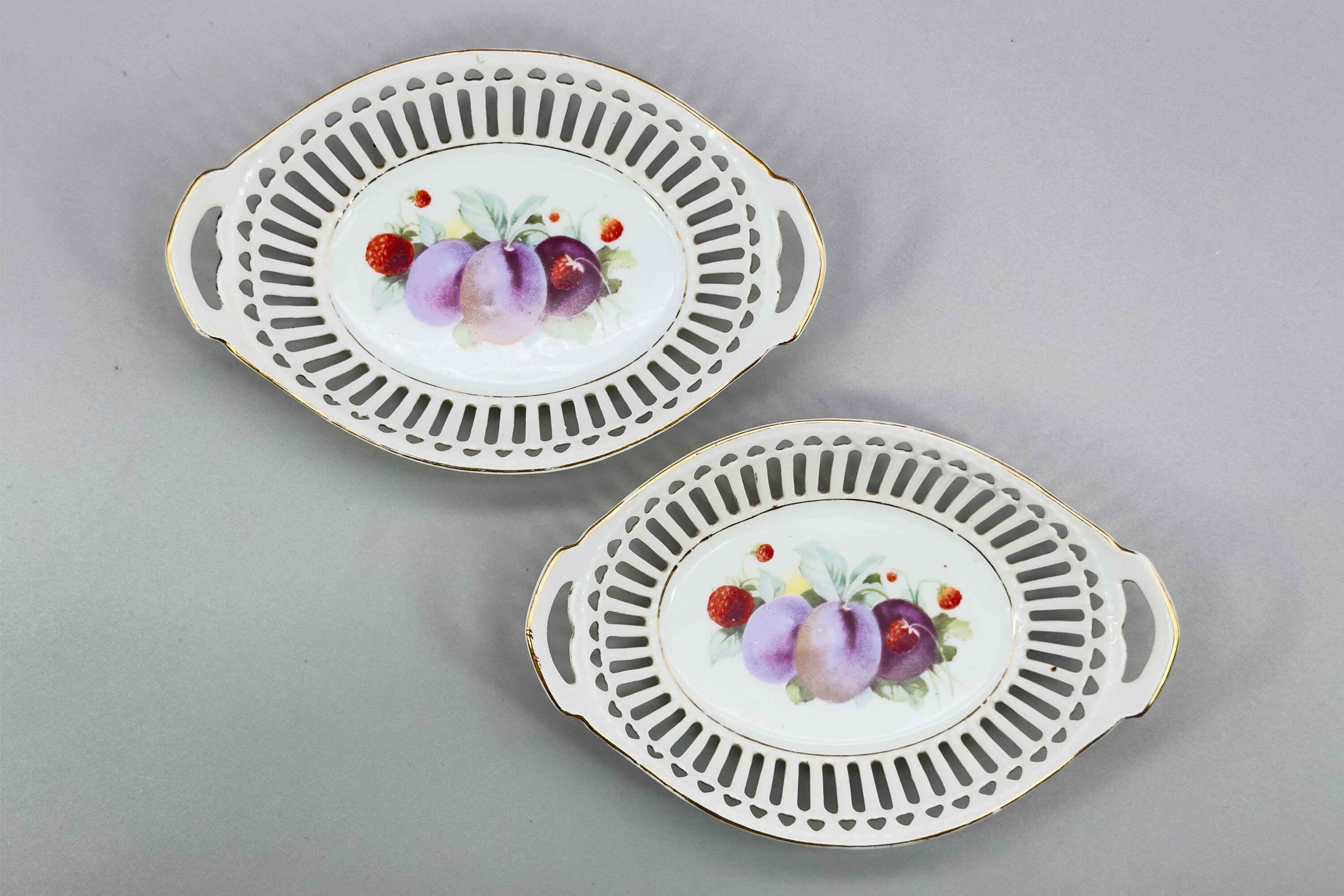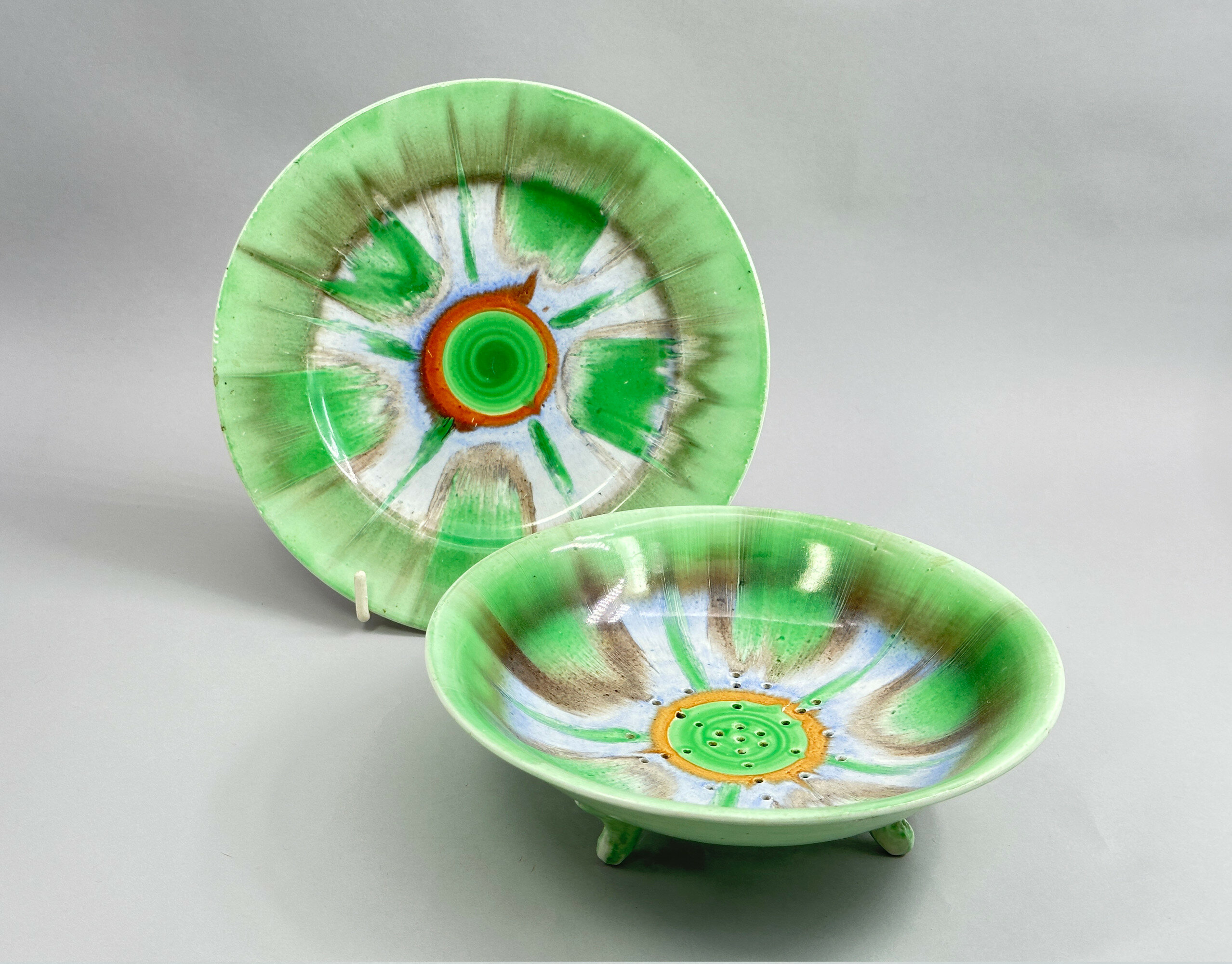
Shelley Harmony Ware Drip Glaze Watercress Bowl and Stand, 1930s
Price: £35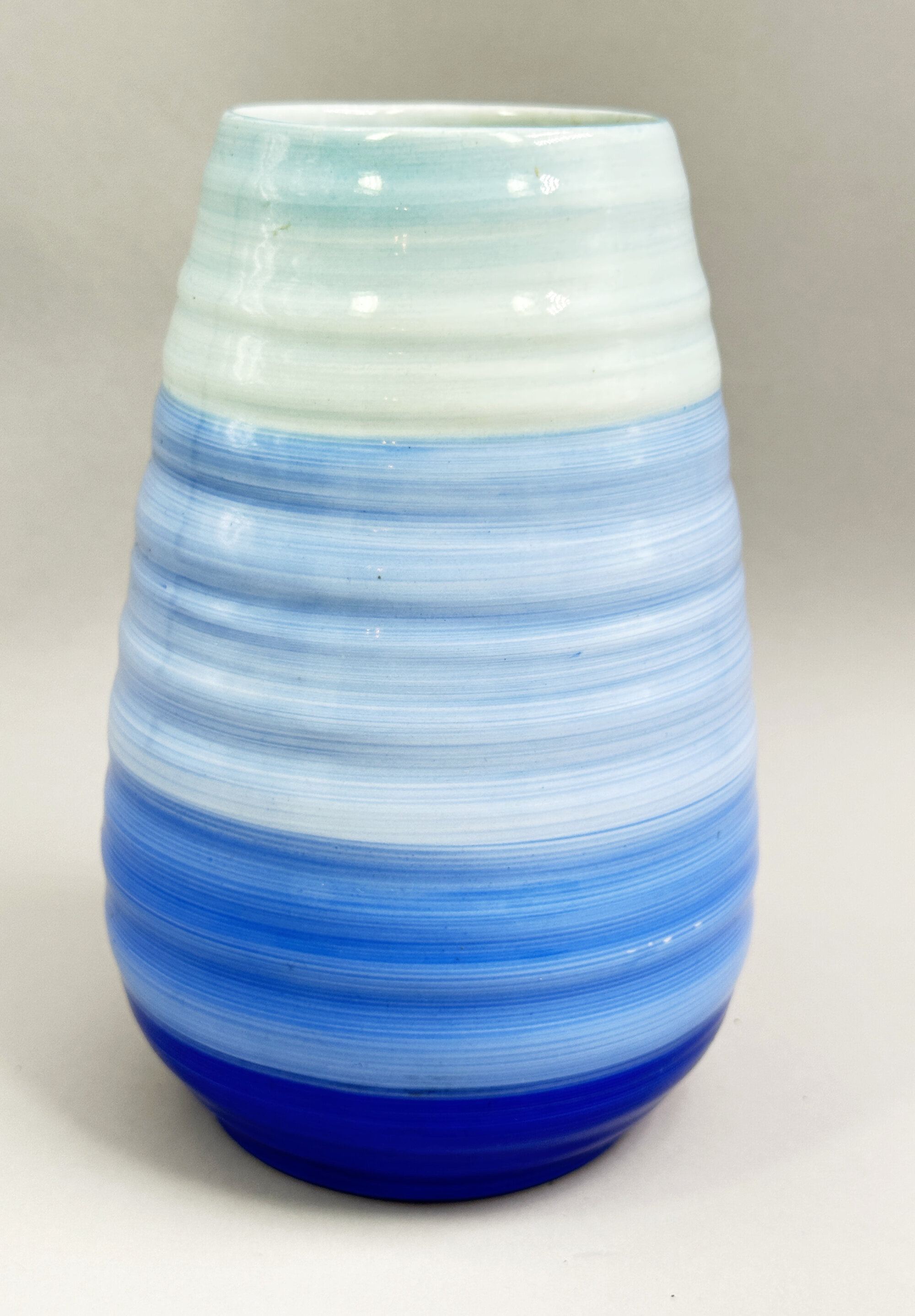
Shelley Harmony Ware Vase glazed in blue, 1930s
Price: £45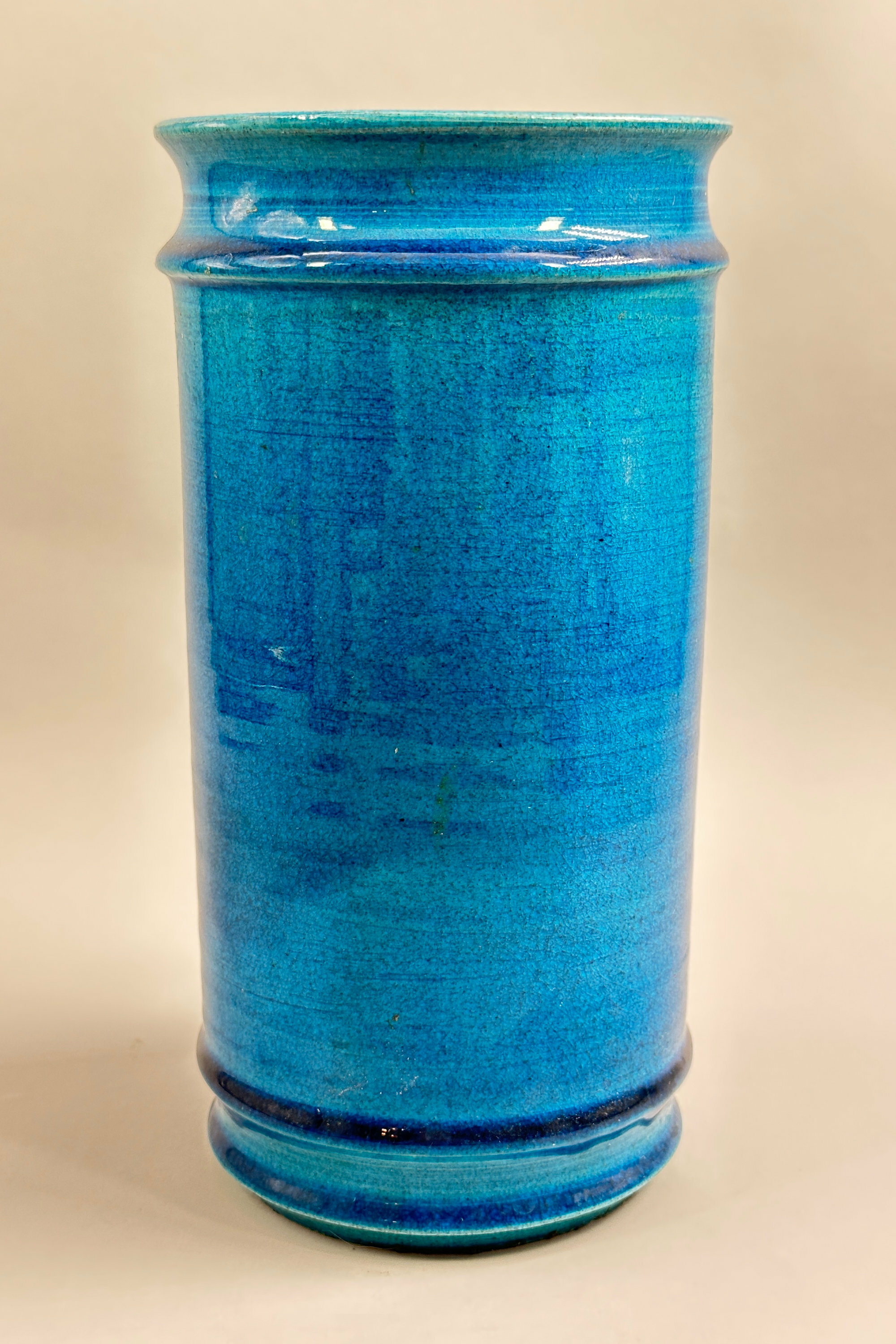
Cylindrical Vase, Herman Kähler, HAK, blue glazed stoneware, 1950s
Price: £250
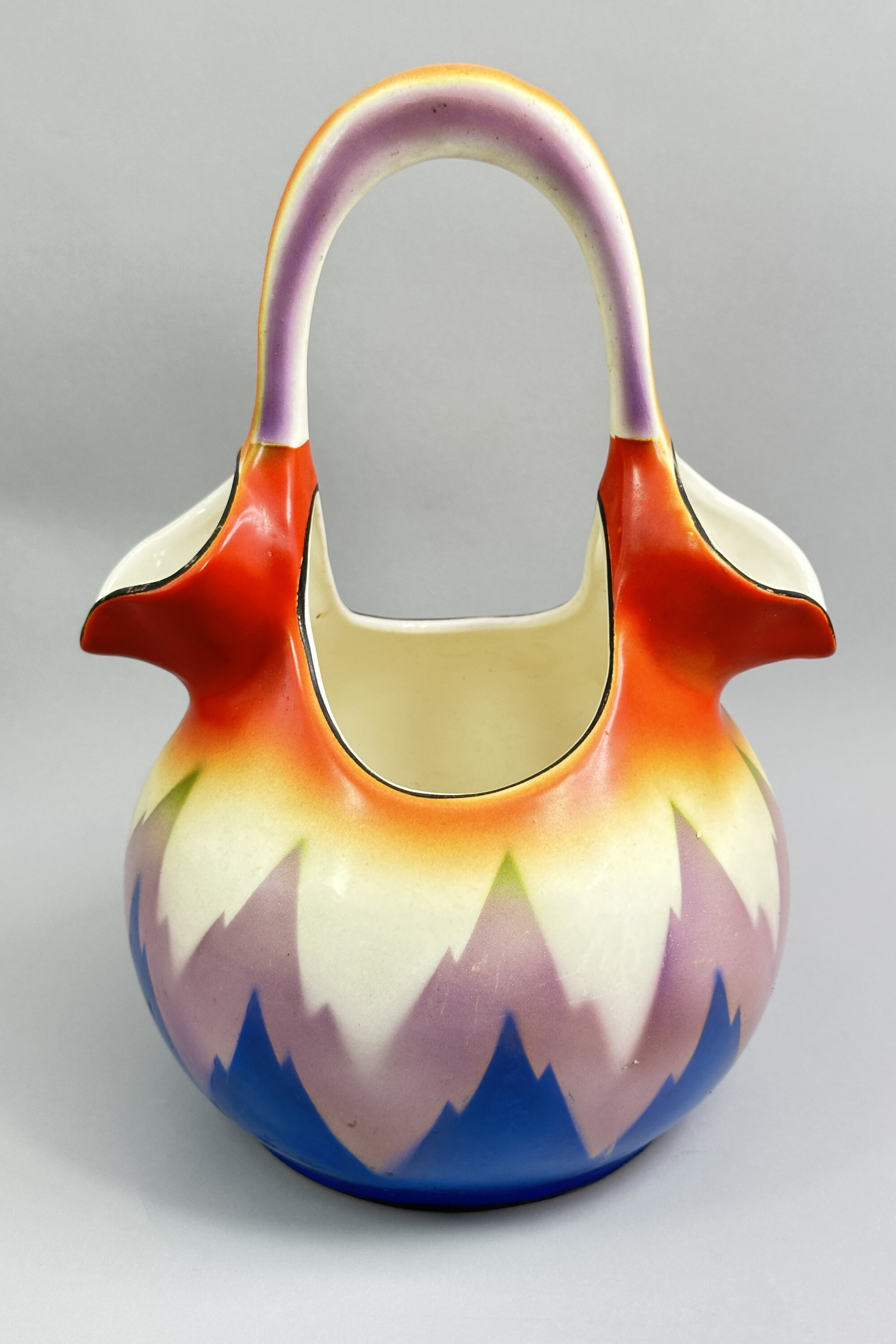
Rare Ditmar Urbach Art Deco Pitcher, Czech 1930s
Price: £250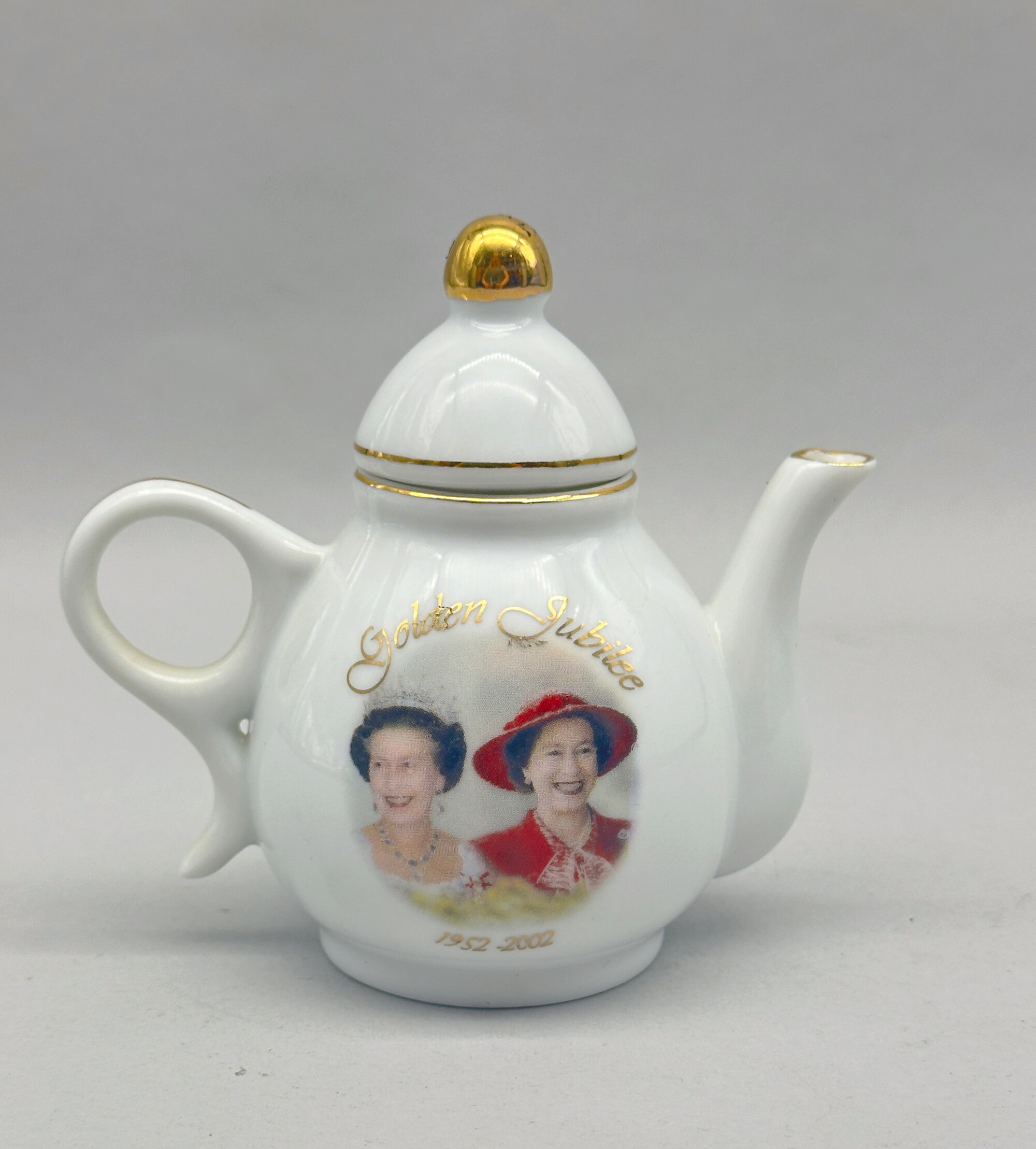
Teapot and Cover : Golden Jubilee Queen Elizabeth II, 2002
Price: £10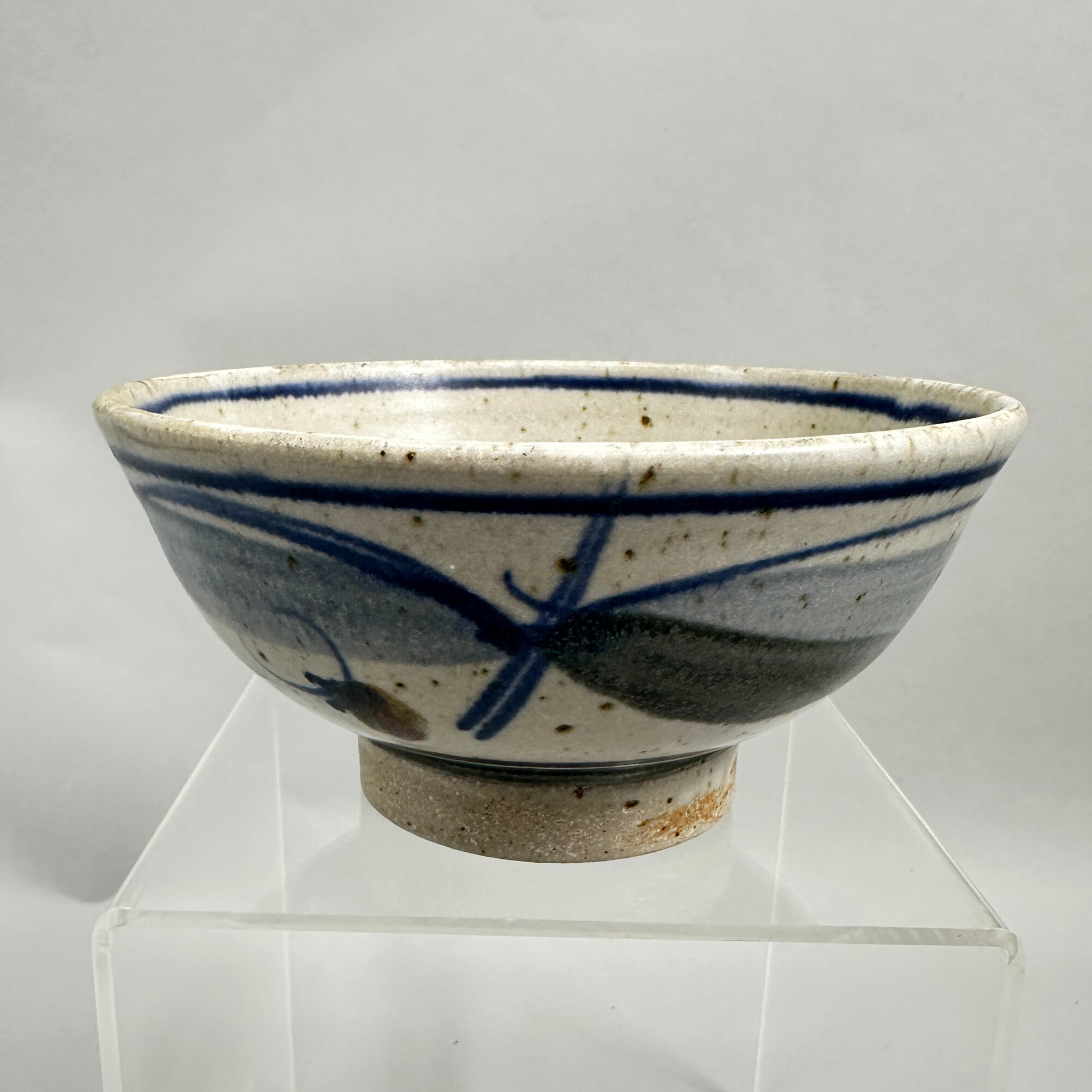
Studio Pottery Bowl, possibly Derek Clarkson (1928-2013) with impressed mark, C20th
Price: £55While it is not absolutely certain the mark on this piece is possibly that of Derek Clarkson (1928-2013). Clarkson trained at the Manchester college of Art between 1944-47 and Burnley School of Art from 1959-61 and then combined a successful lecturing career with the making of his own work which is now to be found in international and private collections including the Victoria and Albert Museum, London. In 1980 he retired from lecturing to focus on his work as a potter, continuing to produce pieces of great skill and attraction until his death in 2013. There are other pieces signed by him which strongly resemble the bowl here (see images 8,9) making it a possibility that this is his work. Certainly, the potter who created this piece and impressed his mark at the bottom was clearly accomplished and this bowl is more than worthy to stand comparison with pieces by more famous contemporaries.
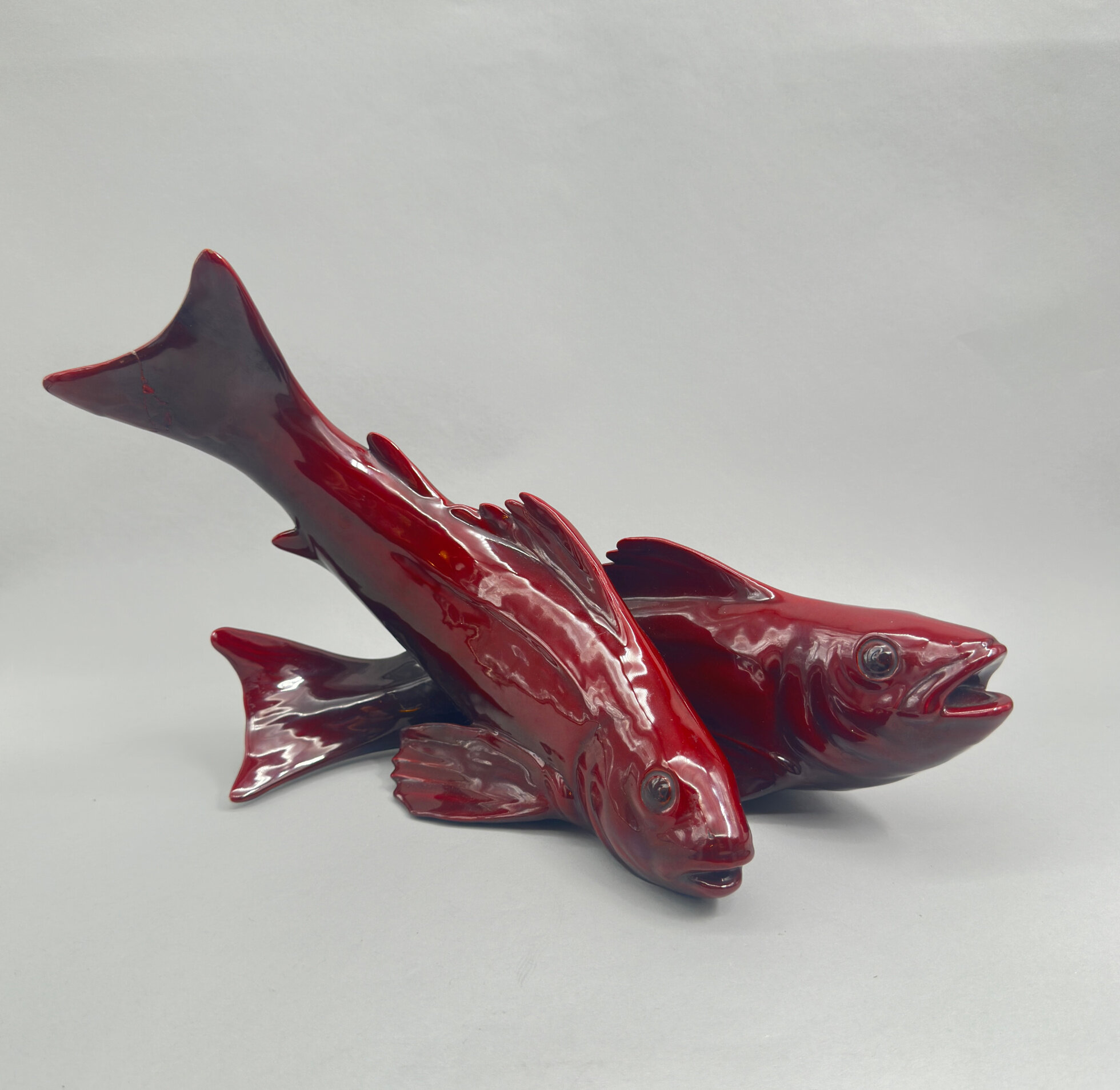
An Art Deco ceramic group of two Fish by Guido Cacciapuoti, signed, 1930s
Price: £150Guido Cacciapuoti was a celebrated Italian ceramicist. Born in Naples in 1892 and from a family with a tradition in the creation of majolica pottery, Guido exhibited his work widely in the 1920s and finally, in collaboration with his brother, Mario, and Angelo Bignami as the administrative and commercial director, he founded the factory ‘Gres d'Arte Cacciapuoti Bignami & C.' in Milan in 1927. Mario unfortunately died three years later leaving Guido to carry on on his own until his death in 1953.
In the 1930s, Guido’s workshop became famous for the production of ceramic animal sculptures with fish being a particular speciality. More commonly seen are groups of John Dory, again with a red glaze, but the smoother lines here and the particularly intense colour reflect more closely the contemporary Art Deco style. Sought after in their own time, with patrons such as the King of Italy and Mussolini, Guido’s works are highly collectible today and this group would make a striking addition to a collection of Art Deco ceramics with considerable decorative appeal.
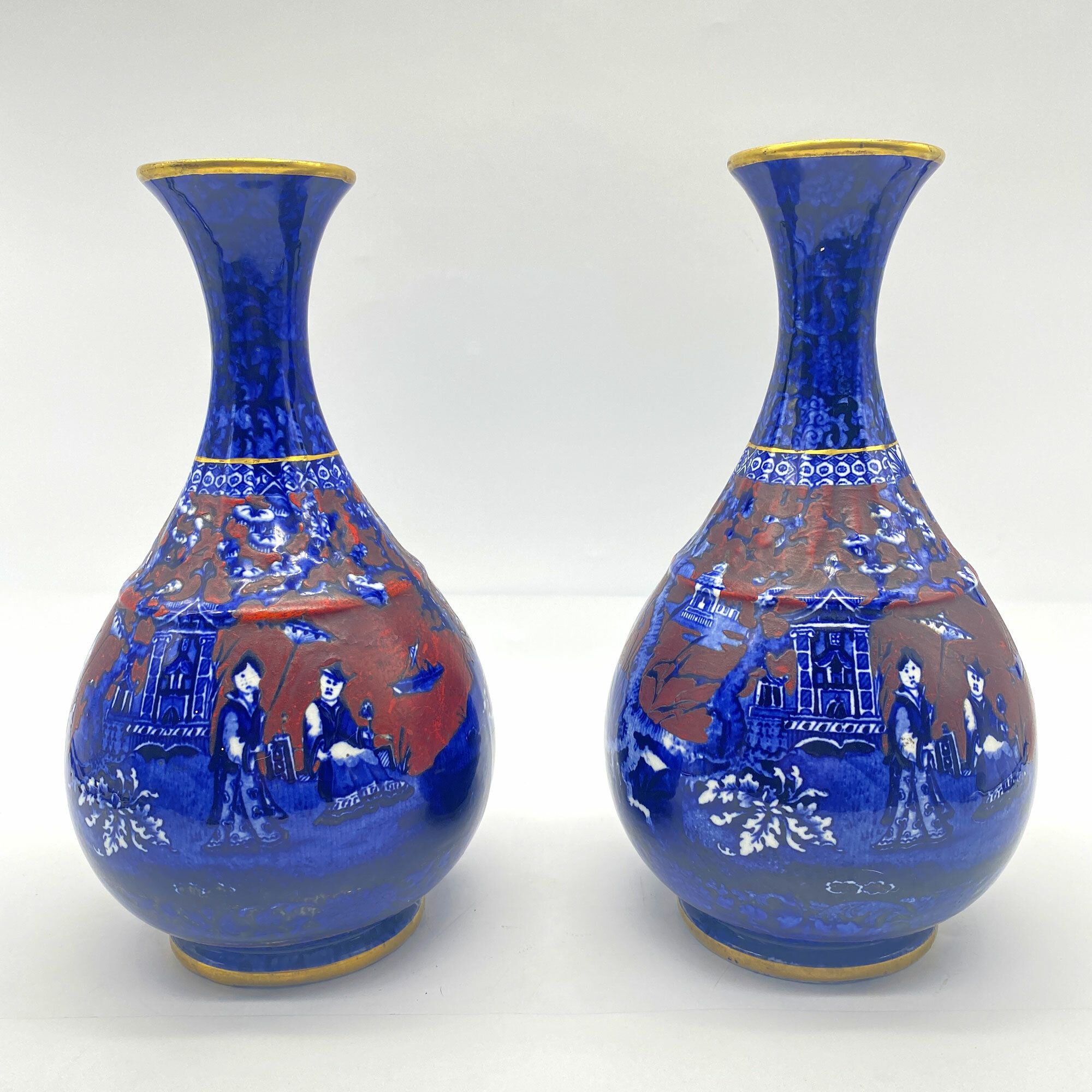
Pair of J Kent Chinoiserie Foley Ware Vases c1920s
Price: £75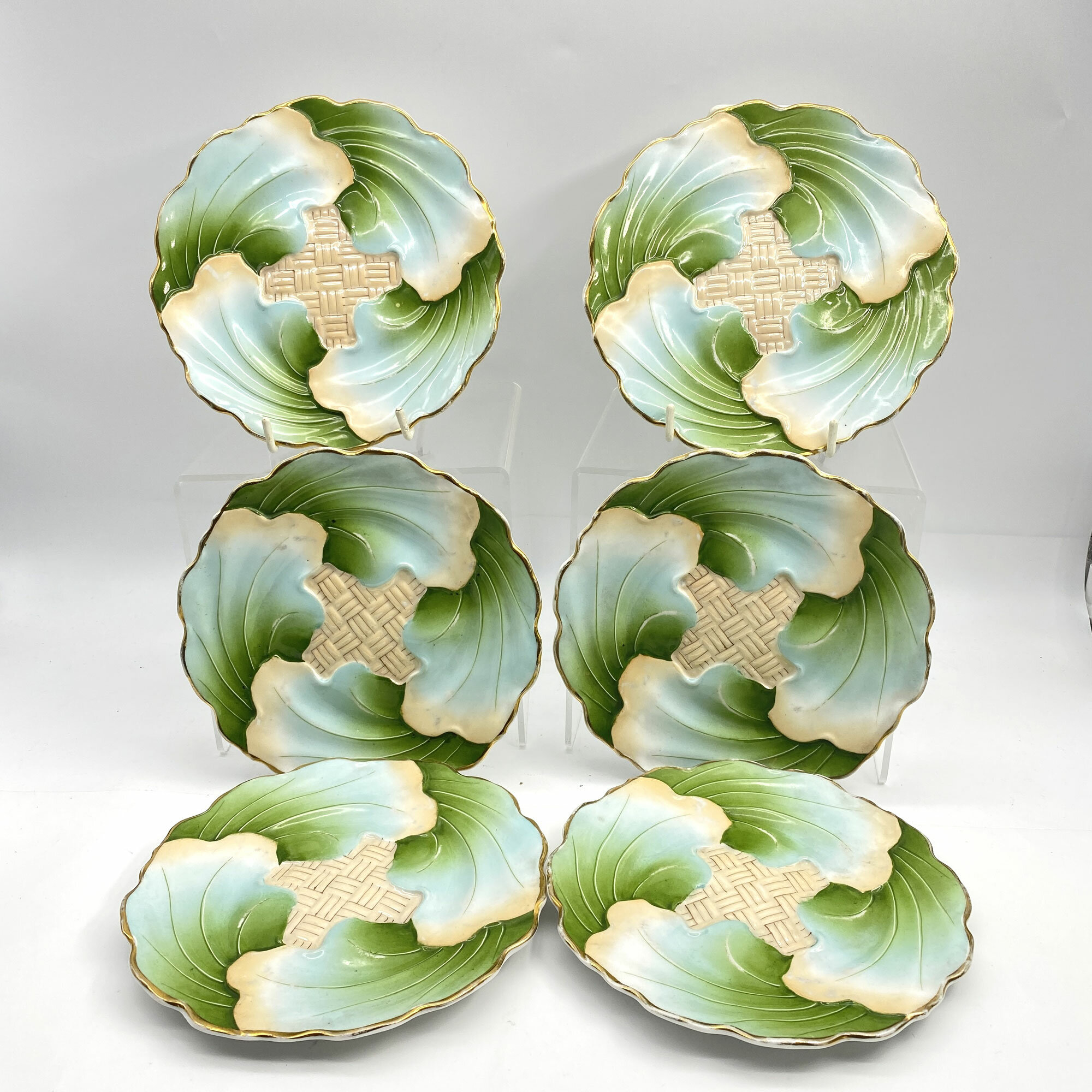
Set of 6 small Art Deco style plates by C.T. Altwasser, Silesia, 1920s/1930s
Price: £75
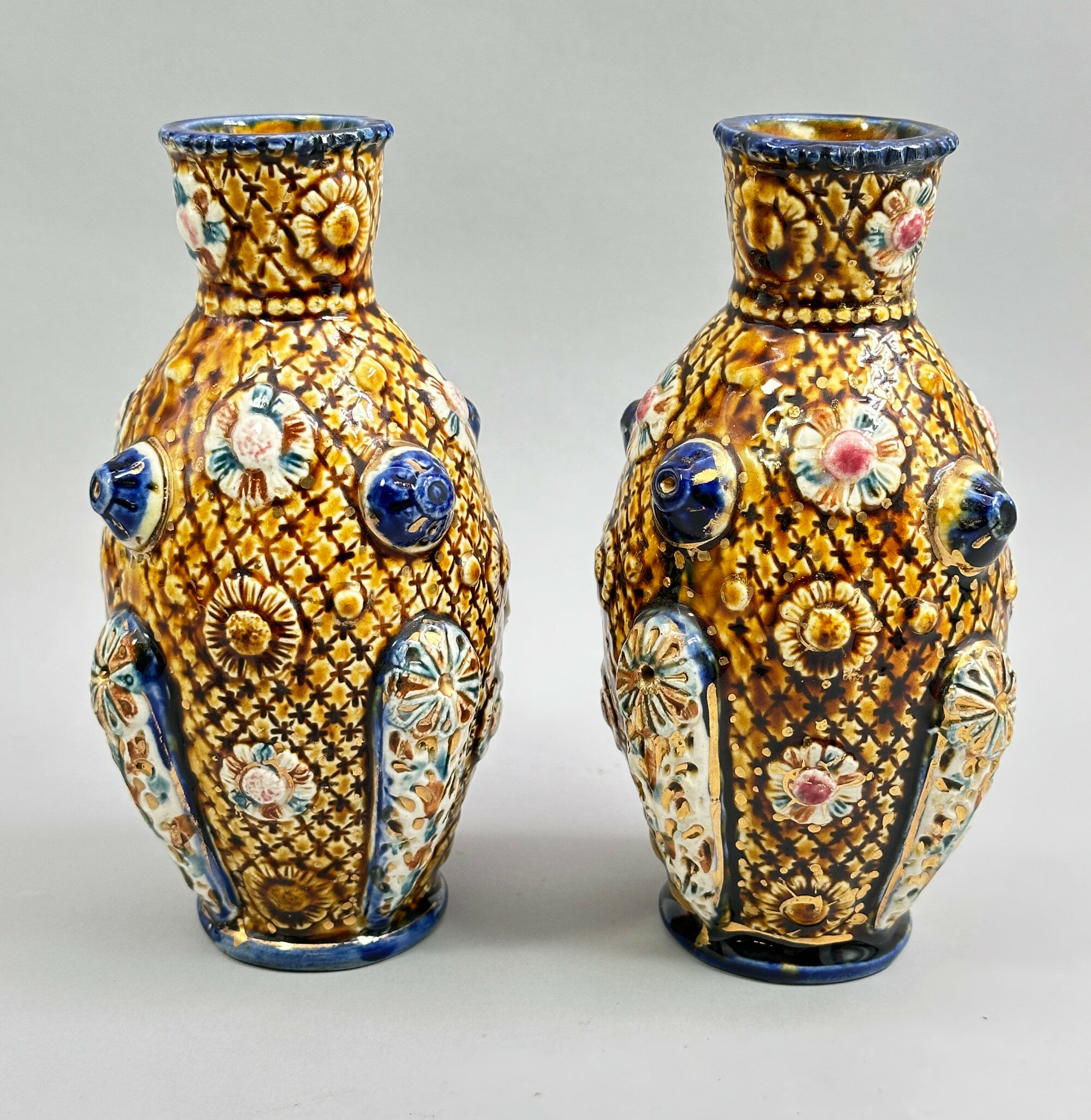
Pair of Alhambrian Ware English Majolica Vases with raised decoration circa 1880
Price: £30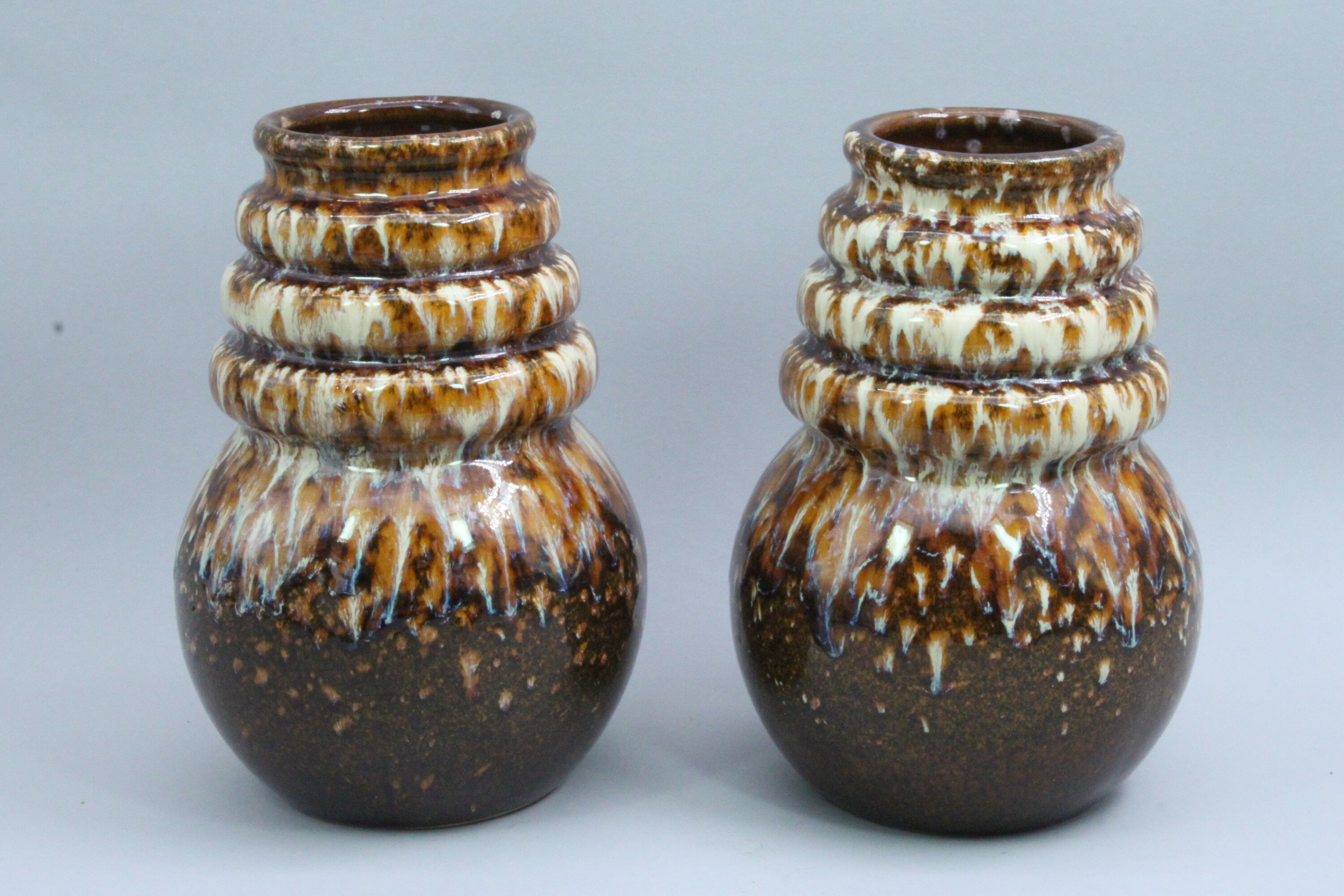
Pair of West German Scheurich Pottery ‘Wien’ Vases, model 269-18, mid 20th Century
Price: £45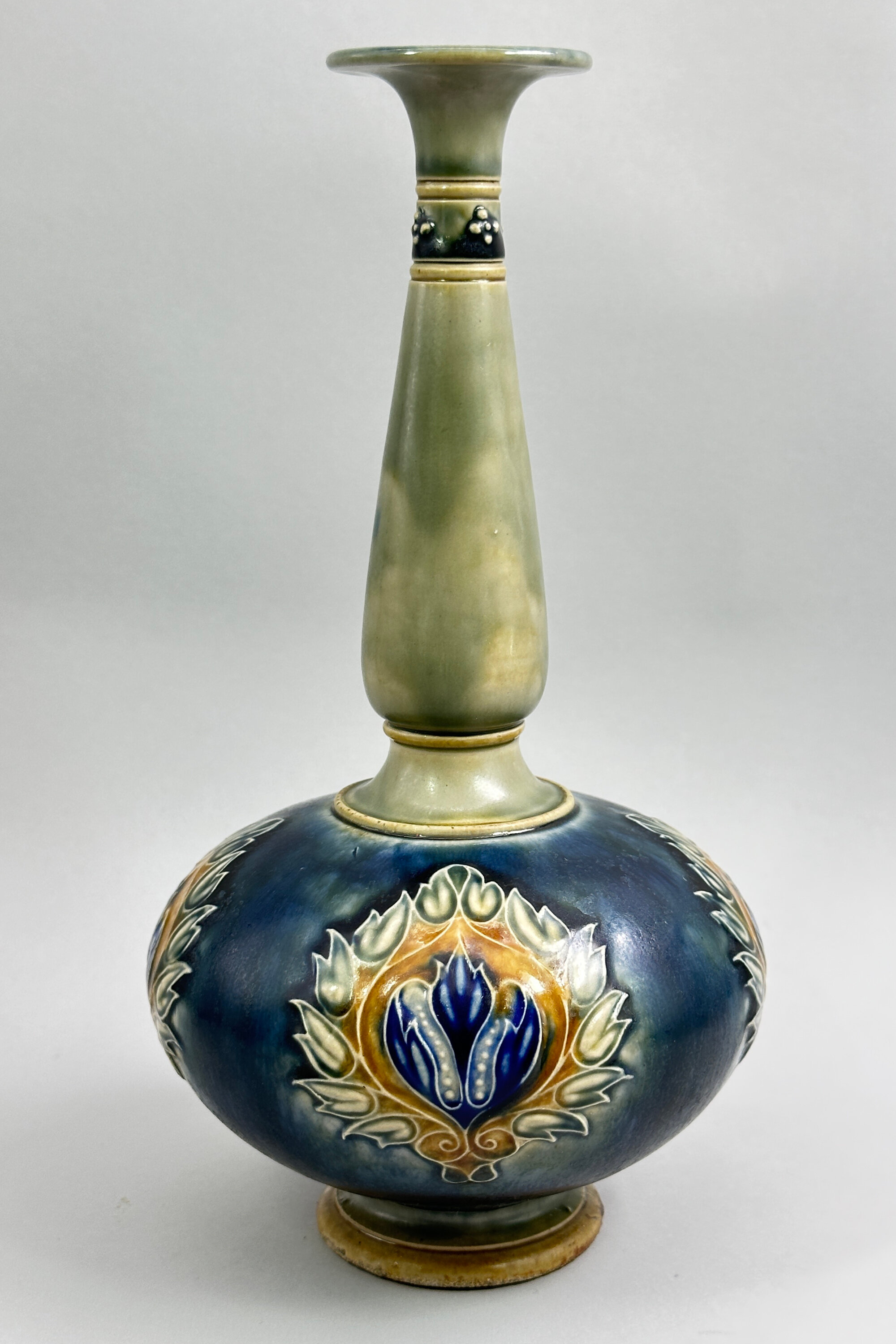
Royal Doulton bottle form Vase decorated with flowering lotus, early 20th Century
Price: £75The Doulton pottery originally had its first factory in Lambeth, London. Set up in 1815 by John Doulton, who is rumoured to have spent his life savings of £100 in starting the business, the firm concentrated on making pipes and utilitarian works. But in the 1880s the Company moved to Staffordshire and began making fine bone china tableware and decorative items. The pottery was located in Burslem, Stoke-on-Trent and has manufactured high quality ceramics and porcelains ever since, receiving a Royal Warrant in 1901.
This piece is typical of the glazed pottery pieces made in the late nineteenth and early twentieth centuries. A muted palette of colours was used and a variety of forms created with many artists taking a hand in the decoration. Most of the pieces are signed, as here. The pattern number indicates a date after 1894, but the Royal Warrant mark means a dating in the early 1900s. Perhaps a timing in the Edwardian era (1901-1910) is the most likely.
This vase is an excellent example of the creative designs which Doulton produced. As often, there is a slight Oriental influence but the style and design are unmistakeable.
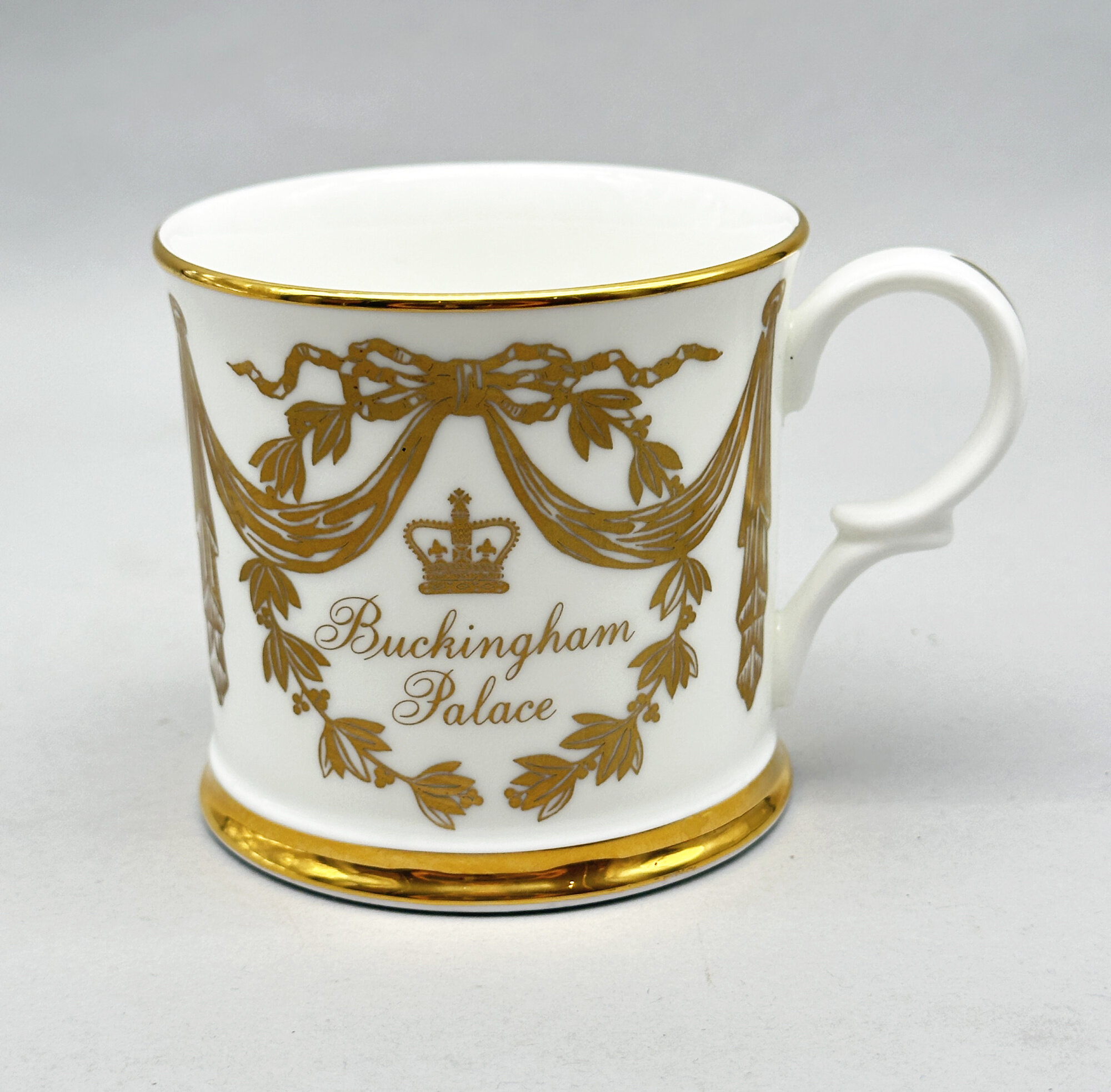
Porcelain Mug : Buckingham Palace 1997
Price: £10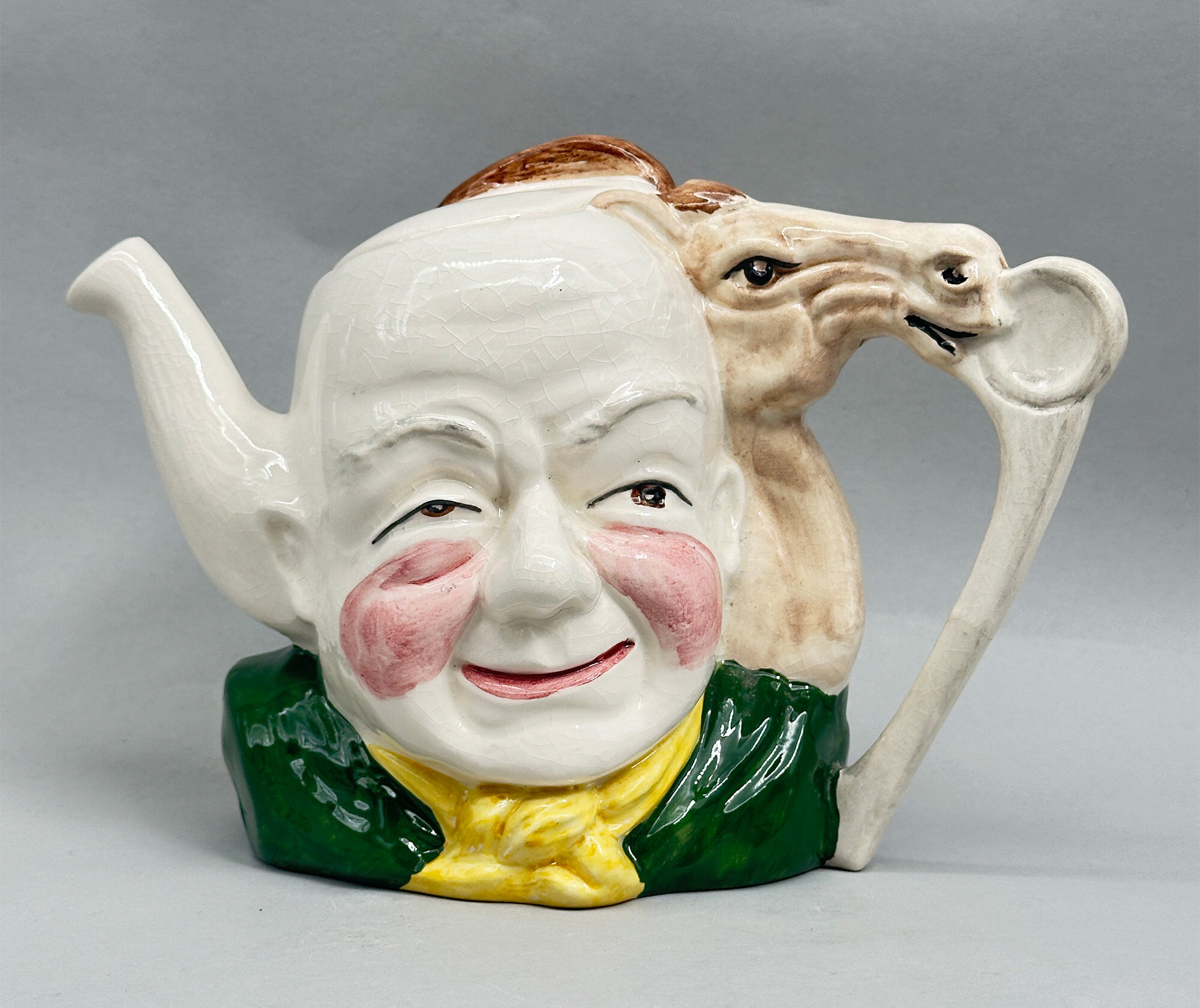
Crown Winsor Jockey Teapot, 1980s
Price: £35Crown Winsor was a short lived earthenware manufacturer at the Sylvan Works, Longton, Stoke-on-Trent, England, previously the premises of the firm Shaw and Copestake, who traded under the well known name ‘SylvaC’ and went into voluntary liquidation in 1982. A workers co-operative trading under the name of Longton Ceramics attempted to take the business over but with little success and eighteen months later the enterprise was fully taken over by United Co-operative Society and run under the name of Crown Winsor. The Co-operative society already owned the Windsor Pottery works and the Crown Clarence Pottery works which was the source of the ‘Crown Winsor’ name. Production centred on whimsical and novelty items, sometimes made from the old SylvaC moulds but demand proved weak and the business ceased trading in 1989. This teapot is typical of their range and the elaborate cipher underneath seems to read ‘CW’ grandly announcing a trade name which unfortunately had a very short life
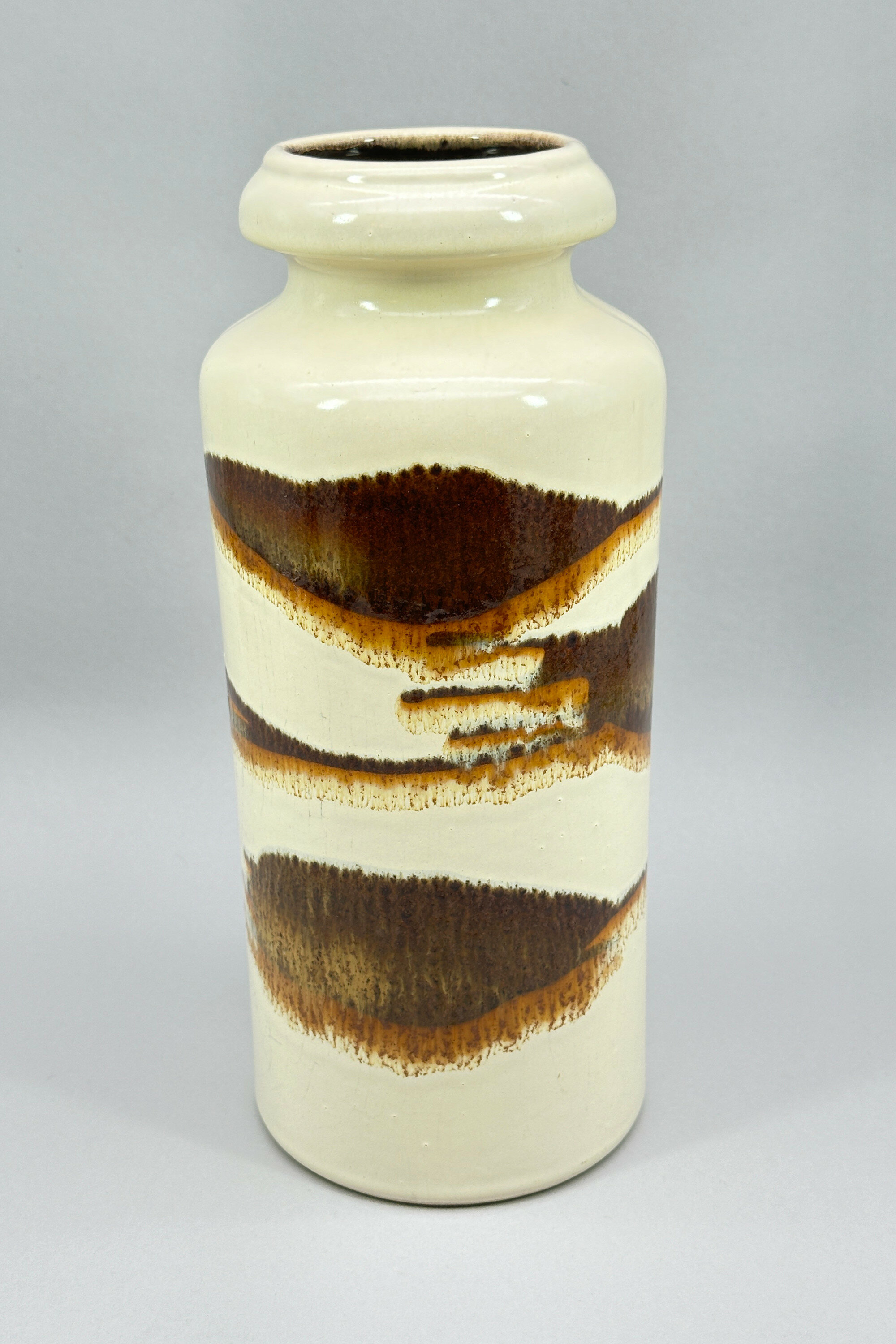
West German Vase with drip glaze decoration, Scheurich, 1960s
Price: £45Although not marked as such, this vase has all the hallmarks of the firm Scheurich Keramik which started production in 1954, rather later than most of its competitors, but soon became the largest producer of commercial art pottery in Germany. Their pieces rarely carried the factory name but usually the model number followed by the height in centimetres with ‘W-Germany’ below, as here. Model ‘517’ can be found in a variety of different glazes but the colourings here with the contrast between browns and cream are particularly successful. Dating is to the 1960s.
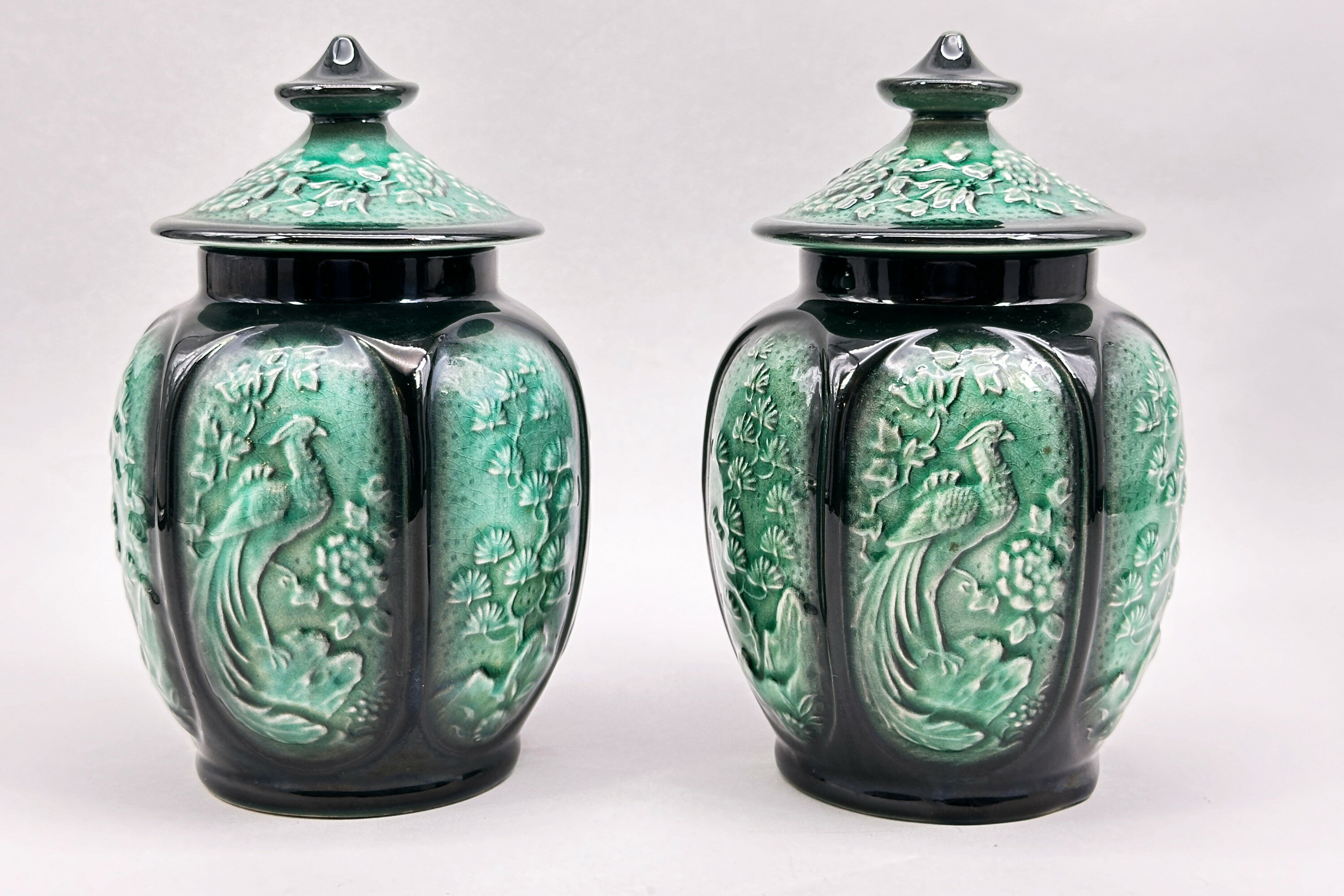
Pair of Oriental Style green glazed Sylvac Jars and Covers, circa 1960
Price: £95‘SylvaC’ (the name was written with a capital ‘C’ after registration of the trademark in 1938) was a trade name of Shaw and Copestake, a company formed by Mr. William Shaw and a Mr. Copestake around 1900. Mr. Copestake sold his shares to a Mr. Richard Hull after about six months of business and this partnership continued until Mr. Hull’s death in 1935. He was succeeded by his son, Mr. Richard Hull junior. In the following year, the business became a limited company. Various mergers and acquisitions followed and in the 1950s new premises were built and production expanded considerably continuing until the early 1980s when changing markets and increased competition forced the company into liquidation.
Sylvac were known for imaginative glazed wares, particularly animals, but this design with its reminiscences of the Orient in both form and decoration is rather more unusual and particularly pleasing. These jars were produced in a variety of colours but the combination here of green and black, loosely recalling Chinese ‘Famille Noire’, is probably the most successful.
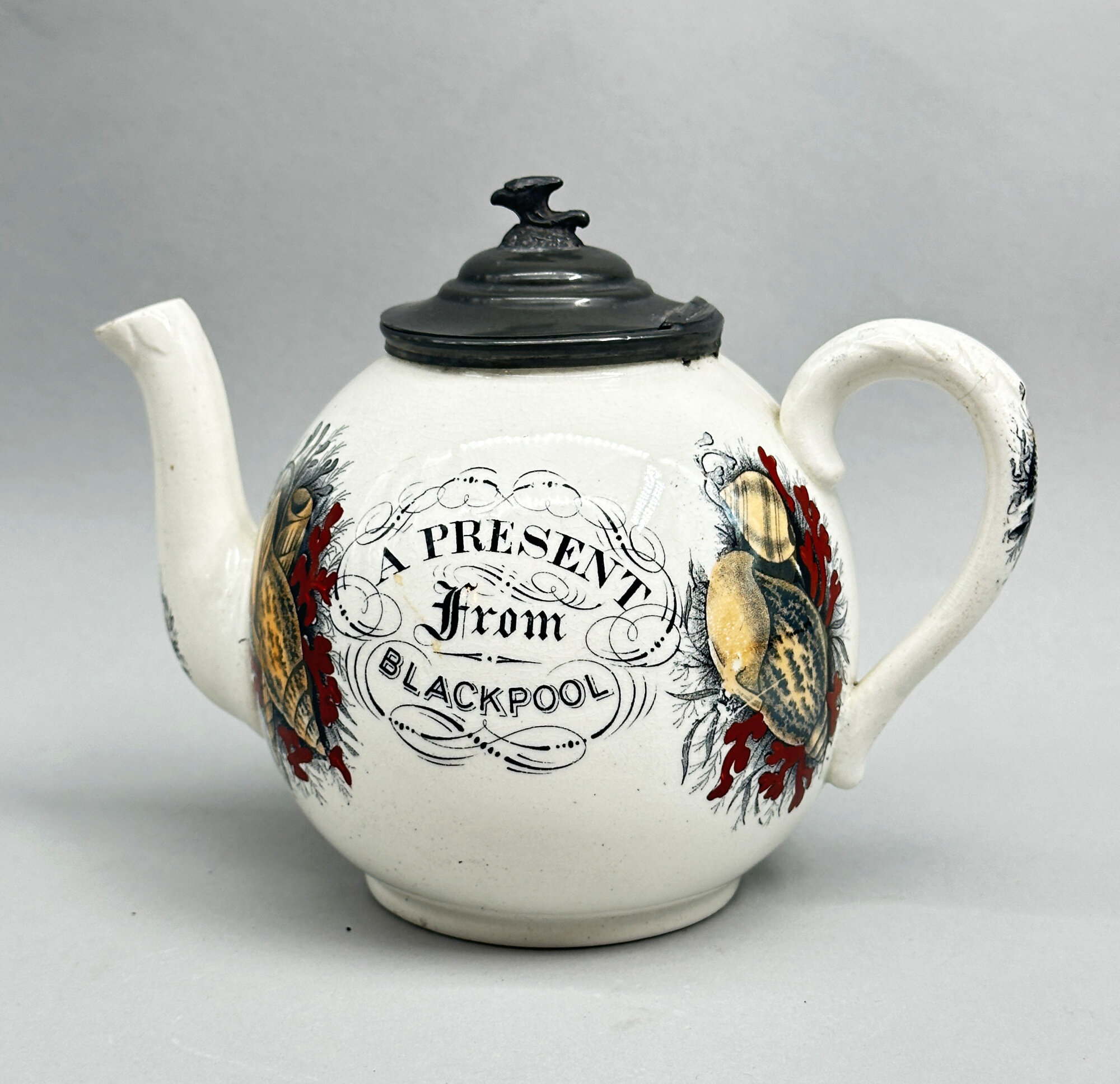
Blackpool souvenir teapot c1920
Price: £35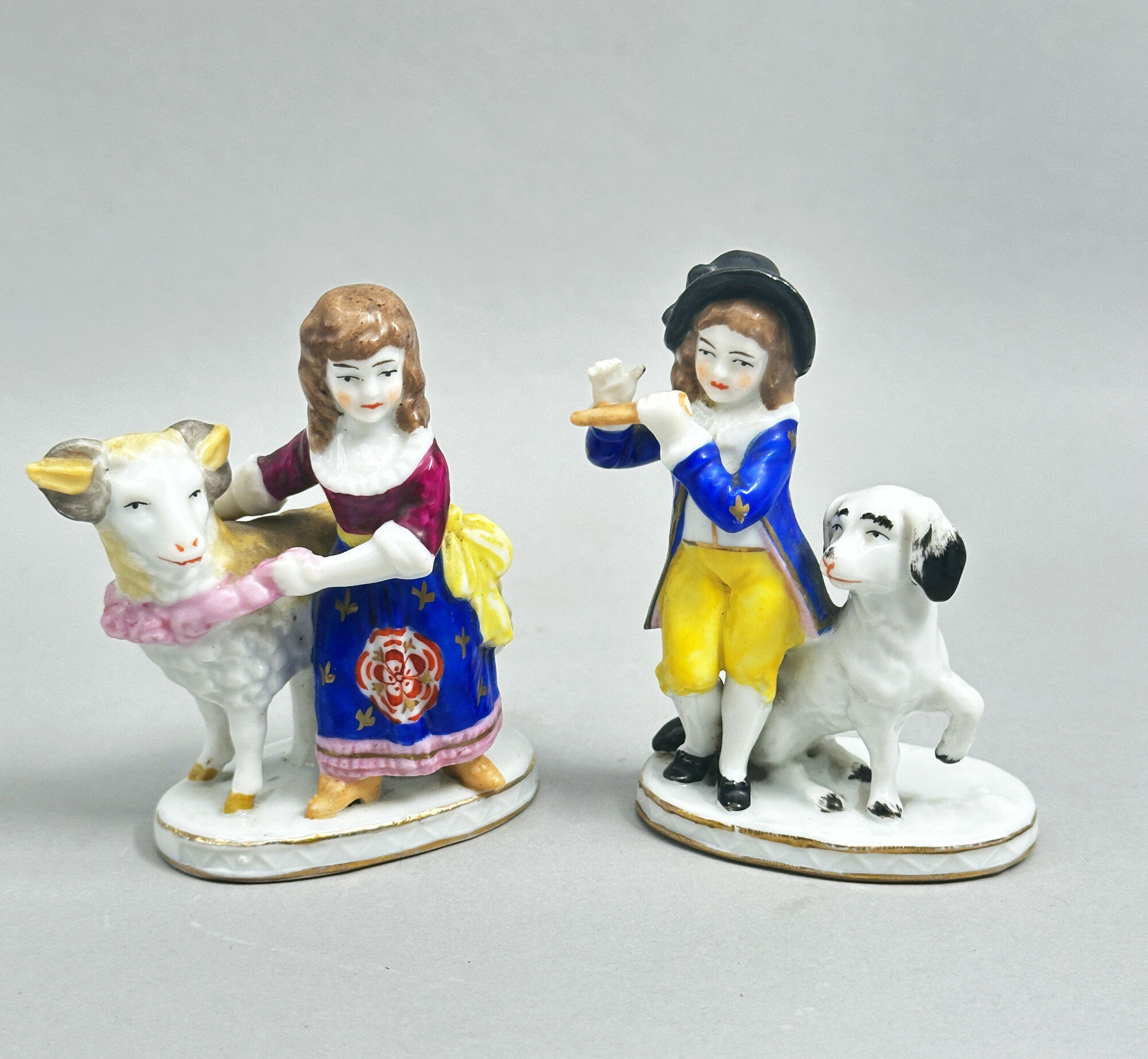
Pair of Chelsea style Figures of a Country Couple, probably Samson late C19th
Price: £55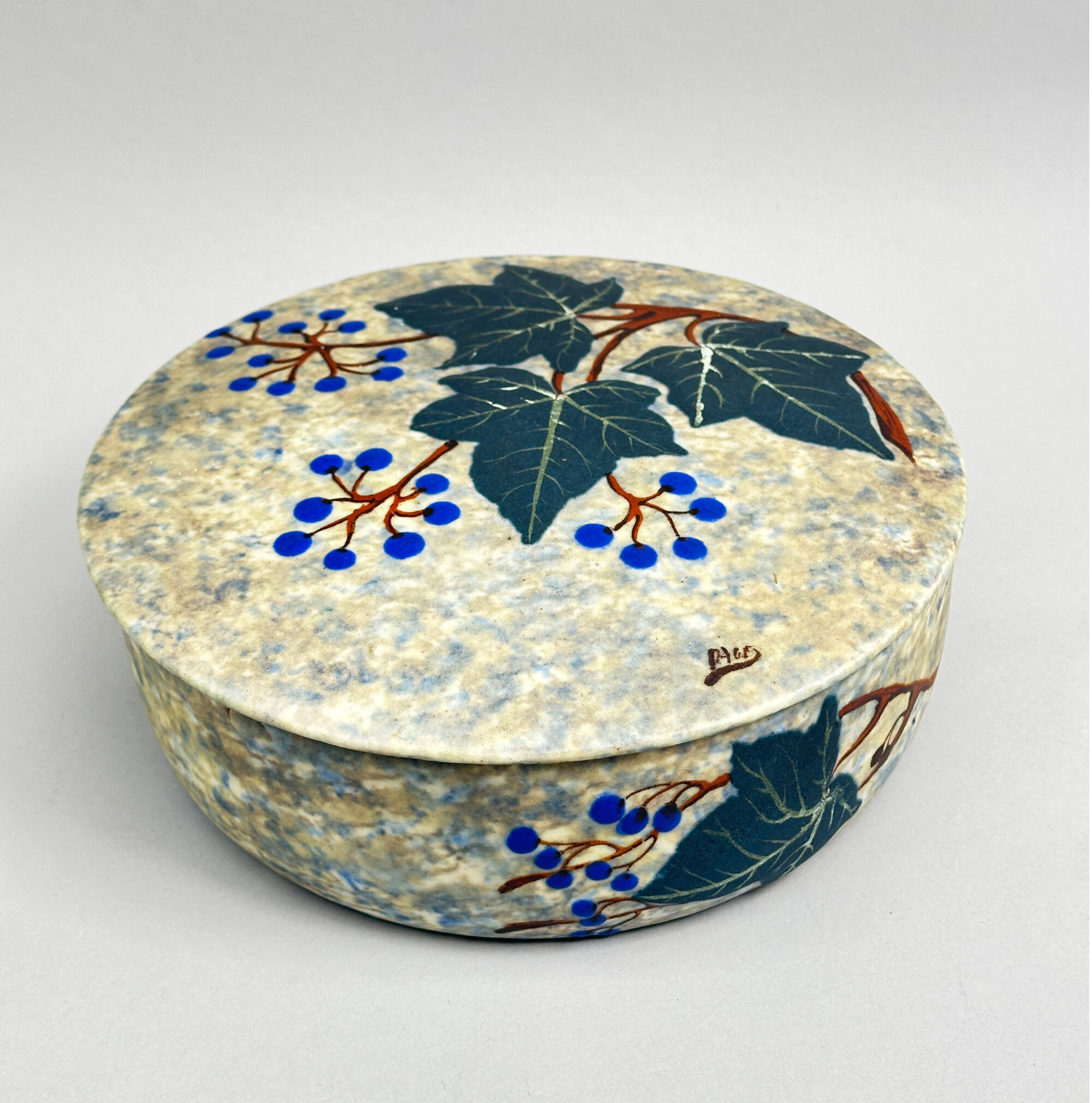
Art Deco style Ceramic Bowl and Cover by Louis Dage (1885-1961), early/mid C20th
Price: £180……………………………………………………………………………………....................................................................................……
Born in 1885 at Lille, France, Louis Dage was early known as a ceramics artist, describing himself on the birth registration of his daughter in 1906 as a ‘decorator on faience’. In 1920 he joined with Louis Fontinelle (1886-1964) to create a faience factory in Antony, near Paris, but the venture was short lived and they parted company two years later. In 1930, Dage set up his own studio at Saint-Sever in company with his brother and daughter becoming managing director of the firm three years later. There then followed a little over thirty years of production under his direction until his death in 1961. Art Deco designs with their simple lines and bold decoration were produced initially to be followed by pieces of more rugged shapes and patterns, partly resulting from the shortage of conventional raw materials during the second world war.
This bowl and cover represents the best of Dage’s earlier work. The base has straight sides curving in slightly towards the base and has a flush fitting flat and gently domed cover overhanging slightly at the edge. The piece is covered overall with a mottled glaze in tones of blue and light aubergine on which are painted maple leaves in green with bright blue berries, a design which can be found on some of Dage’s other pieces (see image 13). The lid carries his signature ‘DAGE’ with a flowing line underneath, a much less common version of the Dage mark but which can be found elsewhere (see image 14). More normally pieces are signed ‘L.Dage’, the name being in lower case rather than capitals.Form and decoration combine to produce a striking object, characteristic of the fashions of the time of its production and a worthy tribute to its maker.
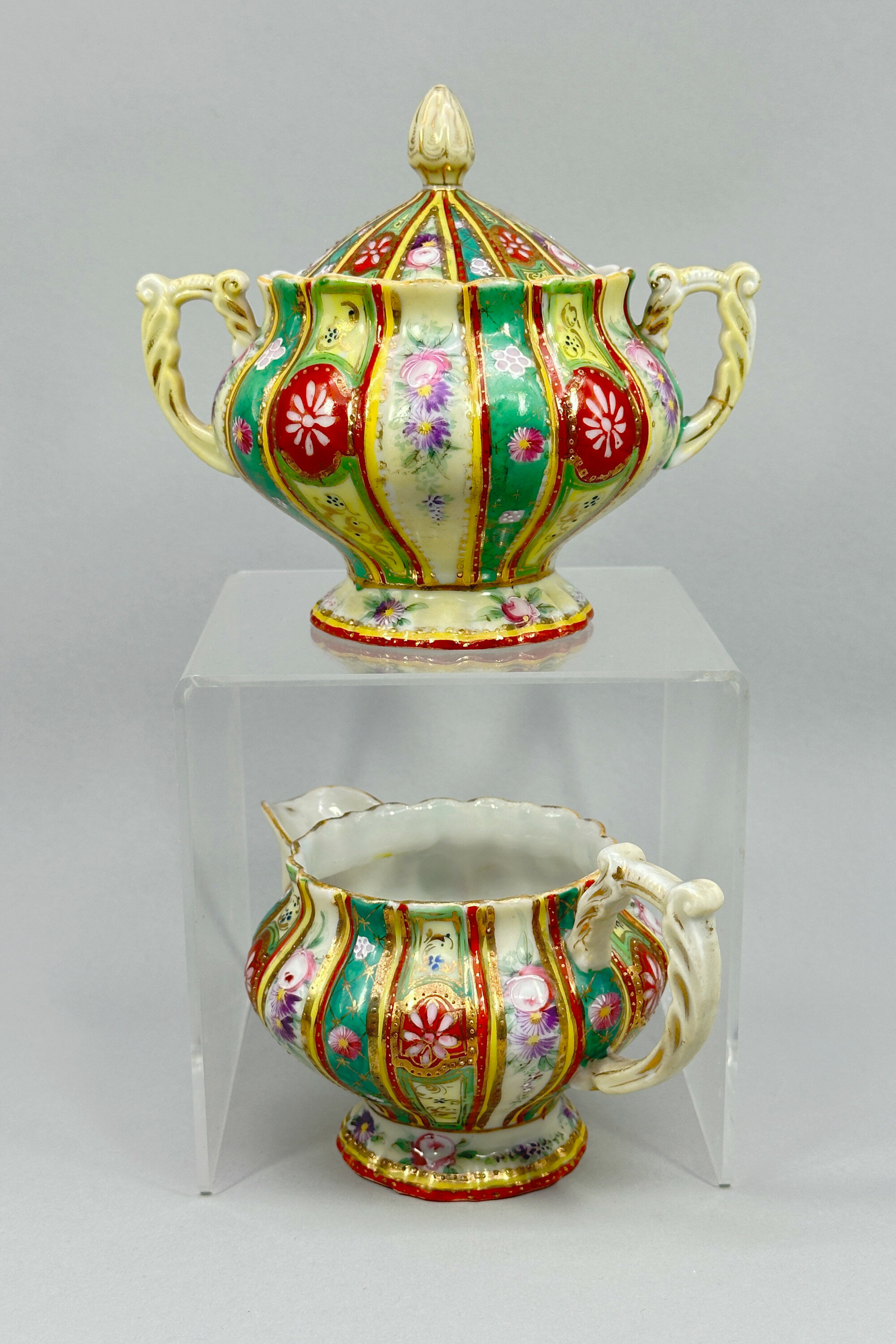
Vintage floral decorated Sugar Bowl and Cream Jug, probably Bohemian mid C20th
Price: £25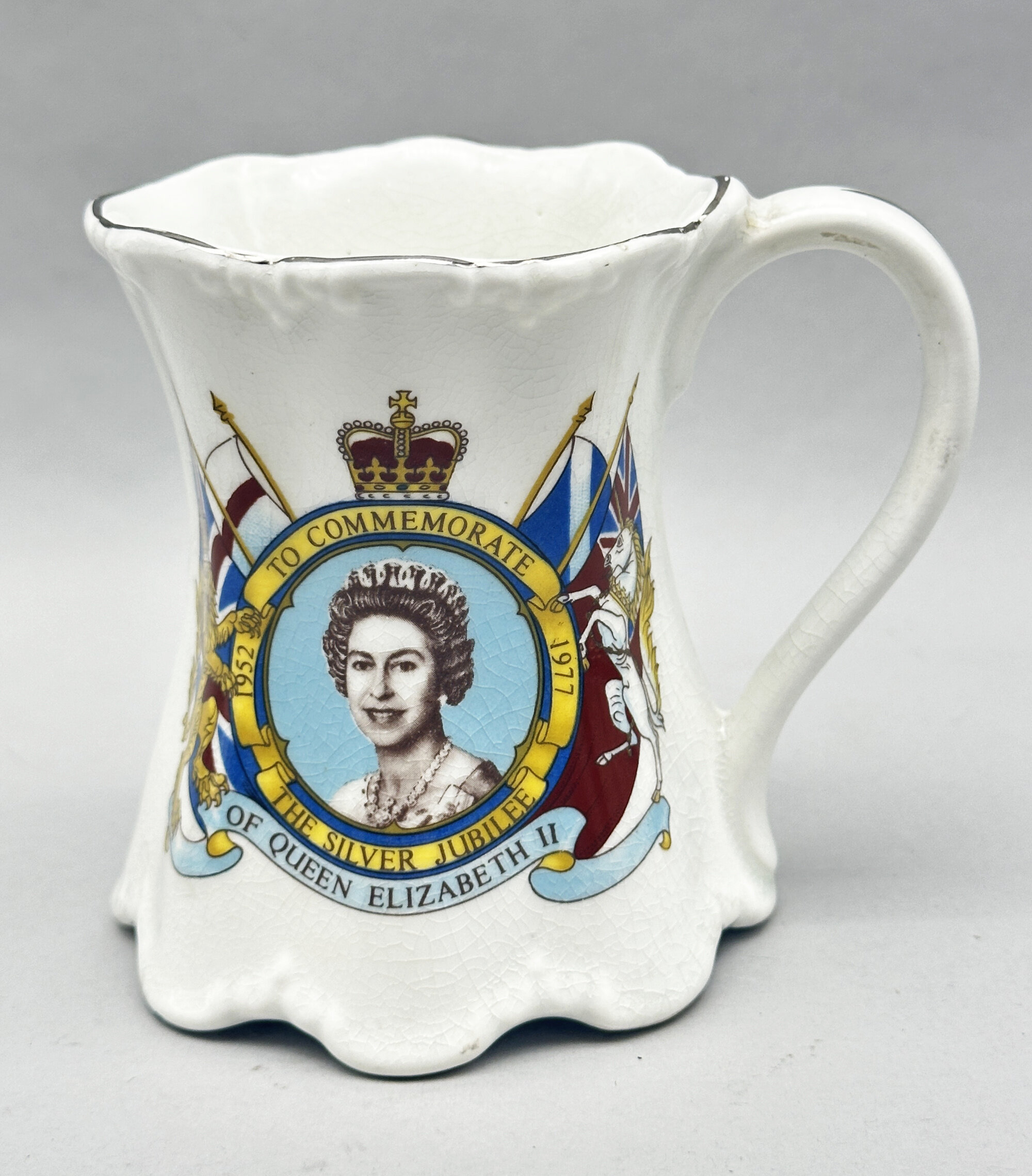
Queen Elizabeth II Silver Jubilee China Mug, 1977
Price: £10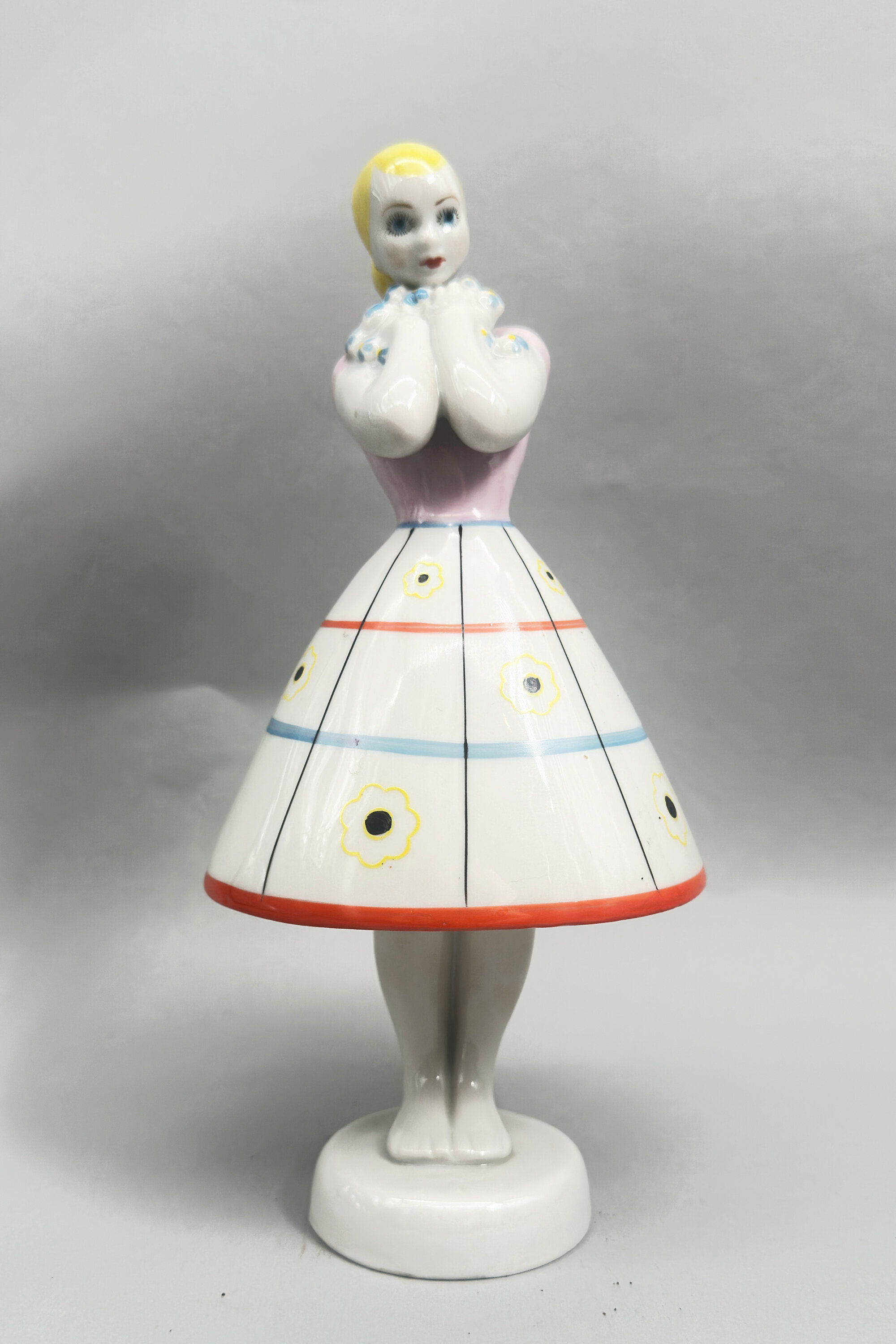
Figurine of a girl, Baranivka Ukraine, 1950s
Price: £55The Baranivka Porcelain Factory, one of Ukraine's oldest porcelain manufacturers, was founded in 1802-1804 by Mykhailo Mezer. Situated at Baranivka, at the time in Poland but now part of Ukraine, the factory was considerably assisted in its development by the discovery of rich clay deposits in the area. Production was continuous even during the Soviet era until the early twenty first century. Both the angular modelling and the abstract decoration of this piece point to a dating in the 1950s when production would have revived after the second world war and more contemporary styles adopted.
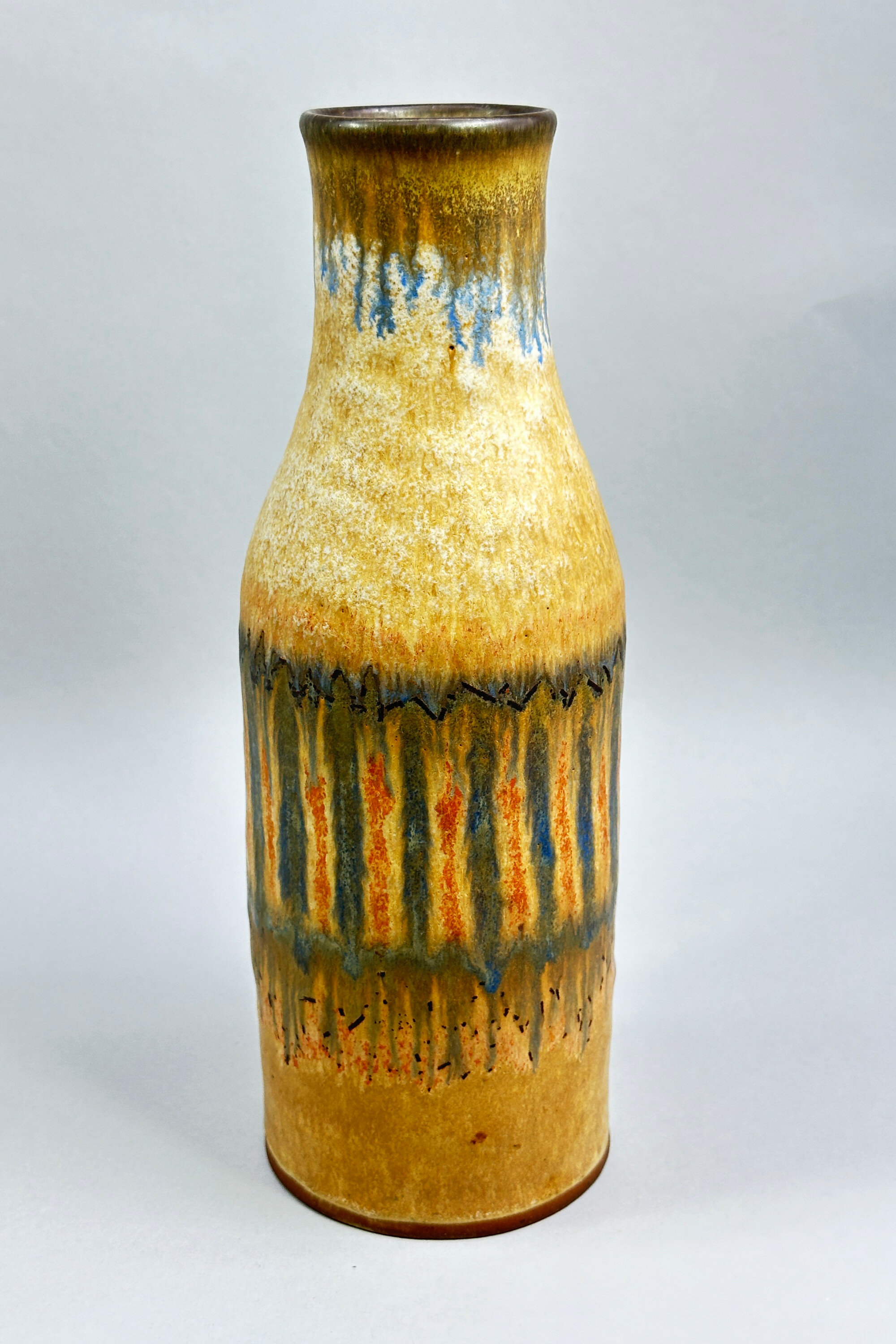
Studio Pottery Vase signed Kamini, Greece, 1970s
Price: £45Although ‘Kamini’ is both the Greek word for a kiln and the name of a village on the Greek island of Hydra, it actually stands here for the Greek firm of that name whose registered office was at Kallithea, a suburb of Athens. The Kamini pottery produced a wide range of appealing but often slightly rustic wares in the 1970s, many with the splash glaze effects we see here and all stamped with the firm’s name. This vase stands out somewhat for the simple lines of its form and the variety of effects in its decoration with a particularly pleasing palette of colours and demonstrates that this Mediterranean pottery could well rival at times the work of some of its European competitors.
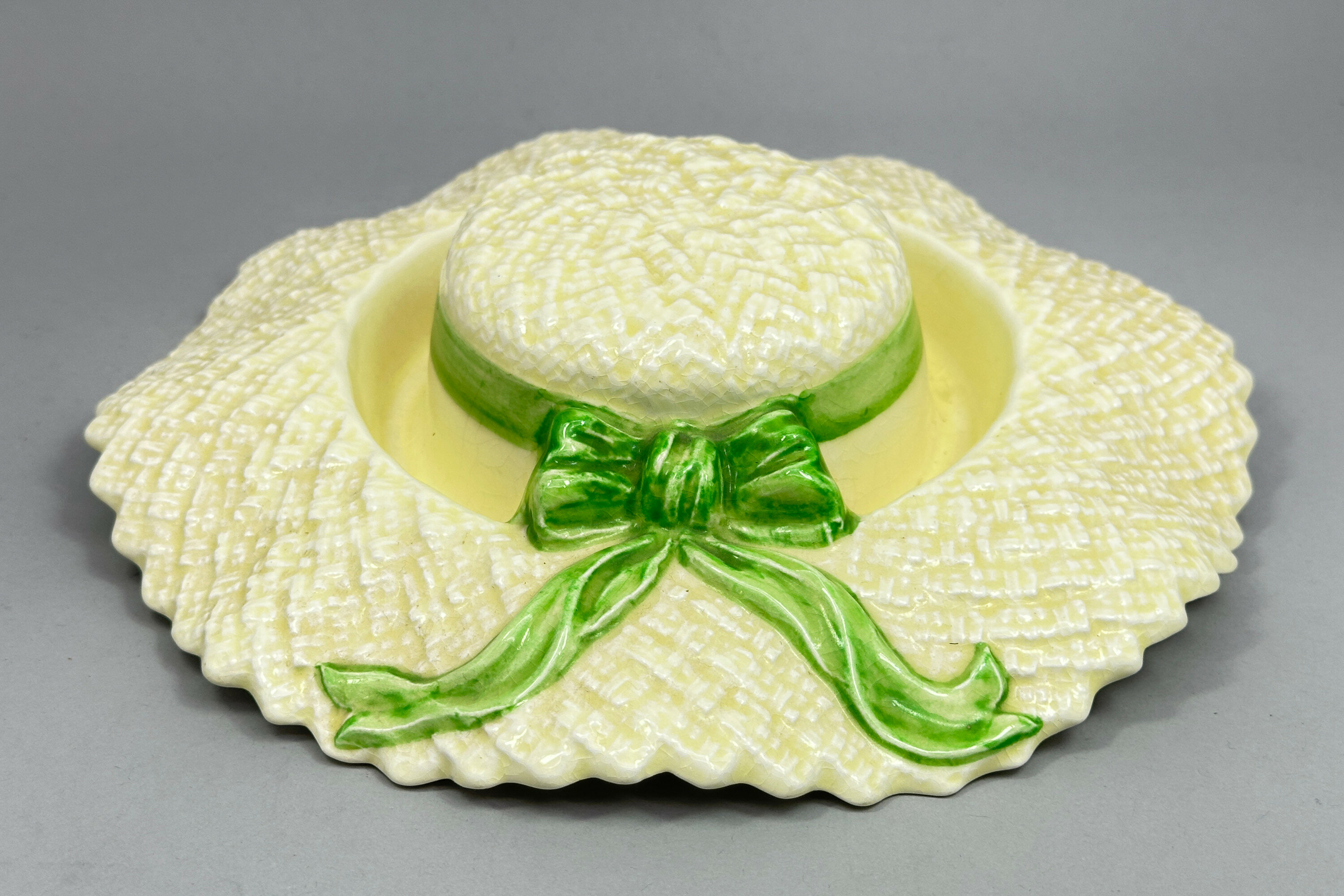
Novelty Bonnet Posy Vase, 1940s/1950s
Price: £25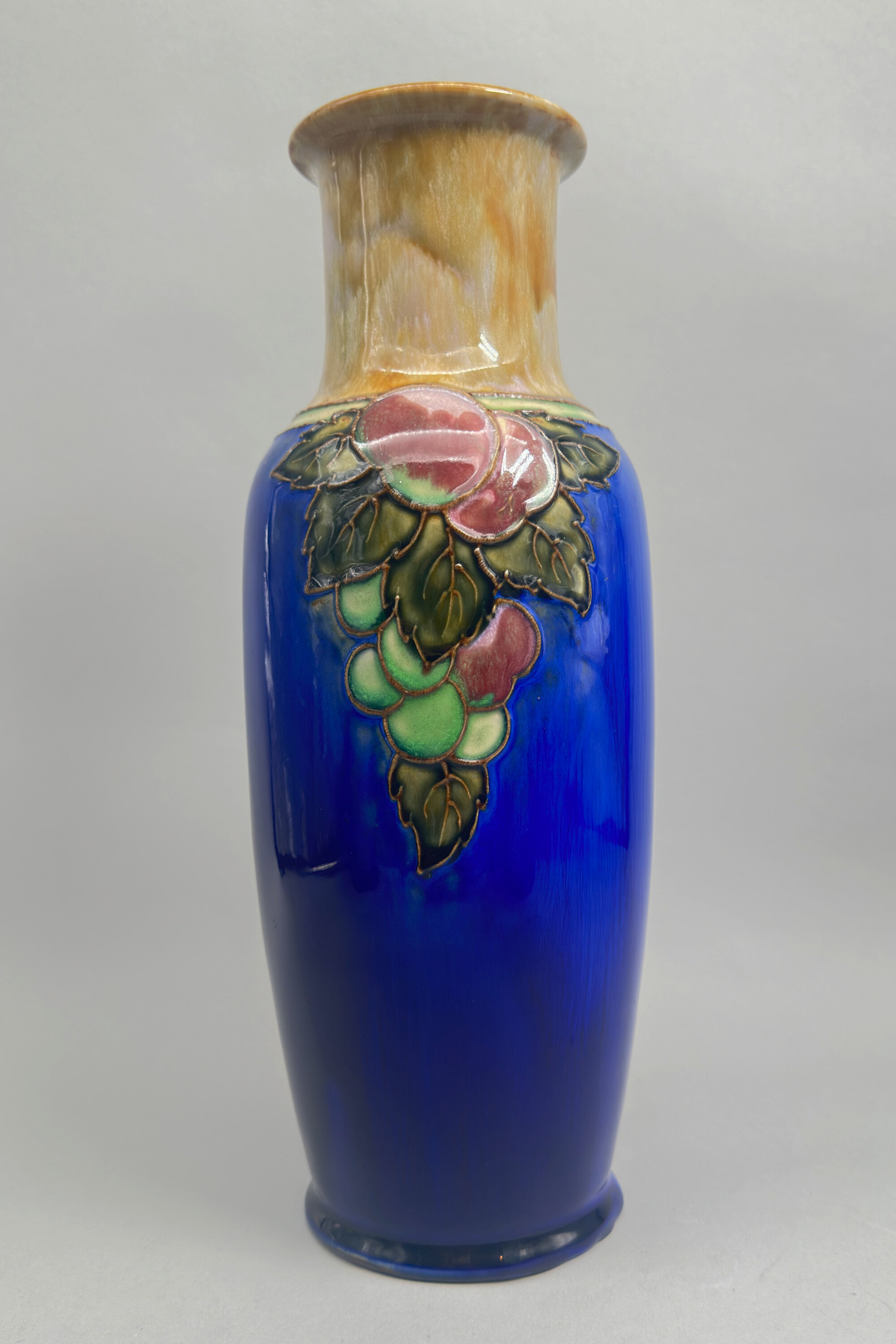
Doulton Vase with raised grape and peach decoration, 1920s
Price: £110The mark for Doulton is one of the standard impressed 'Royal Doulton England' marks where the lettering forms part of a circle combined with three thick lines and the centre is filled with four interlocking 'D's. The addition of a lion but not with the usual accompanying crown allows a fairly precise dating to between 1923 and 1927, although the pattern number beginning with ‘X’, which appears on other pieces with similar decoration but a different shape, is supposedly found on pieces made for couple of years thereafter. Either way, the mid to late 1920s dating fits with both the form and the decoration which have a distinctly Art Deco feel. The mark ‘P’ is for the decorator Lizzie Padbury but the scratched mark cannot be identified. Presumably the second set of numbers indicate the shape.
Royal Doulton produced many pieces reflecting the Art Deco style and other similar vases can be found on this site. They are an elegant reinterpretation producing pieces of great decorative appeal.
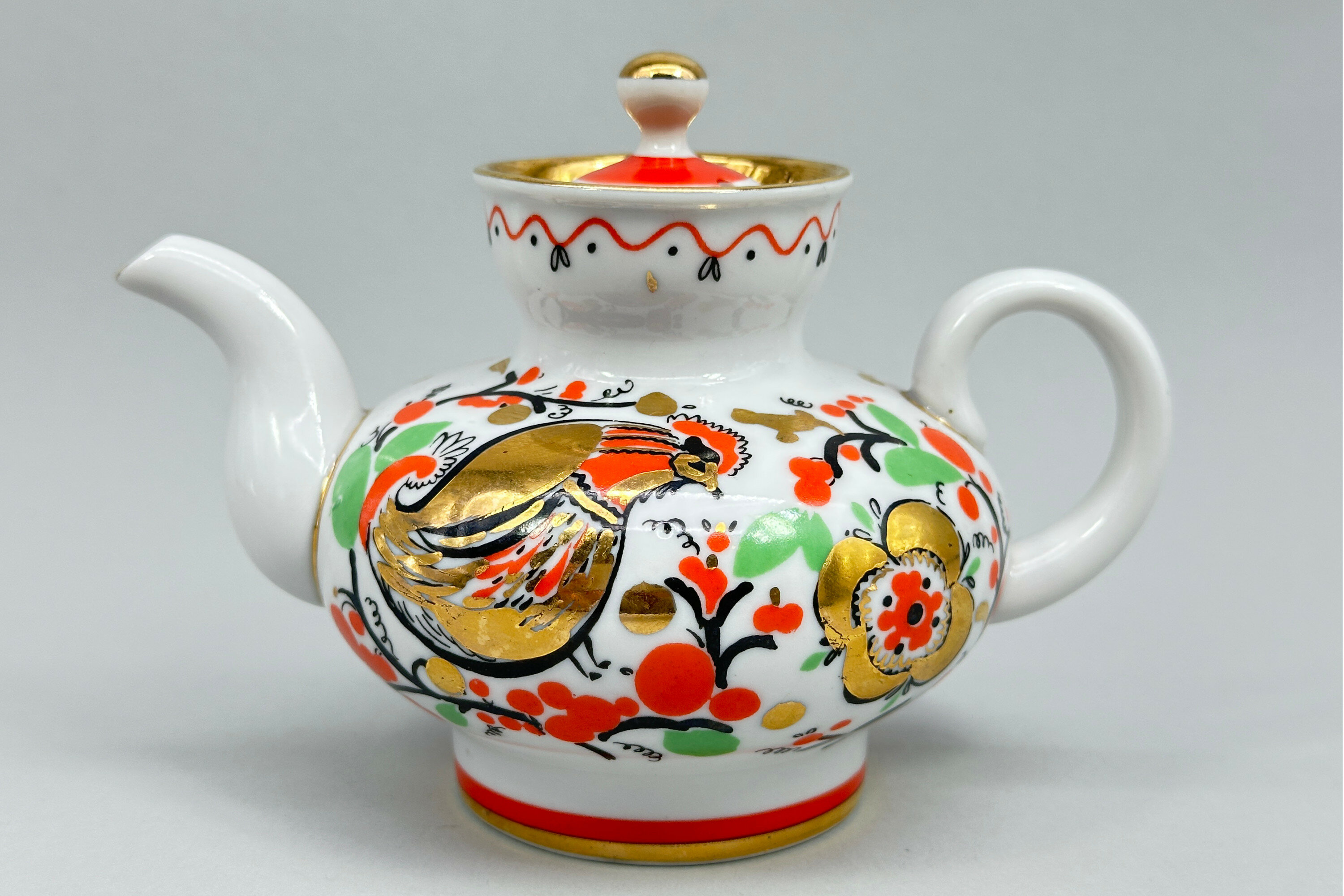
Lomonosov Teapot decorated Cockerels, late C20th
Price: £45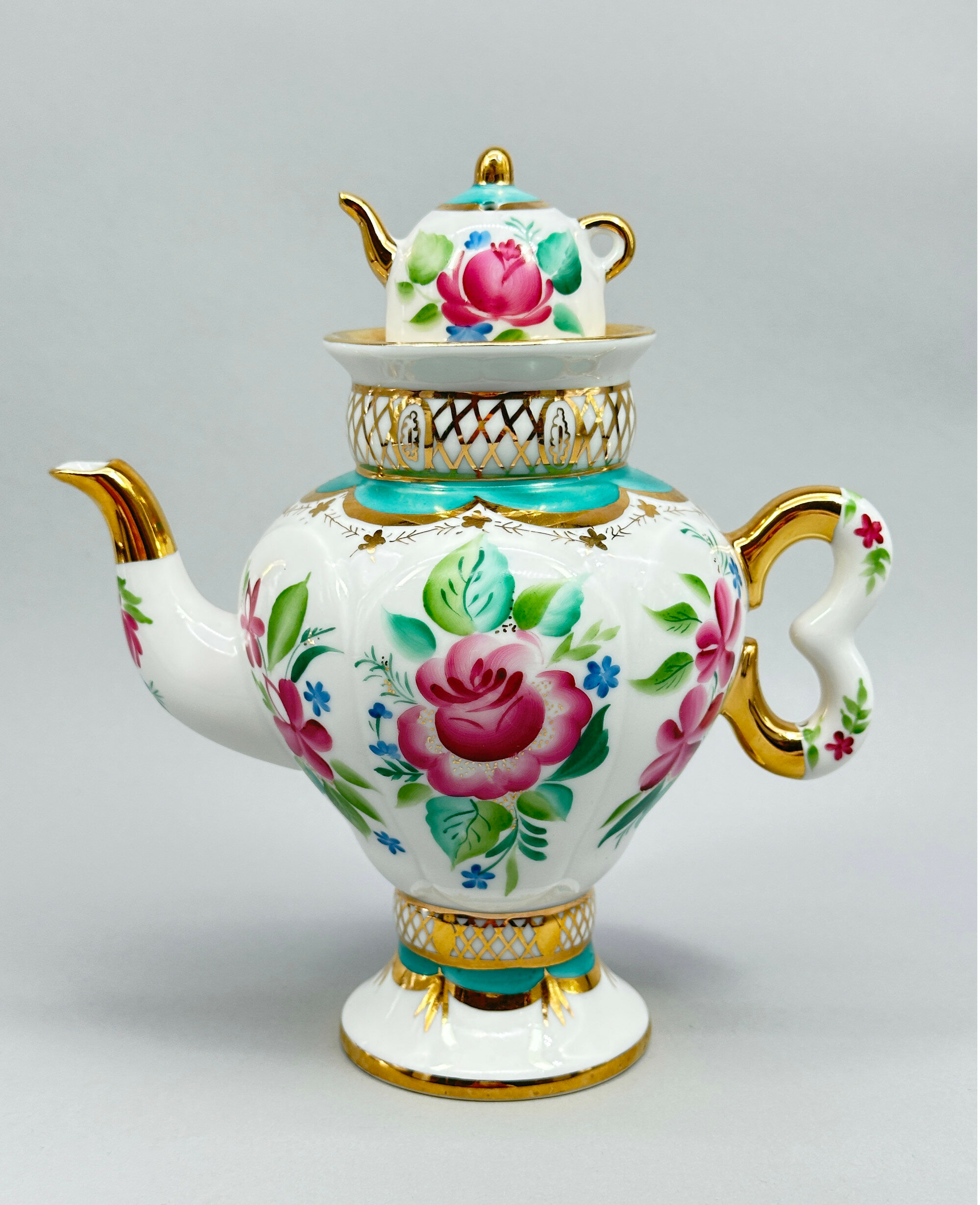
Lomonosov Teapot in the form of a Samovar, late C20th
Price: £75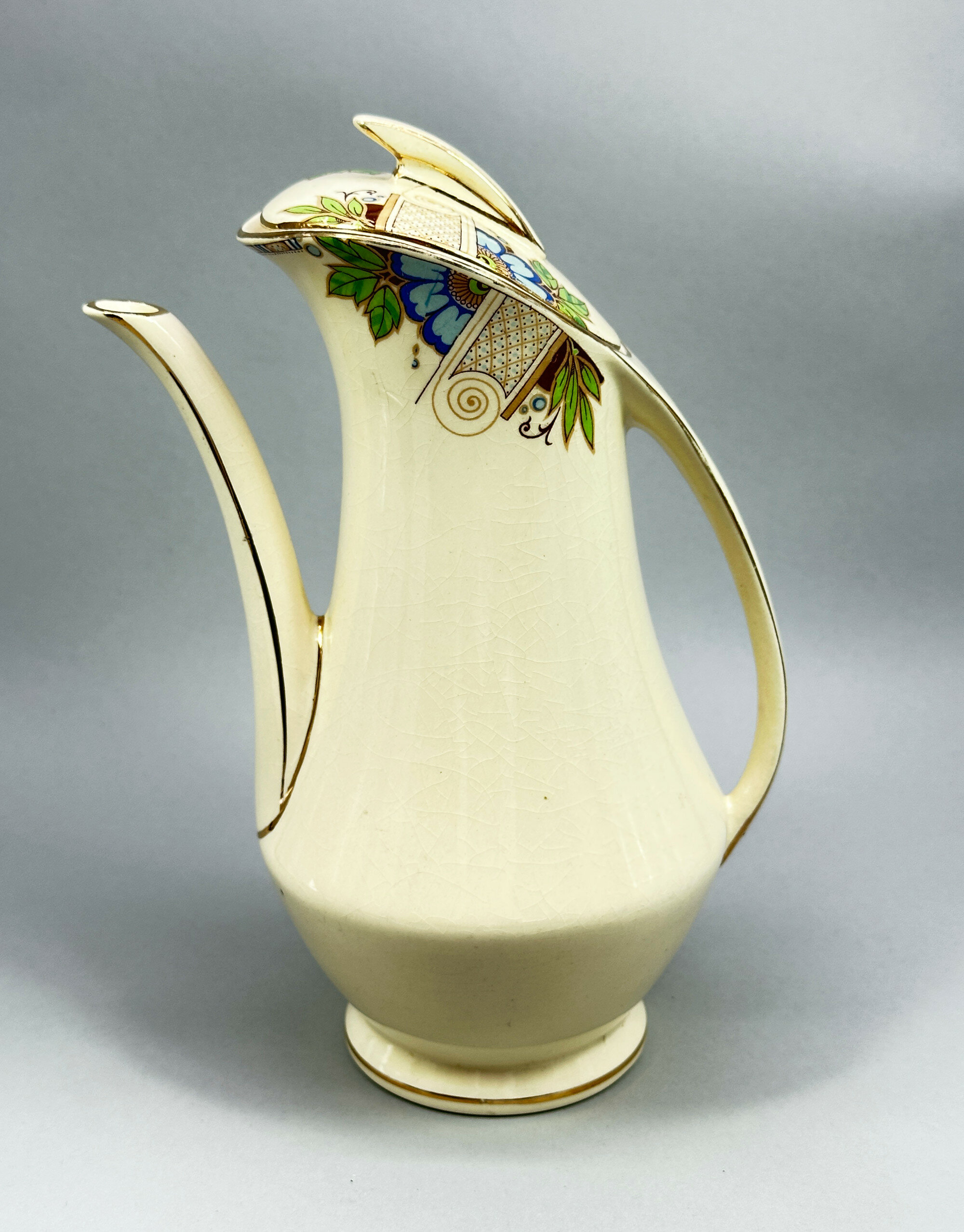
Art Deco Coffee Pot, Crownford Burslem, Staffordshire 1930s
Price: £35Burslem in Staffordshire was one of the famous six ‘pottery towns’ and immortalised in the novels of Arnold Bennett as ‘Bursley’. The firm Thomas Ford and Sons began its production there in the late nineteenth century, continuing until 1938 when the business was purchased by Oswald Shufflebottom who renamed it Ford & Sons (Crownford) Ltd. The trade name ‘Crownford’ had been adopted quite early on by the Ford family and was kept by the Shufflebottom family until the late 1980s. The ‘Crownford Burslem’ wares were mostly produced in the fashionable Art Deco style during the late 1920s and 1930s and this coffee pot is a fine and representative example of their work.
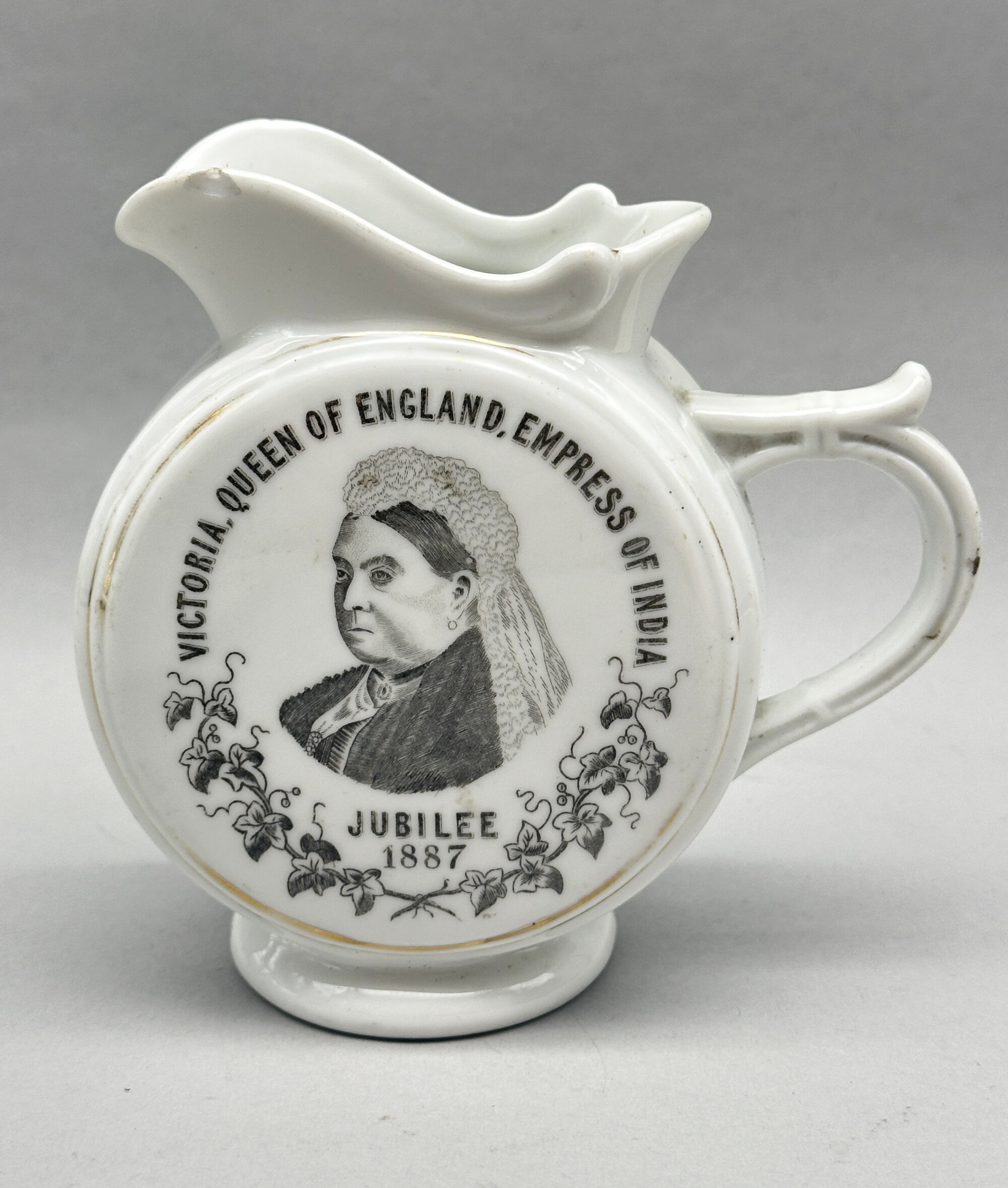
Queen Victoria Golden Jubilee Jug, 1887
Price: £10
Gilt decorated English porcelain powder box and cover, probably mid C20th
Price: £15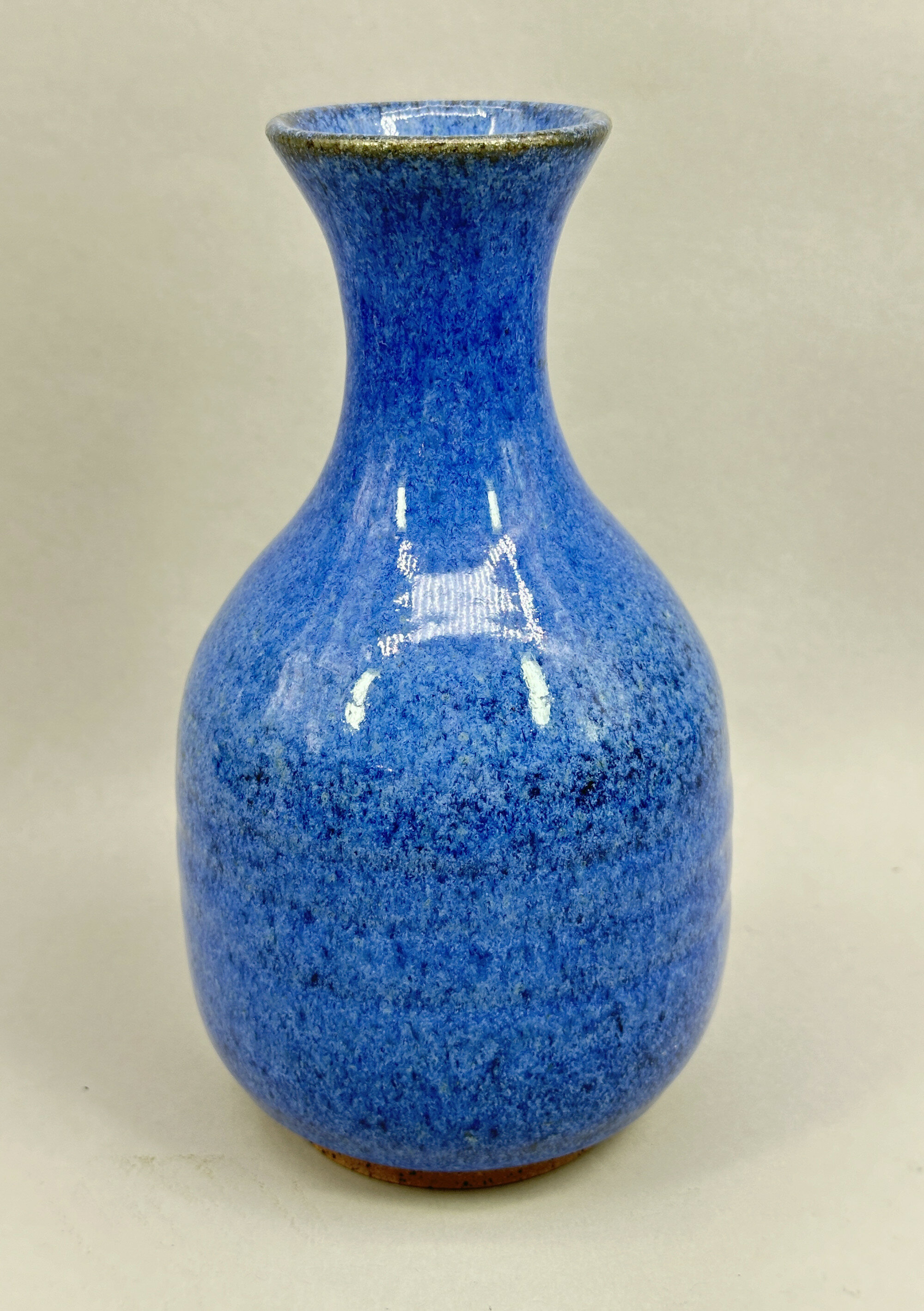
Studio Pottery Vase with Robin’s Egg Glaze marked Zambia, Modern
Price: £30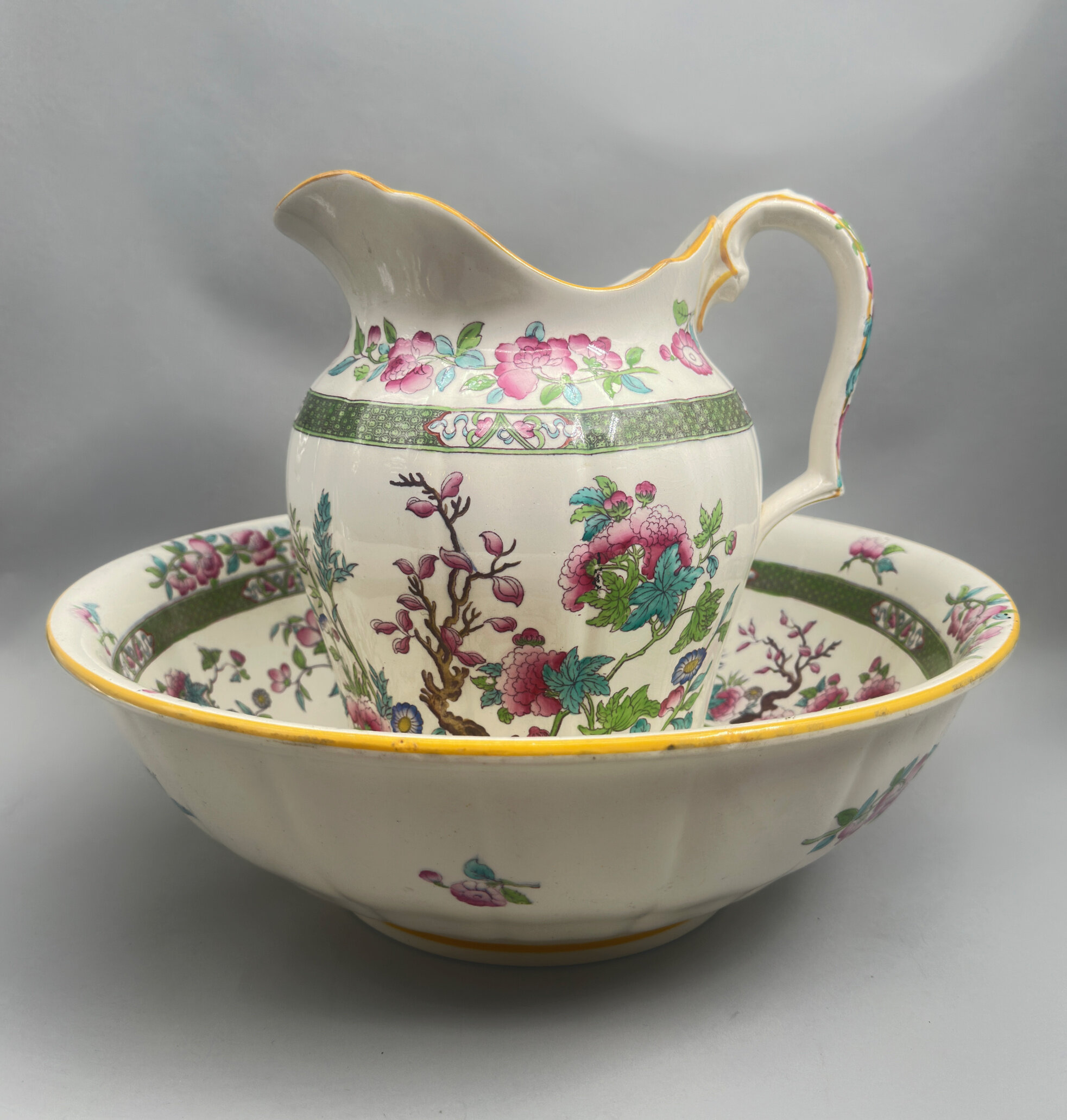
Minton Indian Tree Pattern Pitcher and Basin circa 1900
Price: £350………………………………………………………………………………………………….................................................................................
The celebrated firm of Mintons was founded by in 1793 by Thomas Minton (1765–1836) at Stoke-upon-Trent, Staffordshire, England as ‘Thomas Minton and Sons’, producing earthenware. The initial ranges were standard tablewares in blue transfer-printed or painted earthenware, including the ever-popular Willow pattern. By the mid nineteenth century and in partnership with Michael Hollins, Mintons began the production of decorative finishes for the interior and in particular floor tiles which enjoyed enormous demand and were the subject of numerous prestigious commissions including a contract for the flooring of the American Capitol. This was followed by the introduction of the plain white glazed ‘Parian’ wares and then the Italian inspired ‘majolica’ pieces with their richly coloured lead glazes. Mintons continued to follow popular trends, working with Christopher Dresser, recruiting Louis Solon from Sevres who had developed pâte-sur-pâte wares and finally contributing to Art Nouveau ceramics with a speciality in secessionist wares.
But the manufacture of tableware continued alongside all these other developments and Mintons adopted and adapted the popular ‘Indian Tree’ pattern which was first produced by Coalport in 1801. This design fused elements from Indian textiles and Chinese ceramics into an amalgam with immediate appeal. The pattern includes the crooked branch of a tree and a partial landscape including exotic flowers and leaves with a palette of colours emphasising green, blue, pink, and orange, resembling quite closely the Chinese export wares decorated in ‘Famille Rose’ enamels which had been exported to Europe in great quantities in the eighteenth century. Many of Coalport’s rivals, including Spode, Wedgwood and Royal Worcester produced their own versions of the design, but Mintons’ interpretation was held to be one of the most successful.
It was used by Mintons to decorate a variety of shapes, mainly dinner and tea wares, but the toilet pitcher and matching basin are seldom found in this pattern. Both the forms are extremely elegant, the pitcher with light fluting, a scalloped rim and a complementary handle, while the basin, also lightly fluted, employs simple lines with a turnover rim which follow the shape of a Chinese original. All the standard elements of the pattern can be seen, in particular the twisted tree, and the diaper work borders again reflect Chinese originals.
Both pieces are marked with the pattern number ‘T 216’ and a Minton stamp, the form of which allows fairly accurate dating. The globe topped by a crown with the banner ‘Mintons’ was used from 1873-1912 but ‘England’ was only added after 1891, giving a circa date in the late nineteenth or early twentieth century, probably around 1900. The original toilet set, which would have included the pitcher and basin along with, probably, a chamber pot, a soap dish, candlesticks and other accessories, was clearly a ‘deluxe’ item at the time and its quality is still apparent today when it can be enjoyed simply for its decorative appeal and as a reminder of a past era of grandeur.
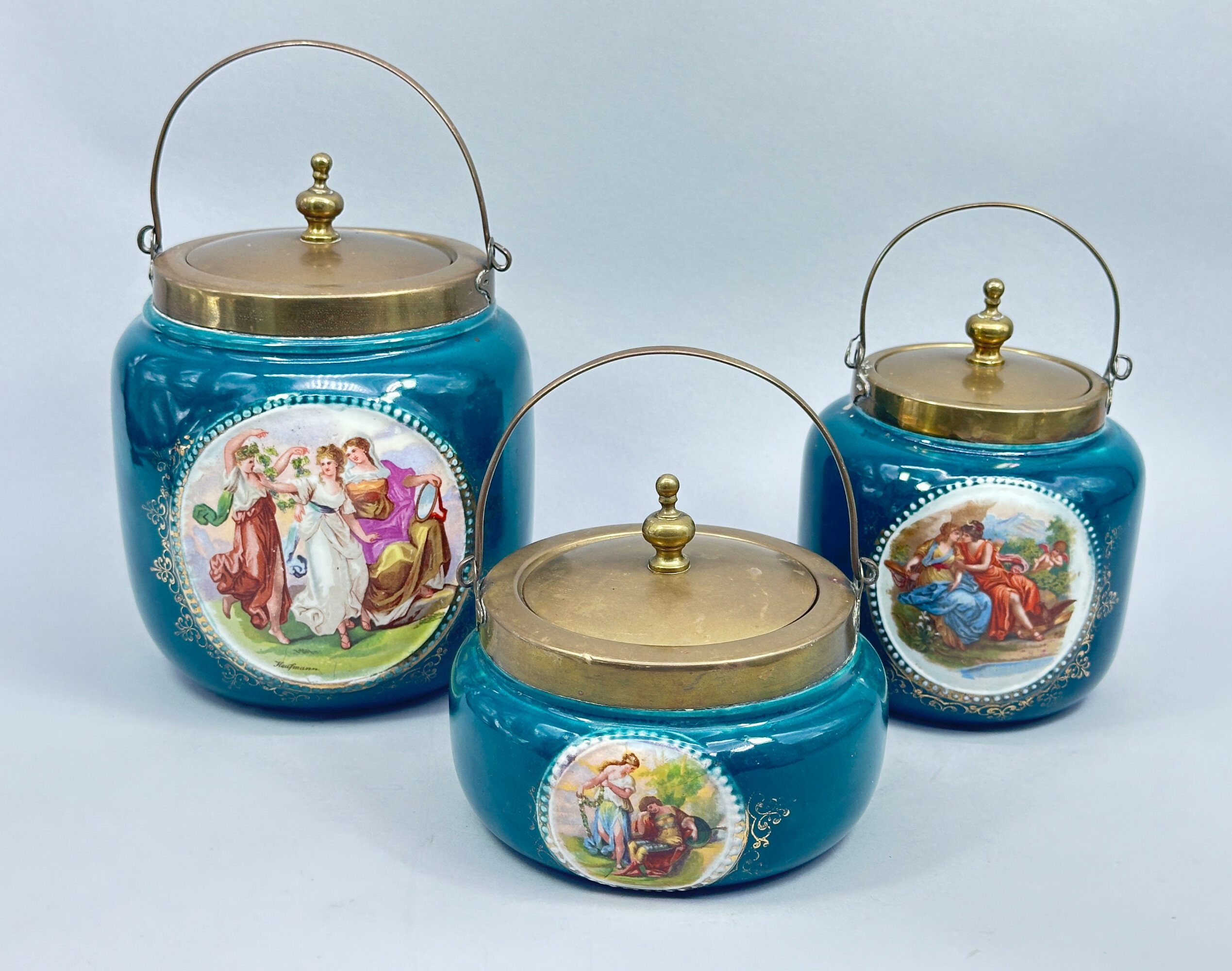
Set of Three Empire Porcelain Company Biscuit Jars circa 1900
Price: £120The Empire Porcelain Company was established in 1896 at the Empire Works in Stoke Road, Hanley, Stoke on Trent. A wide range of pottery and porcelain was subsequently produced until the factory’s closure in 1967. The various marks include the initials EPC, EP or the word Empire. The form of the mark seen here occurs on the earliest pieces made between 1896 and 1912. Blue ground pieces with mythological scenes were produced in a variety of forms during this period, some decorative, such as ornamental vases, and some more practical, as here : modest but graceful accessories for the Edwardian drawing room.
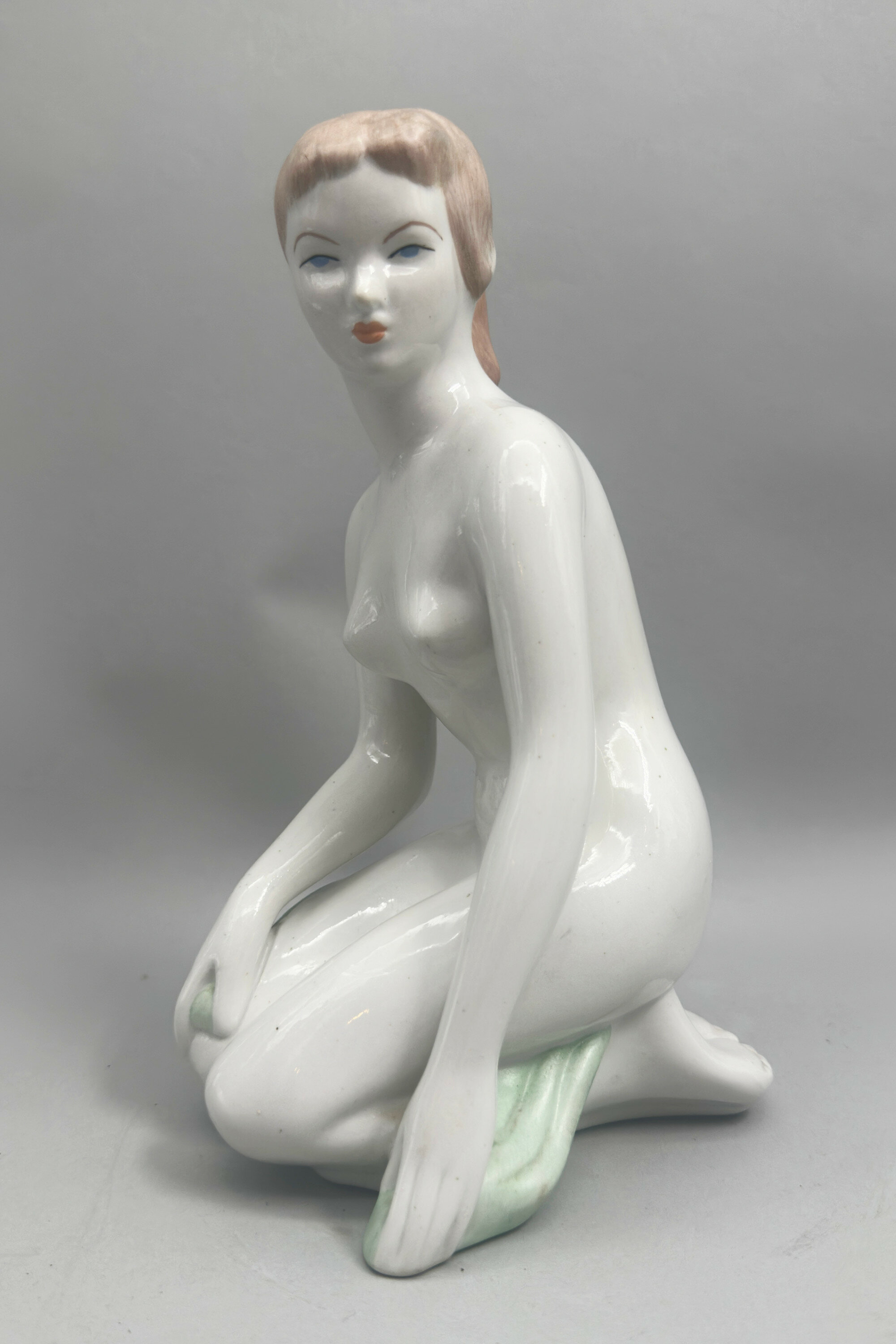
Art Deco style kneeling figure of a Girl, Aquincum Hungary, second half C20th
Price: £75Aquincus was an ancient Roman settlement, eventually to become the town Obuda, the third of the three cities which were merged to form Budapest and the oldest district in the Hungarian capital. In 1854, Hüttl Tivadar set up a shop in Pest selling porcelain eventually becoming involved in porcelain manufacture itself with such success that by the early 1900s he was supplying the court at Buda, eventually supplanting the rival firm of Herend. Despite legal battles amongst the family concerning the ownership of the business, the firm continued to prosper until the 1950s when the new communist government decided to nationalize the factory, renaming it Aquincum Porcelángyár. Tableware, which had been the staple of the Hüttls’ production was replaced by figurines which rapidly enjoyed great popularity. One of the principle artists was Antonia Szabó who became chief designer in 1966. With the end of socialism, the firm went into private hands in 1993 but suffered an immediate and rapid decline causing it to close soon after.
This figure may possibly, then, have been designed by Szabó himself but it is certainly typical of the pieces produced in the early years of state control and perhaps one of the most appealing. The form of the mark corresponds with a dating to the 1950s or 1960s and the piece has both historical associations and considerable decorative appeal.
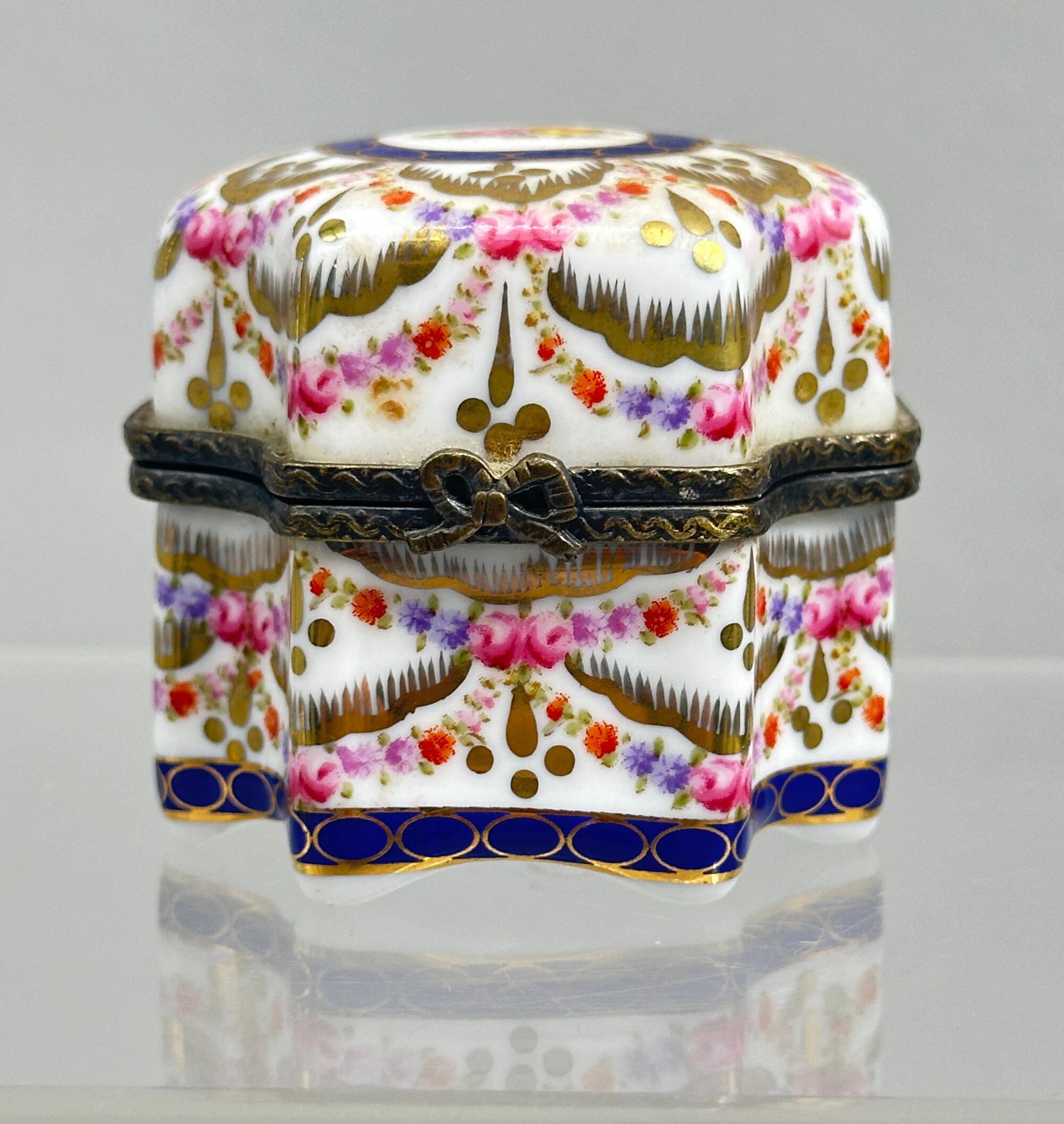
Reproduction Limoges Porcelain Box with Scent Bottles, Modern
Price: £25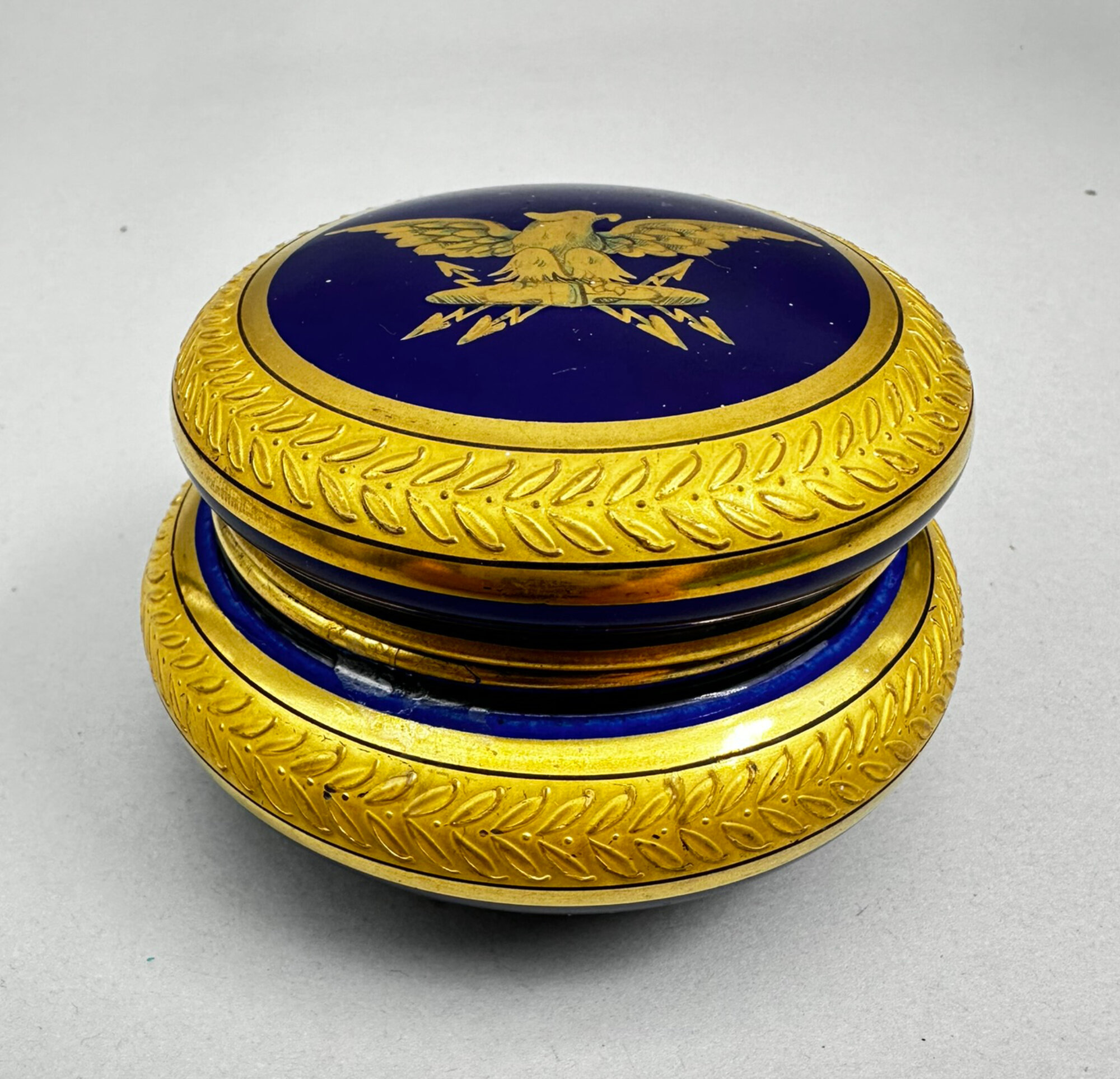
Blue Ground Empire Style Powder Box and Cover, Jean Pouyat, Limoges circa 1900
Price: £75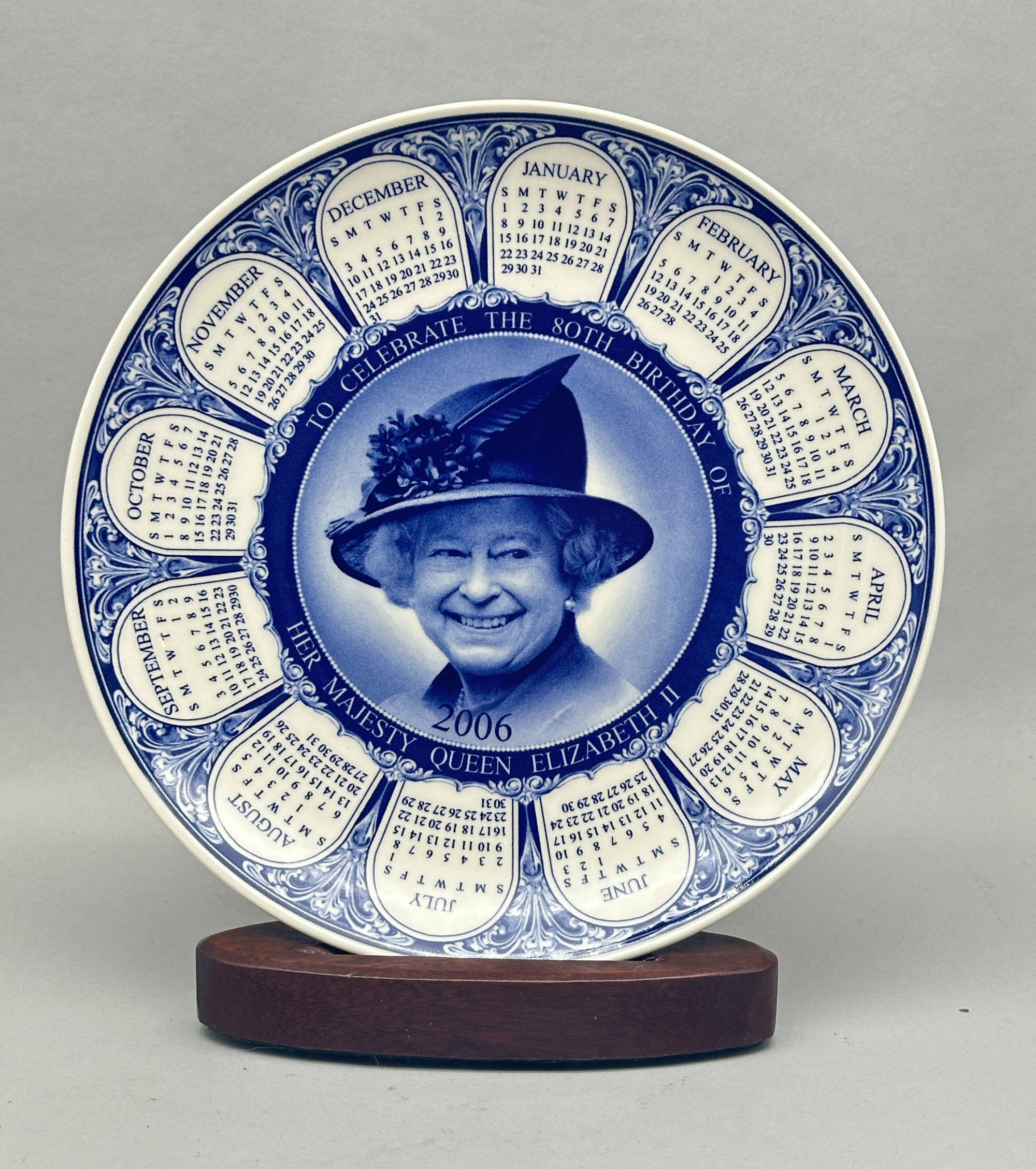
Wedgwood Calendar Plate, 80th Birthday of Queen Elizabeth II, 2006
Price: £10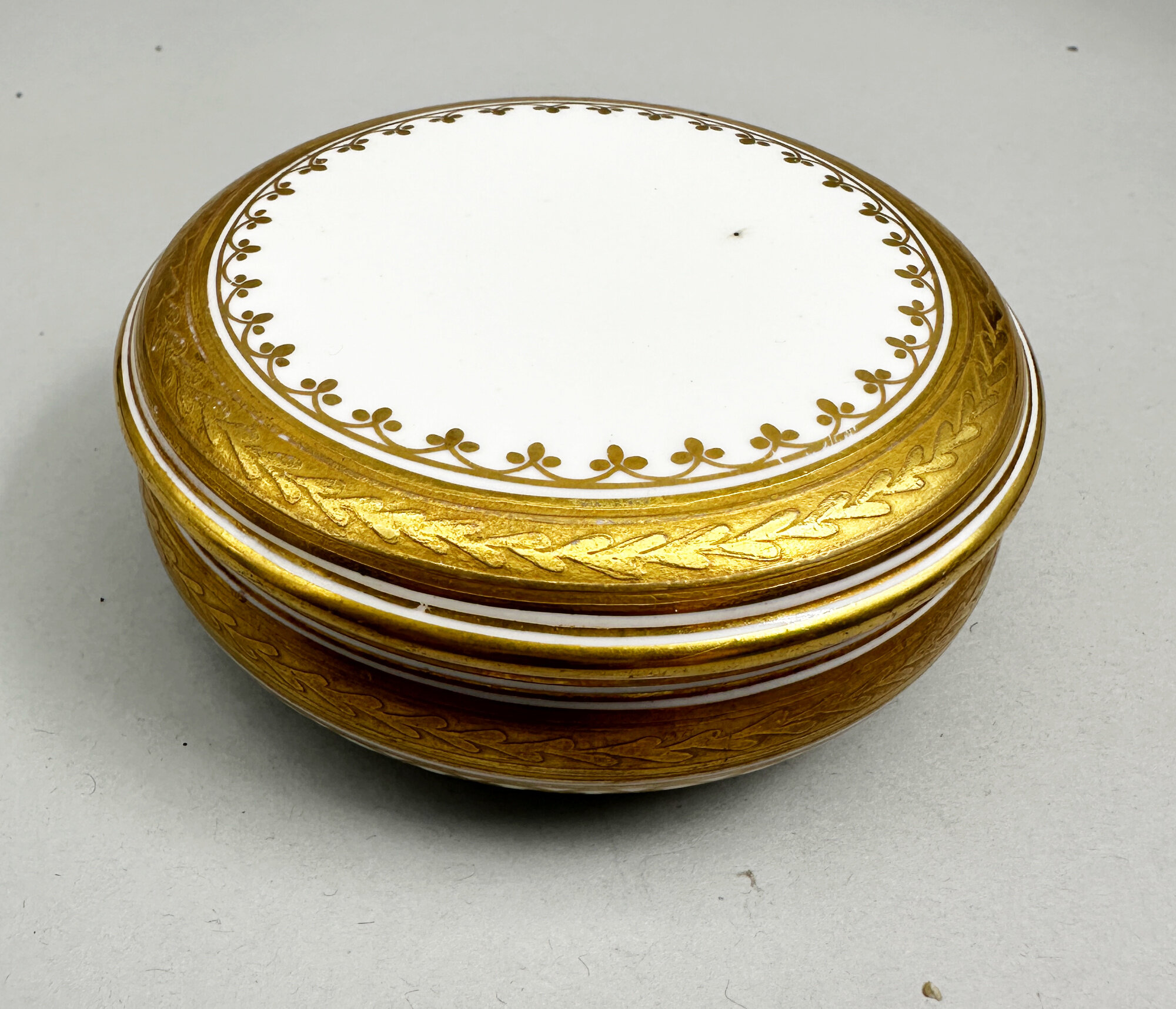
Gilt decorated English porcelain powder box and cover, probably mid C20th
Price: £15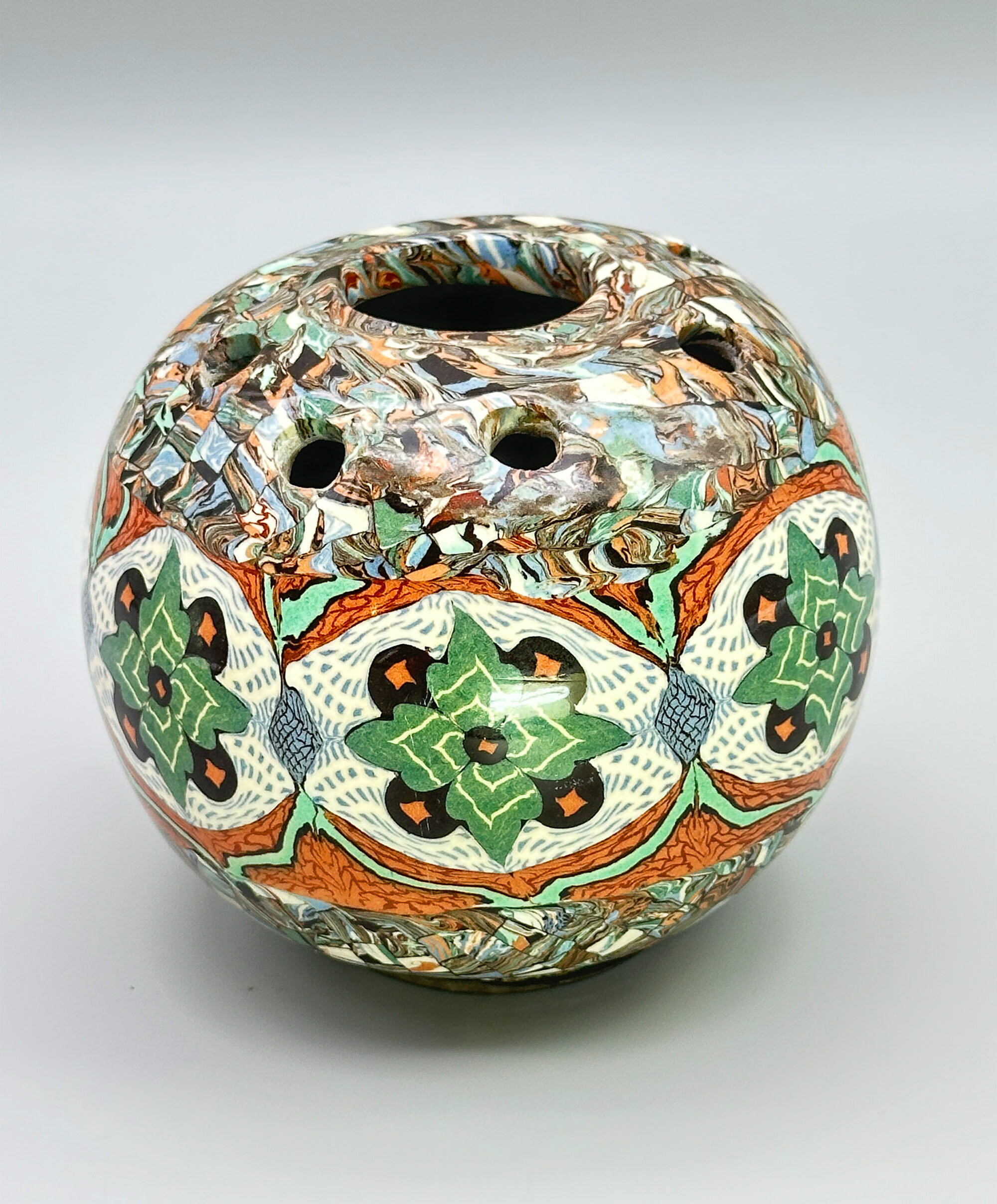
Vallauris Mosaic Pattern Vase, Jean Gerbino, signed, mid C20th
Price: £65Known for its ceramics since Roman times, when the deposits of clay found locally acted as stimulus for the production of pottery, the French Riviera town of Vallauris has been called the ‘city of 100 potters’. Pottery has been made there continuously since the classical period with a growth in production in the late nineteenth century followed by the establishment of various well known ateliers in the twentieth and the residence of Picasso himself who is said to have produced over 3500 pieces there.
Jean Gerbino Jean Gerbino (1876-1966) was a Sicilian ceramicist, who took French citizenship in 1928. He settled eventually in Vallauris and developed a unique technique combining mosaic and nériage (a mixture of coloured clays). The clays are coloured with oxides, hardened, and then assembled into plates to create colourful and distinctive mosaic patterns. These plates are then moulded, dried, and fired. The resulting forms are both distinctive and highly decorative, modern with a hint of the Art Deco era.
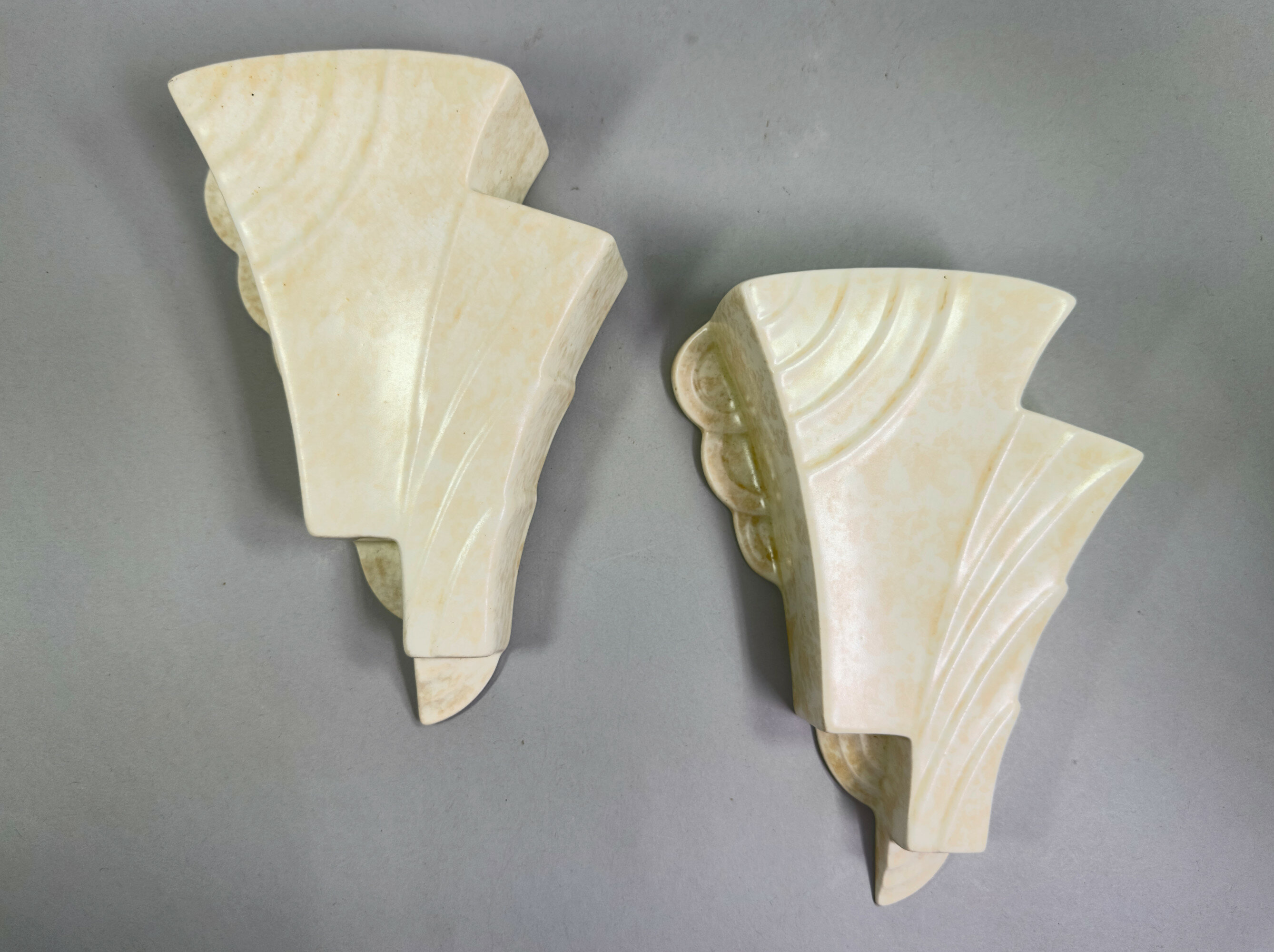
Pair of Art Deco Style Wall Pockets, C20th
Price: £55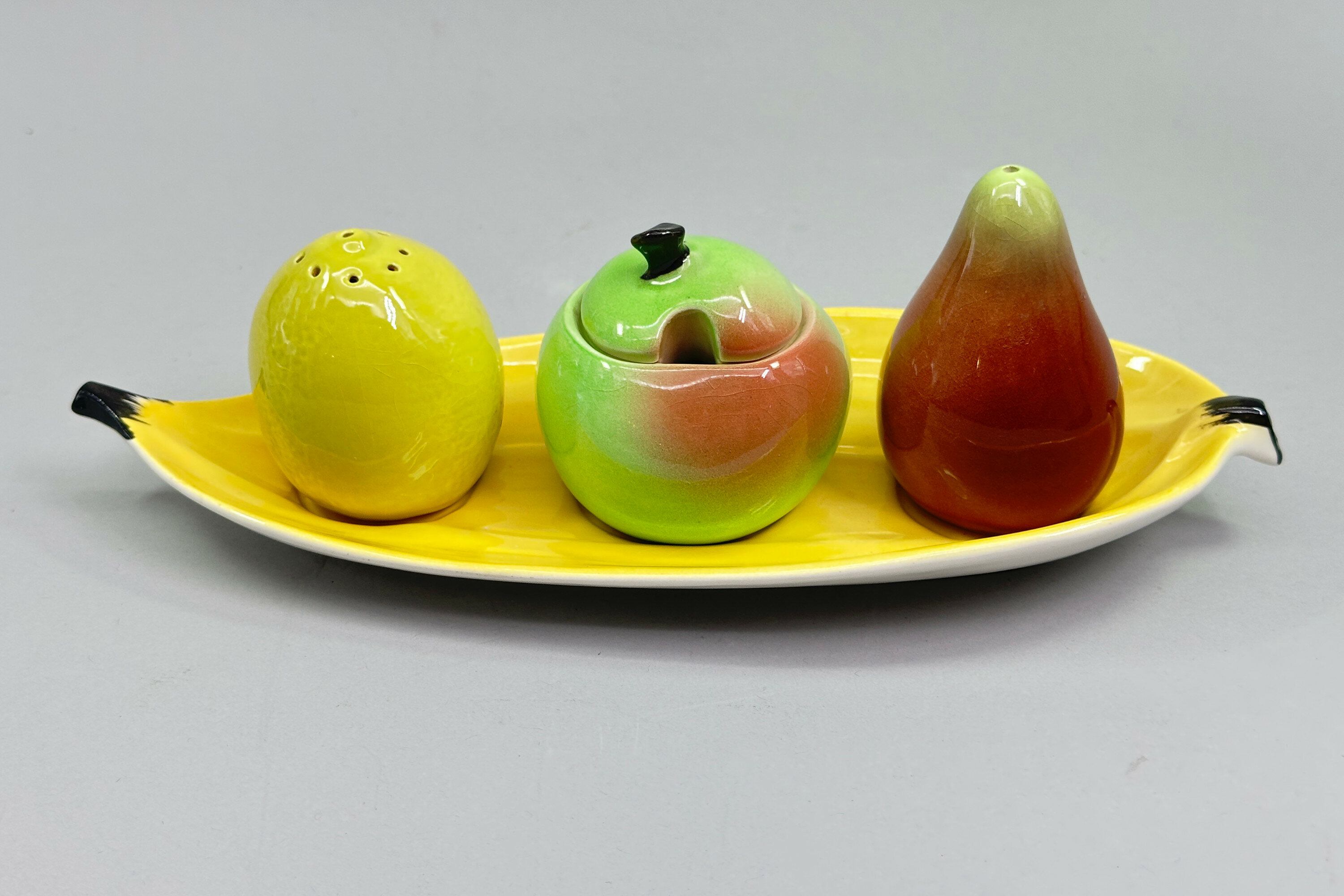
Carlton Ware fruit Cruet Set, Australian Design, 1950s
Price: £35Carlton Ware was the trade mark used by the pottery manufacturer Wiltshaw and Robinson, whose premises were located in Stoke on Trent, four years after the firm’s establishment in 1890. The well known script mark was introduced in 1928. The firm mostly concentrated on decorative giftware and new methods of production introduced in the 1920s put it at the forefront of the earliest Art Deco pottery pieces produced, firstly with designs originating from Tutankhamun’s tomb and then with pieces with an Oriental chinoiserie influence. Tablewares were also produced and this cruet set is an example of the imaginative designs made after the second world war and most likely dates to the 1950s. The appeal is obvious and today this set, complete with the original stoppers for the salt and pepper, can fulfil both a practical and decorative function.
Some examples appear to have an original matching spoon for the mustard pot; if that is the case, then it is absent here, but the spoon often illustrated looks quite generic and may not necessarily have been an integral component.
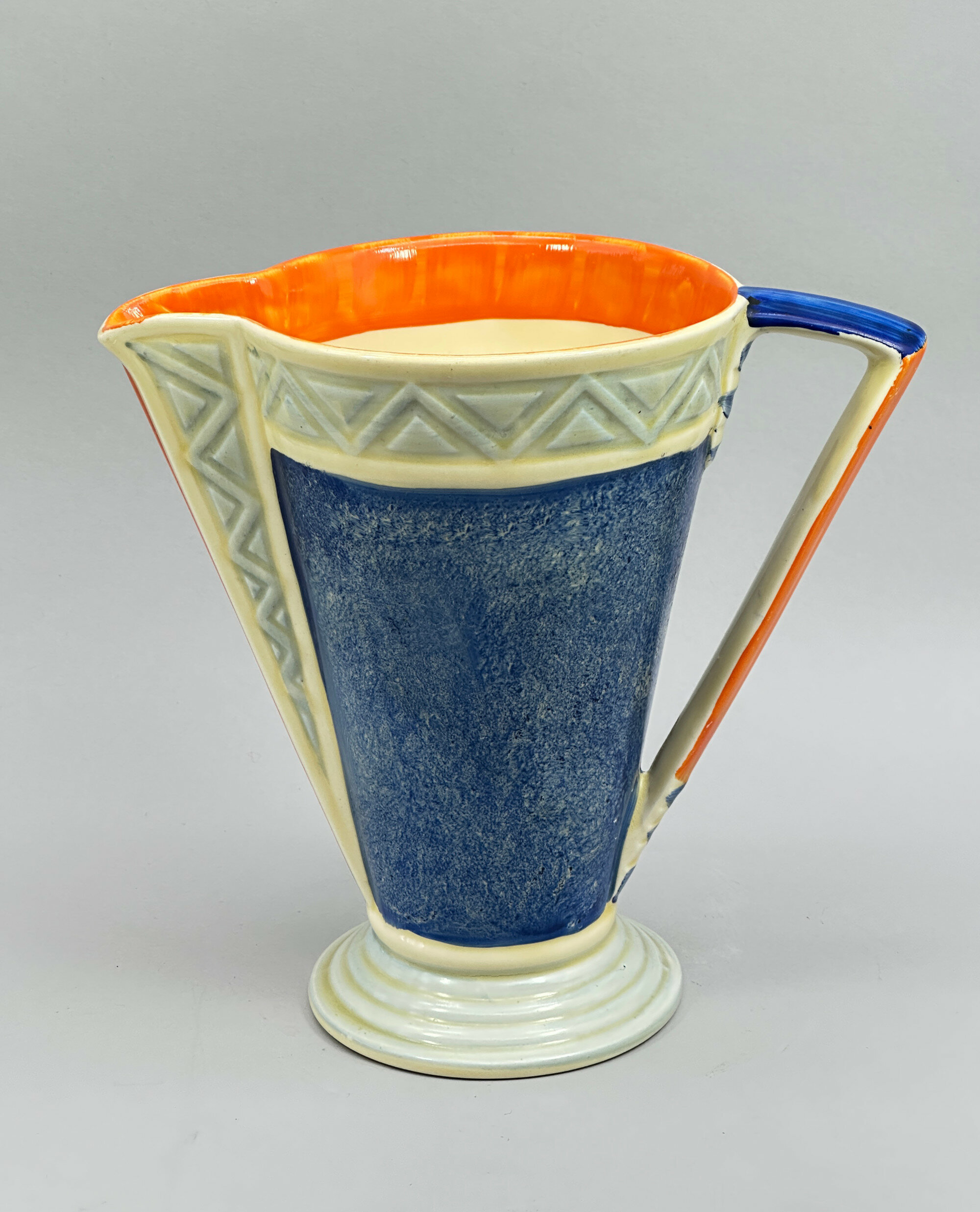
Myott Son & Co Art Deco style Jug, 1930s
Price: £75Myott Son & Co was one of famous the Staffordshire Potteries and traded for over 90 years. Founded in 1898, it began production in Stoke moving to Cobridge four years later. Its output was continuous but in 1949 the firm suffered a disastrous fire which reportedly destroyed the firm's records and pattern books and probably for this reason it relocated to Hanley. In 1969 it was bought by the American firm Interpace, but the Myott name was retained until 1976 when the company merged with Alfred Meakin Ltd, who were based in Tunstall, to form Myott-Meakin Ltd.
Myott now are best known for their Art Deco inspired designs from the 1930s. Following the success of their competitors, most notably the designs of Clarice Cliff, Myott established their own popular following and produced pieces which could rival the output of their celebrated competitors. This jug, with its clean lines and bold colours is an excellent example and like others of the same form bears the pattern umber ‘8498’. Some of their glazes were easily subject to wear and blue was less commonly used so both the condition and the colour range of this jug make it a highly desirable collector’s item.
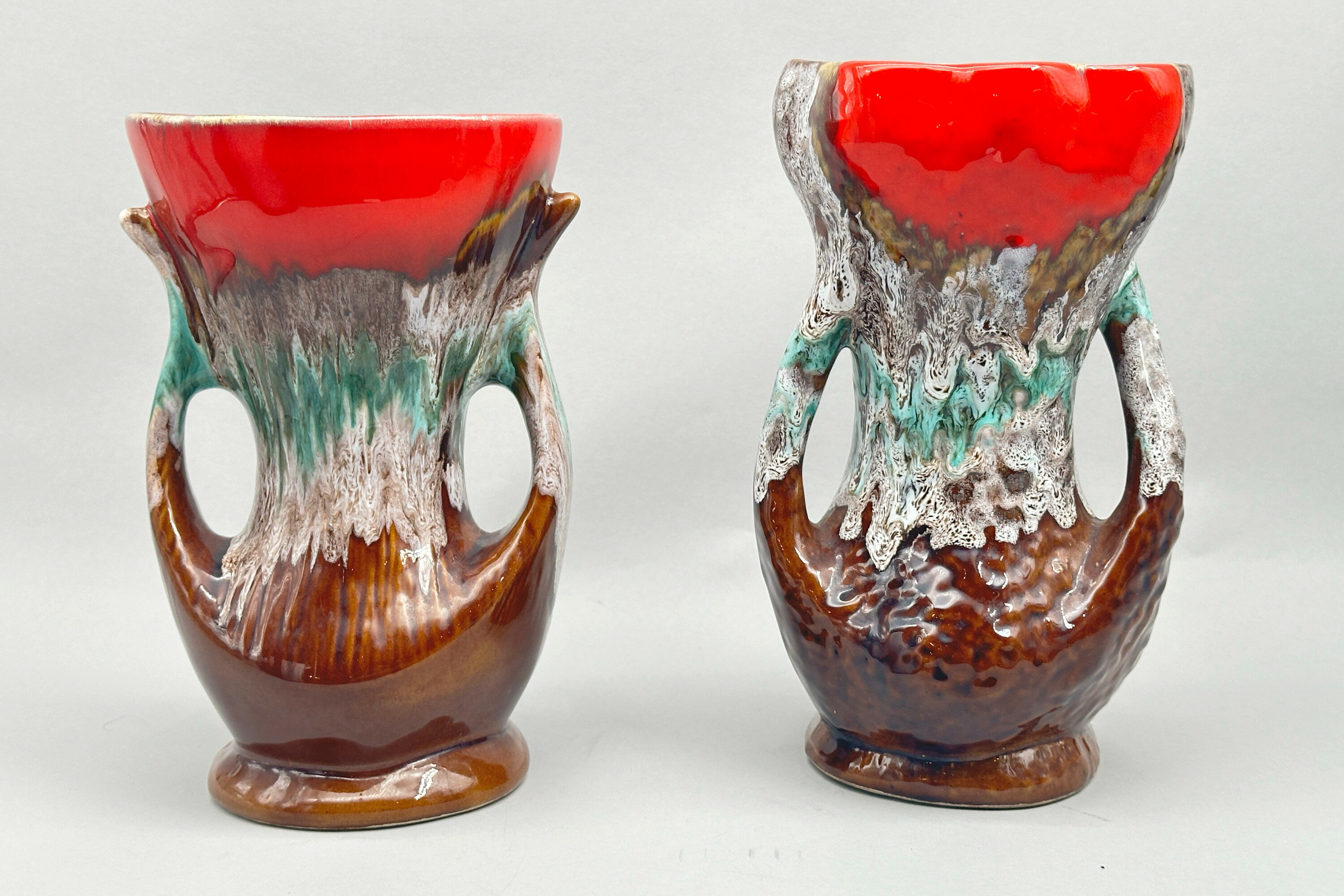
Two Vallauris Lava Vases, French 1950s/1960s
Price: £150………………………………………………………………………………………………….....................................................................
Vallauris is a tourist town of the French Riviera near Antibes taking its name form the Provencal ‘Valauria’ meaning ‘the golden valley’. It is divided into two parts: the upper town which is the old centre and the seaside district which runs from the port along the coast, towards Antibes. Deposits of clay were found there in Roman times giving the impetus for the creation of potteries which tended to concentrate on domestic wares. Production was then continuous with an infux of craftsmen from Genoa, Italy, in the sixteenth century and the development of artistic activity in the seventeenth. The advent of the railways in the late nineteenth century led to an even further expansion of production and companies were established there which achieved widespread fame and recognition notably those of Massier and Foucard-Jourdan.
After the war, Picasso, along with a group of fellow artists, settled in Vallauris and it proved to be a congenial stimulus. He began to experiment with producing ceramics in 1947 and was to continue working extensively in this field until his death in 1973 (see image 12). There were collaborations, one with the ceramicist Robert Picault and another with Suzanne and Georges Ramié, the owners of the Madoura workshop, where Picasso worked on his productions. Indeed it was at the Madoura workshop that Picasso met Jacqueline Roque, a saleswoman working there and 44 years his junior. They married in 1961 and remained together until his death in 1973, Jacqueline being the inspiration for many of the designs which Picasso created.
It would be fanciful, though, to see the influence of the famous artist on these vases although they were very much created in the tradition of Vallauris pottery with which he was so in sympathy. The town seems to have become particularly fashionable in the 1950s and 1960s and it was around that time that these vases were made. Many pieces were created in lead glazed earthenware, the overall decoration resembling the ‘lava’ glazes used in West German pottery of the same period. These two vases are similar and complementary. The bodies are concave with a short foot and a widely flaring mouth; there are loop handles at each side. The brown glaze at the base is succeeded by a blend of mottled greens and greys and topped with a vibrant red at the mouth. The interiors are glazed brown as is the base with the unglazed foot rim showing the fairly coarse clay used. Some but not all Vallauris pieces are marked and there are many unmarked examples as here. Considerable skill must have been required to produce the variety of glaze effects and the results are striking. As two matching items, these vases have considerable decorative appeal and are worthy examples of a long established tradition of ceramic production.
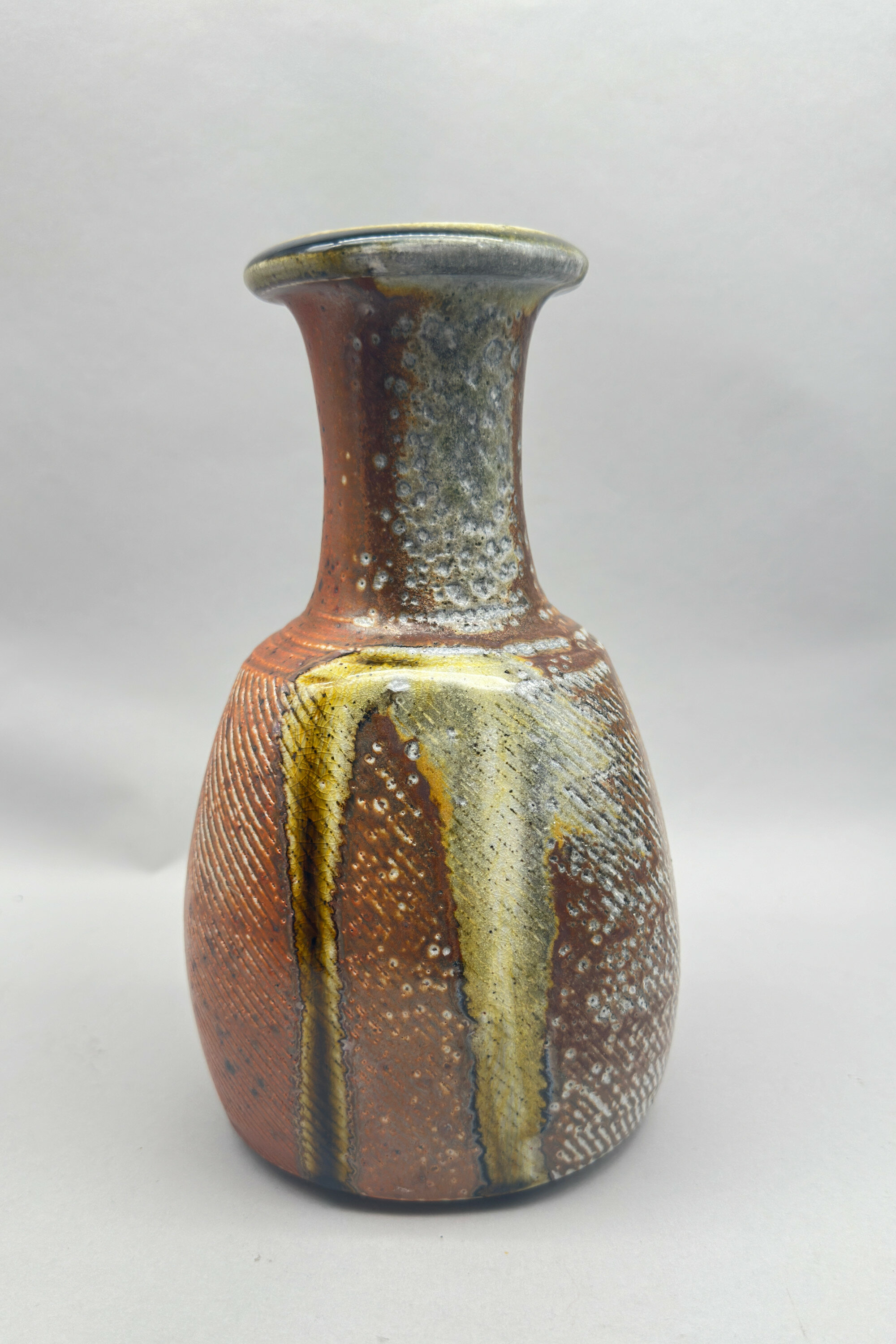
Studio Pottery Vase by John Jelfs, signed, late C20th
Price: £220……………………………………………………………………………………………..................................................................................................................….
John Jelfs was born in Exeter, Devon in 1946 and studied ceramics at the Cheltenham College of Art. In 1973, alongside his wife Jude, also a skilled potter in her own right, he set up his own studio, The Cotswold Pottery Company, in the Cotswolds at Bourton on the Water, from where he has been producing ceramics in a wide variety of forms for over fifty years and still continues to work today. Every piece of his pottery is unique, being made entirely by hand and with the decoration kept to a minimum. Wherever possible locally sourced ingredients of clays, limestone and woodash are used for his glazes of celadon, ochre and shino (a white colour glaze developed in Japan sometimes with red,orange or black spotting).
Jelfs writes himself “From my first exposure to studio pottery I was immediately excited by the work of the late Bernard Leach and his lifelong friend the Japanese potter Shoji Hamada. It was the strength and quietness of their pots which most excited me about their work. For the past few years, I have been concentrating on a range of forms, to which I have applied olive/celadon, ochre and shino glazes made up from wood ash and clay, ingredients both local to my studio. The pots are all hand-thrown from a blend of West-country clays, and are often altered while still soft on the wheel. They are fired twice, the first to biscuit (1000 degrees centigrade) and the second firing to stoneware (1300 degrees Centigrade) in a gas kiln. I use a long firing cycle as this brings out the subtlety and depth in my glazes.”
In more recent years, the construction of a new kiln allowed Jelfs to develop the use of ‘soda glazes’, a complex firing process in which a vapour glaze made of sodium oxide (soda) glazes the clay body of the pottery during the firing process. Sodium materials are introduced into the kiln, usually with a nozzle, at a high temperature of over approximately 1280°C (2350°F). The soda then evaporates and the flame carries the vapour within the kiln, landing on the hot pottery pieces where it fuses with the materials in the clay and any slip decoration applied to it. The soda vapours are colourless and it is the reaction on contact that produces a wide range of colours and textures.
“Since the soda fuses to the surfaces of the work in this way, it blurs the line between pot and glaze/surface; they become one.” — Harrison Levenstein
This elegantly potted vase is a prime example of the technique and the wide variety of glaze effects and textures can be seen and admired. As often, the base is unglazed and in this case marked with the artist's stamp ‘JJ’. The earliest pieces were given an impressed ‘swan’ mark soon to be followed with the wording ‘Bourton on the Water’ in addition. The simple mark of the artist’s initials seems to be later which fits with the use of the ‘soda glaze’ technique developed some years after the pottery studio was set up. Jelfs' work has been widely exhibited in leading galleries including Galerie Besson and the Victoria & Albert Museum in London, Alpha House in Sherborne, Beaux Arts, Bath, and the Rufford Ceramics Centre in Nottingham. It is also included in many collections around the world and our vase would make a fine addition to any of them.
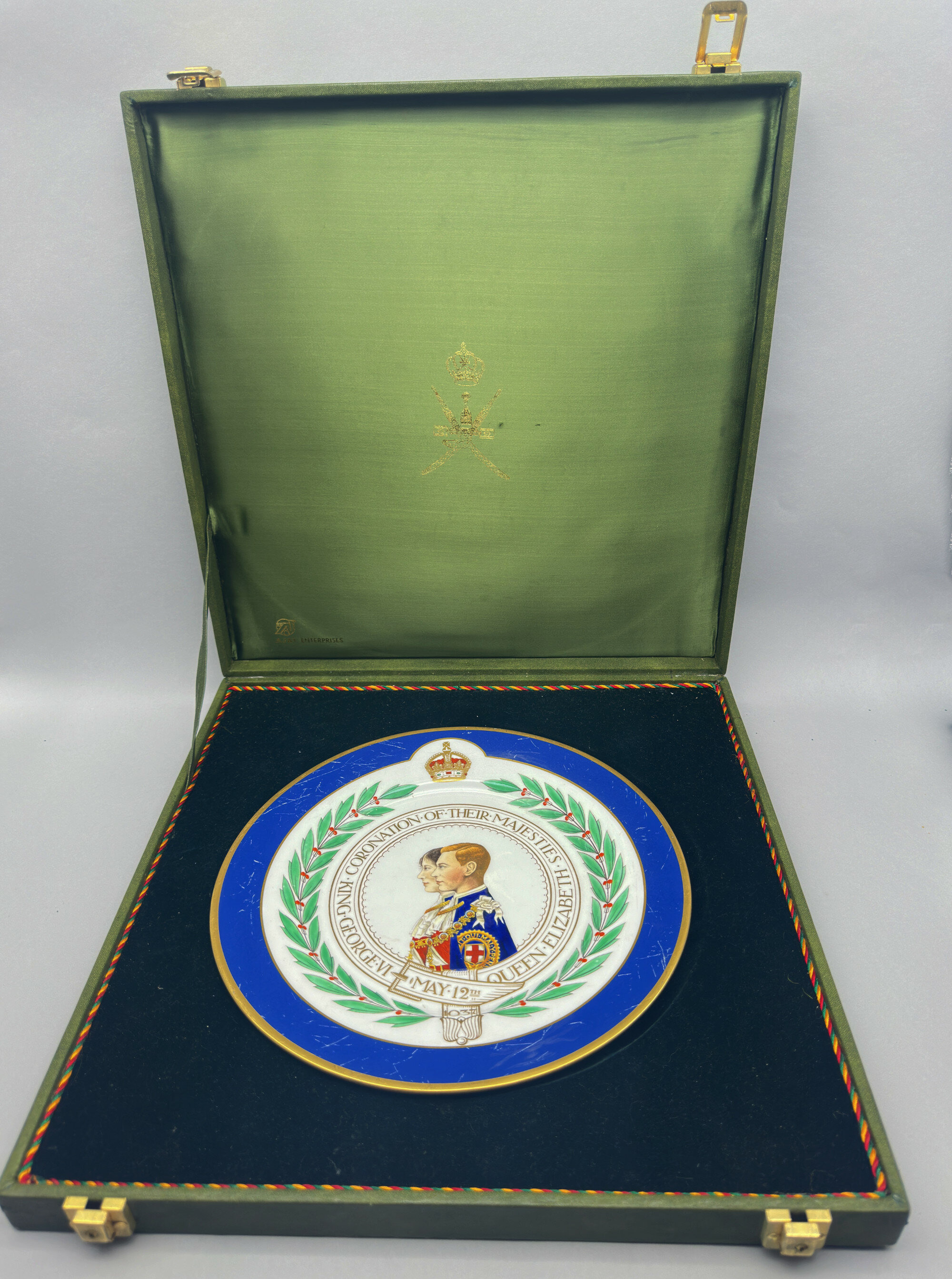
Mintons Coronation Plate, King George VI and Queen Elizabeth 1937, boxed
Price: £25
Pink porcelain powder box, Radnor Bone China, English Staffordshire, 1950s
Price: £15Radnor was the trade name used by Hall Bros (Longton) Ltd. Hall Brothers was a China manufacturer based at the Radnor Works, Longton, Stoke-on-Trent, England which traded from 1947 until its liquidation in 1972. It produced figures, birds, toby jugs and floral ware, mainly small porcelain boxes which were distinguished by their decoration of finely modelled flowers (see image XX for an advert from the 1960s). This box is a typical example and survives in excellent condition with just a very small amount of near inevitable damage to the petals.
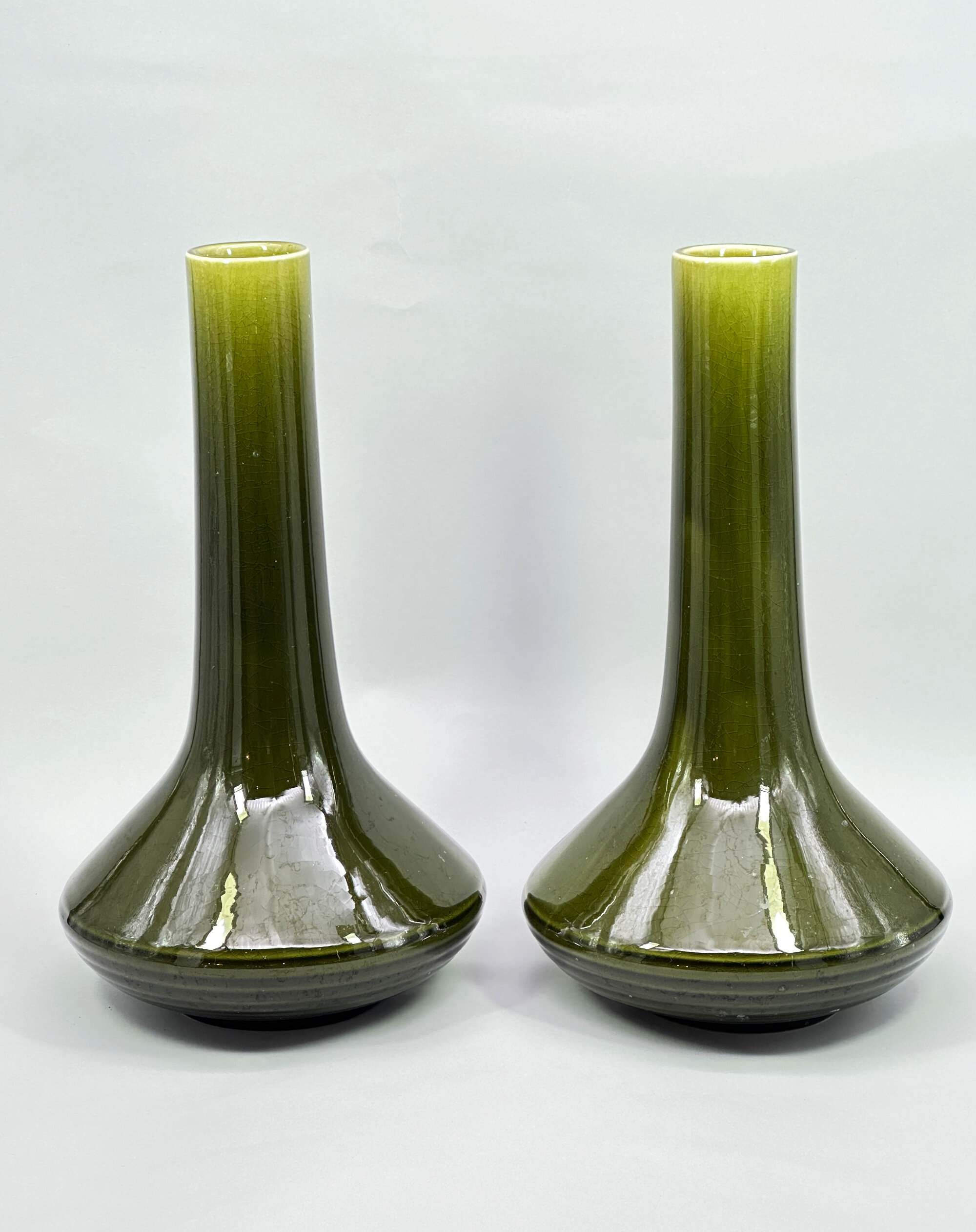
Pair of Green Glazed Bottle Vases, possibly French C20th
Price: £180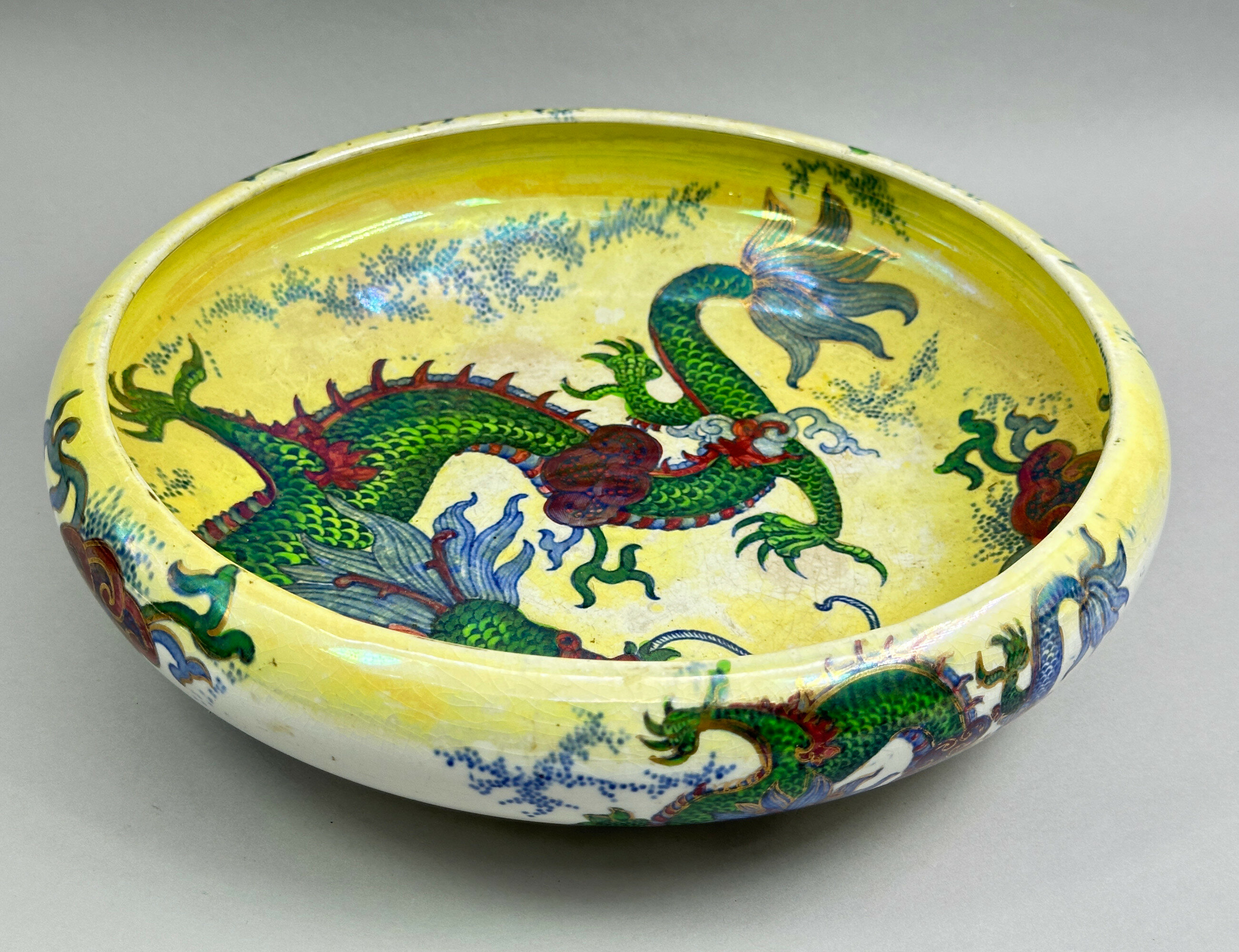
Yellow ground Bursley Ware Dragon Bowl by Frederick Rhead, circa 1920
Price: £55
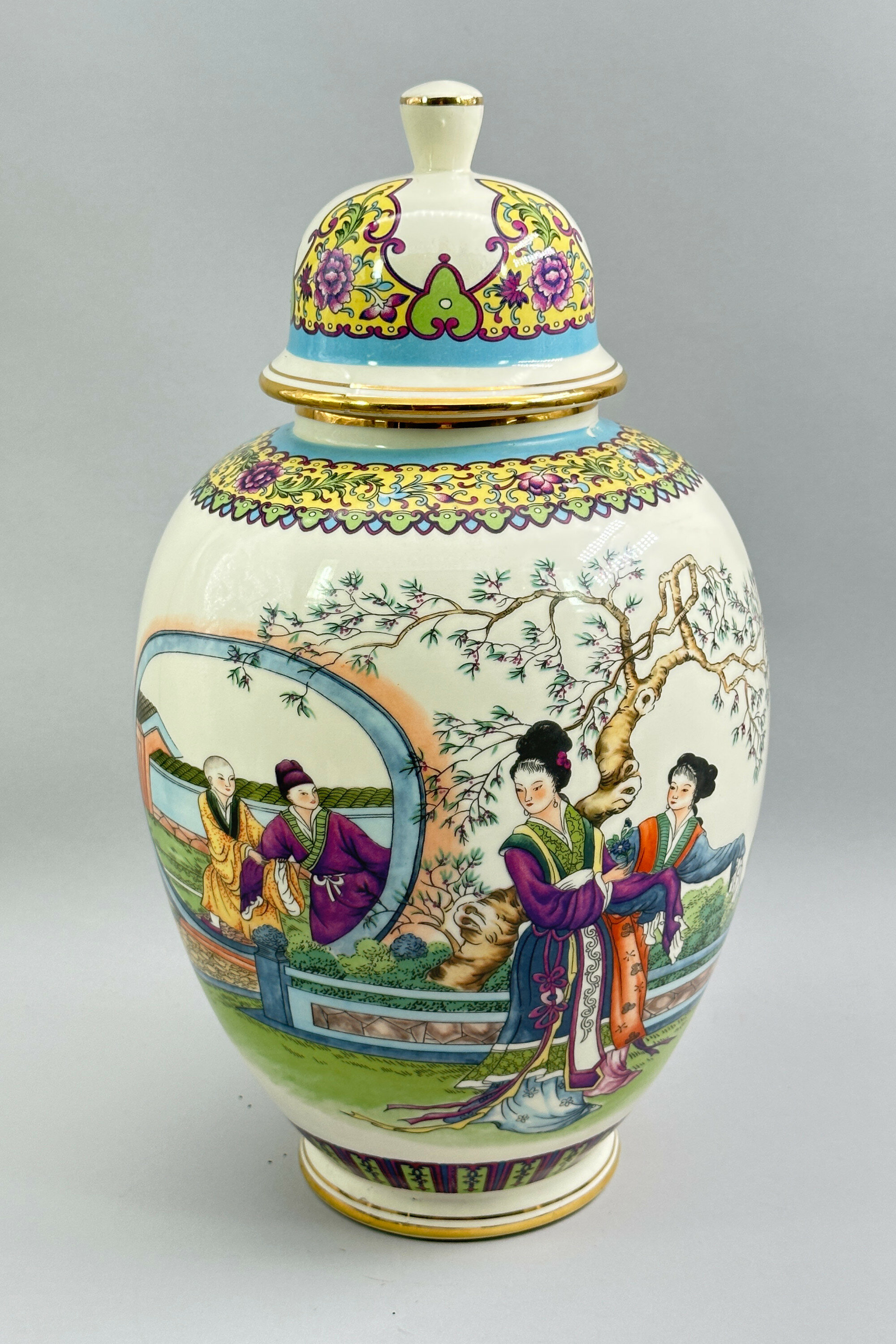
Chinese style Vase and Cover decorated with ladies and courtiers in a garden scene, C20th
Price: £55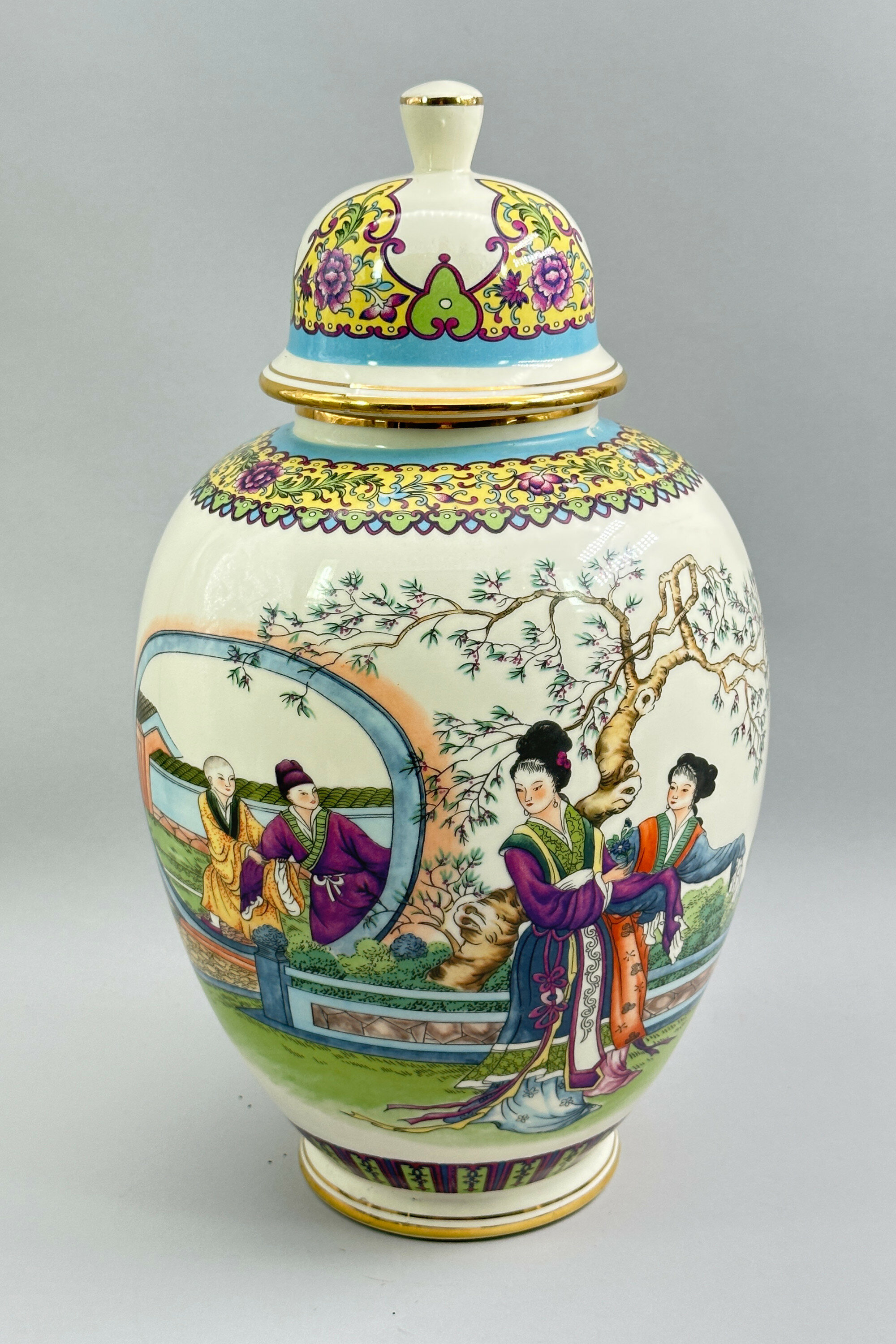
Chinese style Vase and Cover decorated with ladies and courtiers in a garden scene, C20th
Price: £55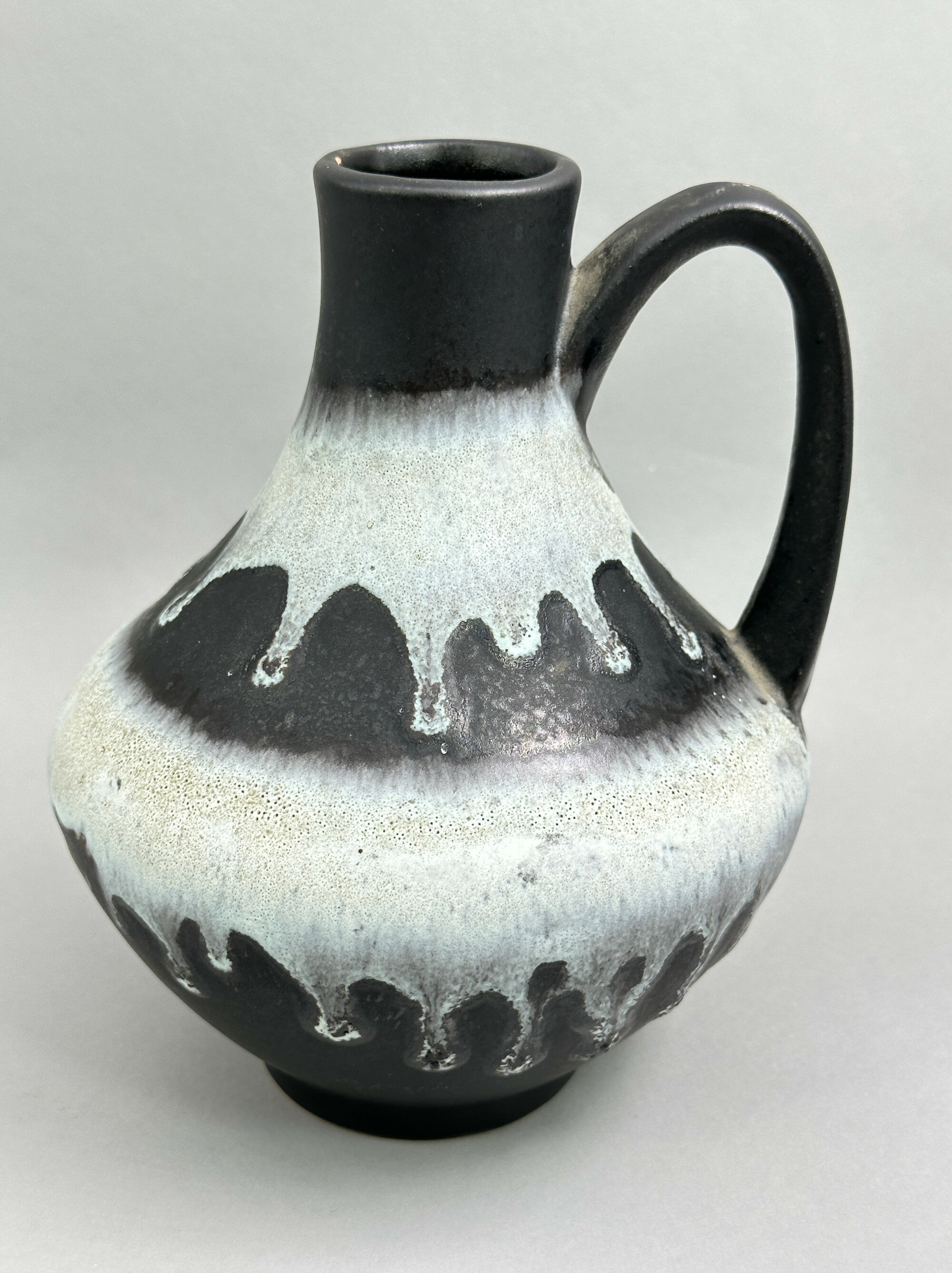
West German Keramik Jug with drip glaze, second half C20th
Price: £45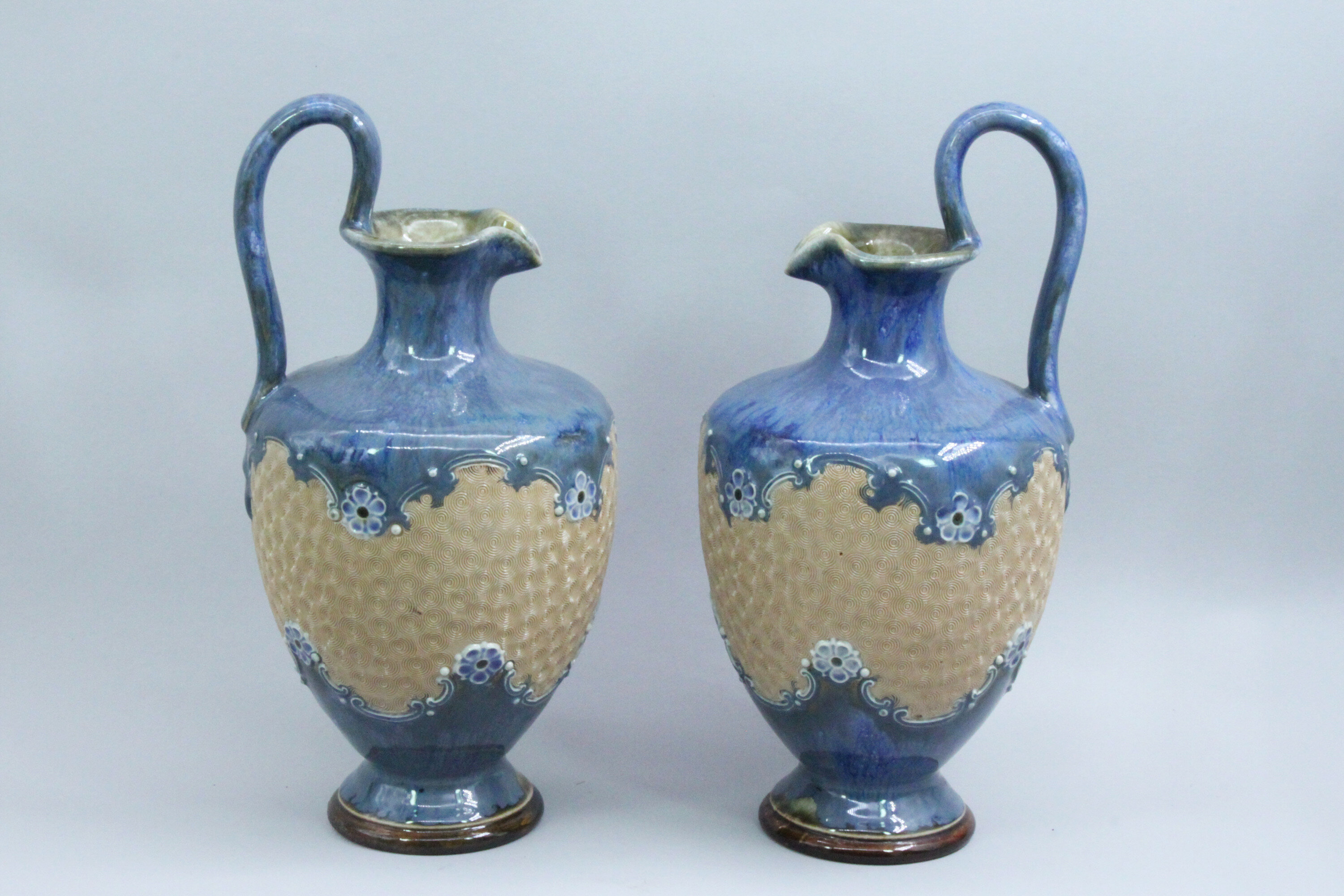
A Pair of Royal Doulton Ewers, marked, early C20th
Price: £150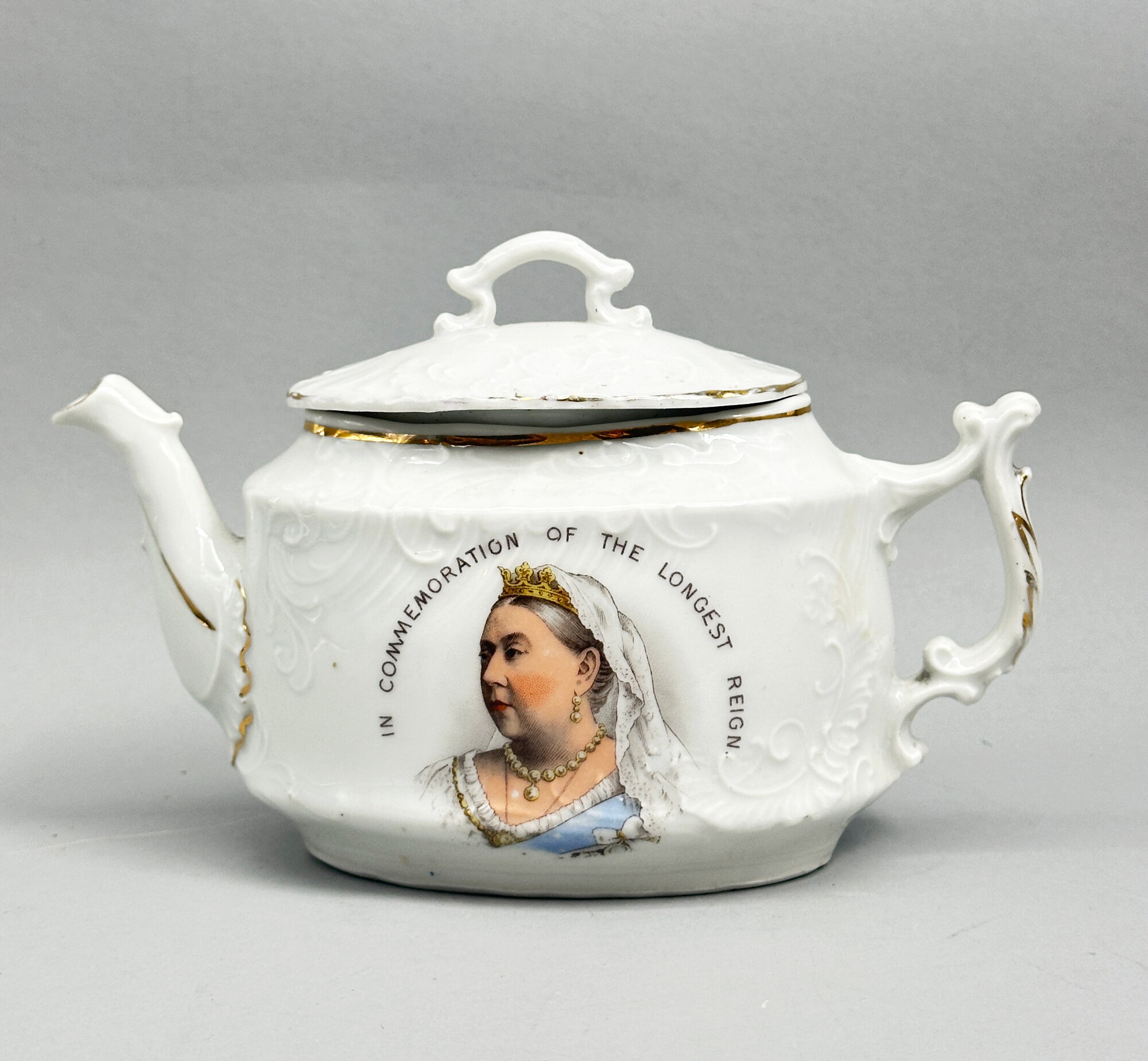
Reproduction Queen Victoria Diamond Jubilee Teapot, Modern
Price: £35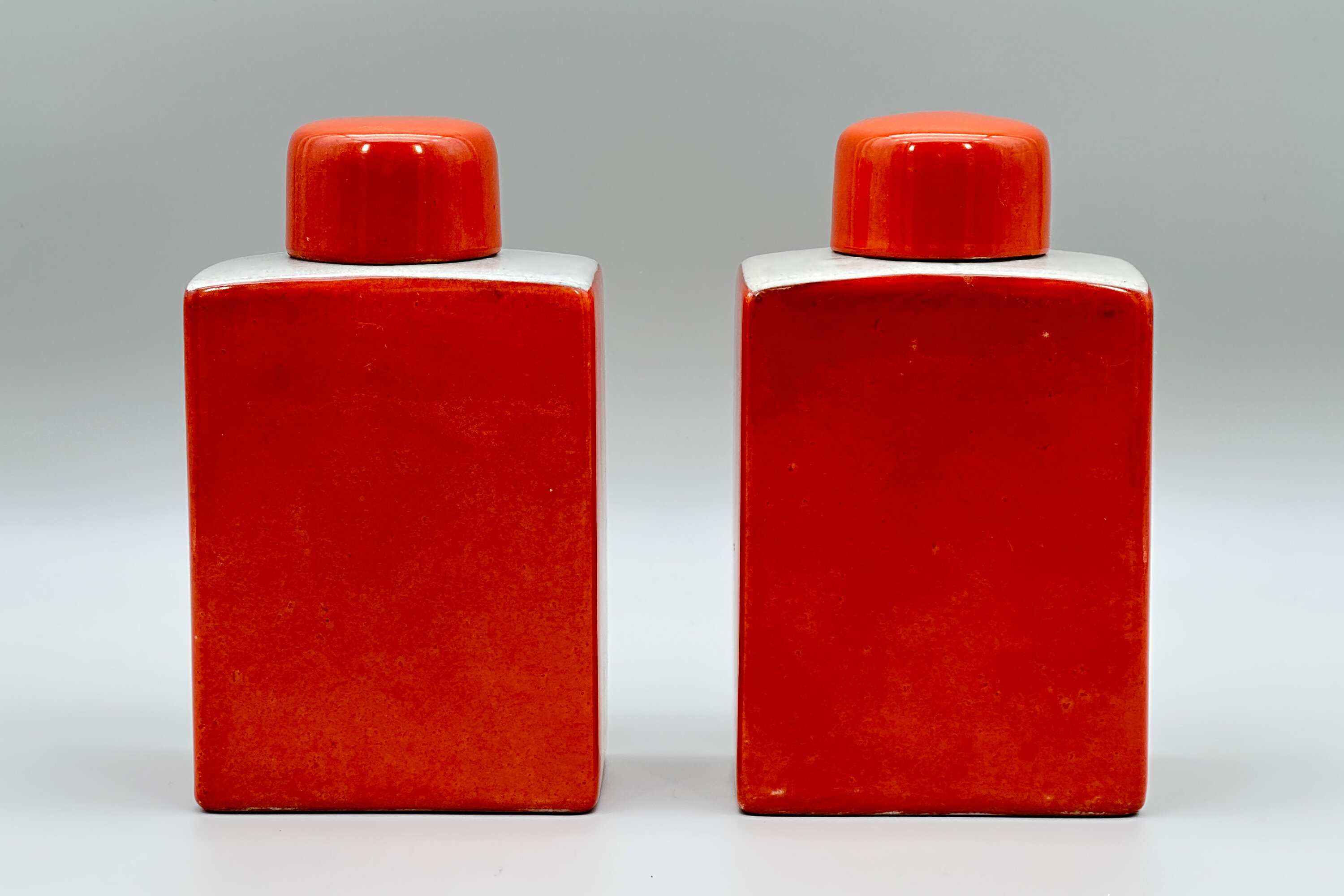
Pair of Orange Glazed Flasks and Covers, Fabienne Jouvin Paris, C20th
Price: £150The French designer Fabienne Jouvin (see image 9) graduated from the superior school of applied arts Duperré in 1985. Since then, she has travelled the world collecting designs for pieces sold and exhibited under her name internationally, with a studio based in Paris. On her website, she writes “From my travels - from Tokyo to The Habana, from the streets of Paris to the sea bed of The Maldives - I bring back sketchbooks, pads of notes, drawings and collages: hispanic or contempory architectures, faces reminding those of Piero Della Francesca, enigmatic objects non identified... These spontaneous sketchbooks give rise to unique pieces and editions painting, textile, porcelain, cloisonné...”. Her first exhibition was in 1989 and in 1996 she began an association with the firm ‘Asiatides’ allowing her to create pieces made in China and Thailand and utilising their designs and techniques.
This pair of flasks, possibly intended as tea caddies, are typical of her ability to give a ‘twist’ to the pieces from which she draws her inspiration. The shape is Chinese from the seventeenth century (see image 10), while the iron red colour is found on Chinese pieces two hundred or more years later. Combining this with a white ‘crackle glaze’, also well known from Chinese ceramics, was Jouvin’s own idea completing the mix of ancient and modern. Marked as from the Asiatides range with the stylised ‘A’, pieces like these are no longer available currently implying that they were probably made early on in her association with the firm and now have a uniqueness of their own.
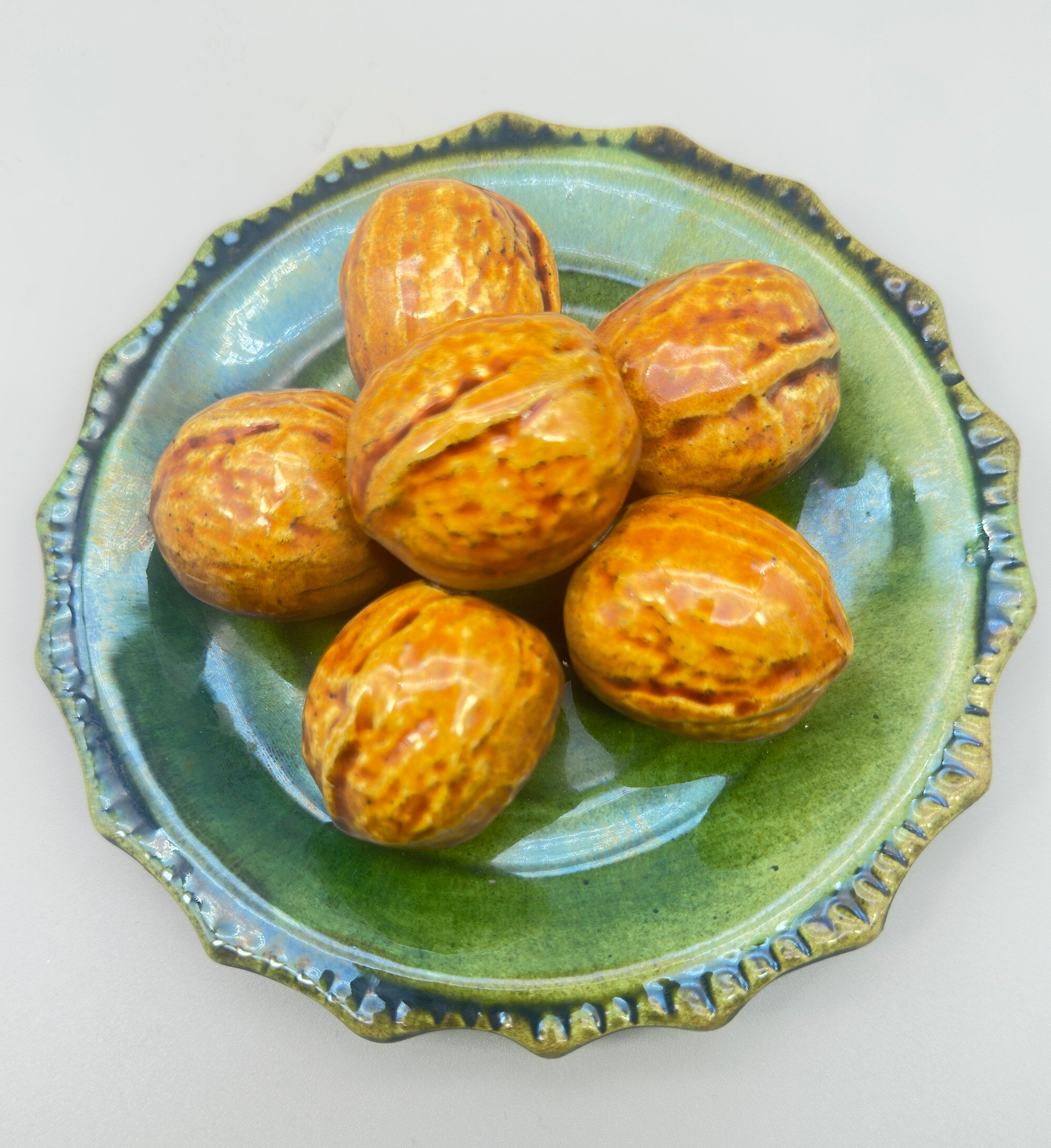
Majolica palissy style Walnut Dish, Roque Gaeiras, Portugal, second half C20th
Price: £45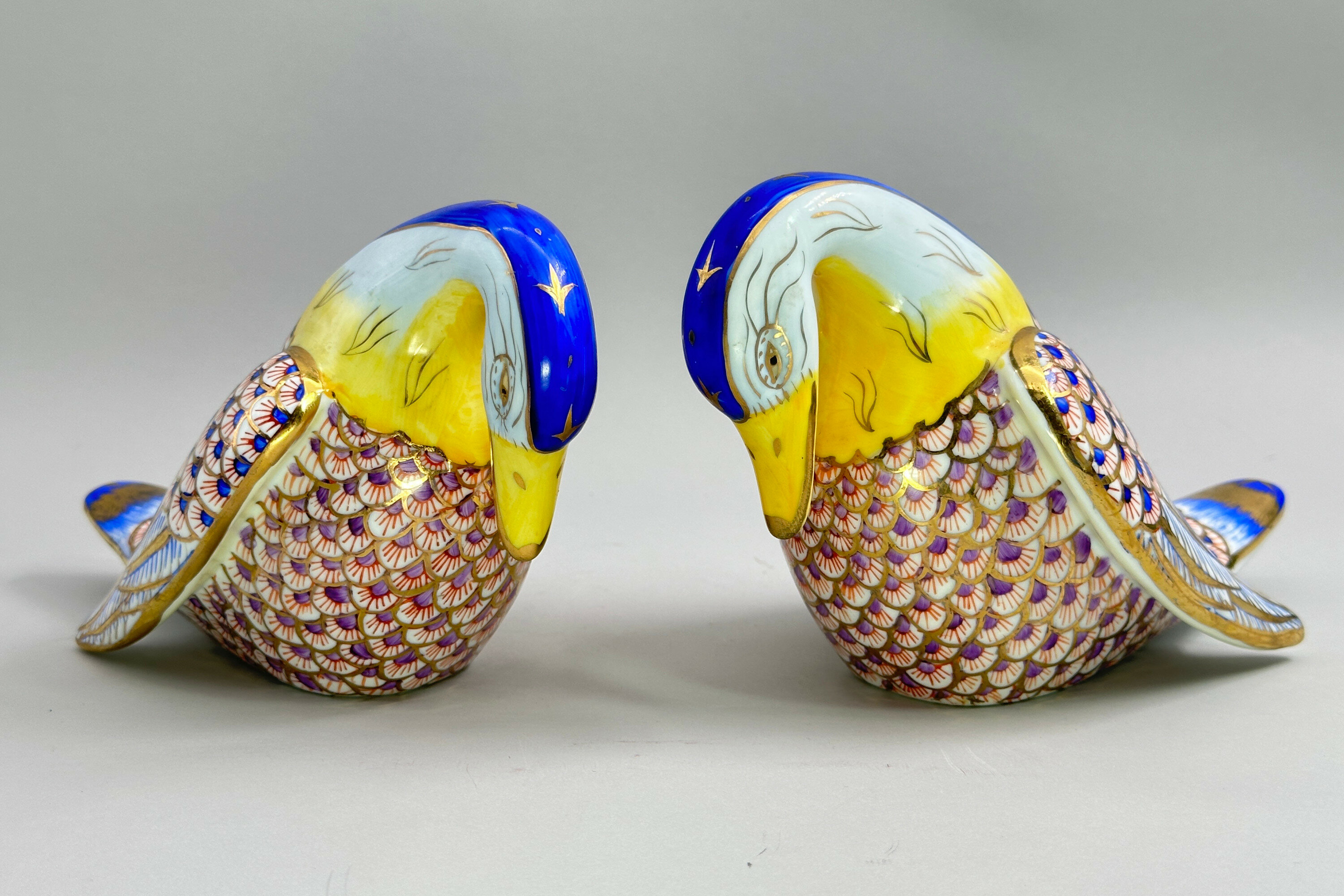
Pair of Ceramic Figures of Swans, probably continental, C20th
Price: £45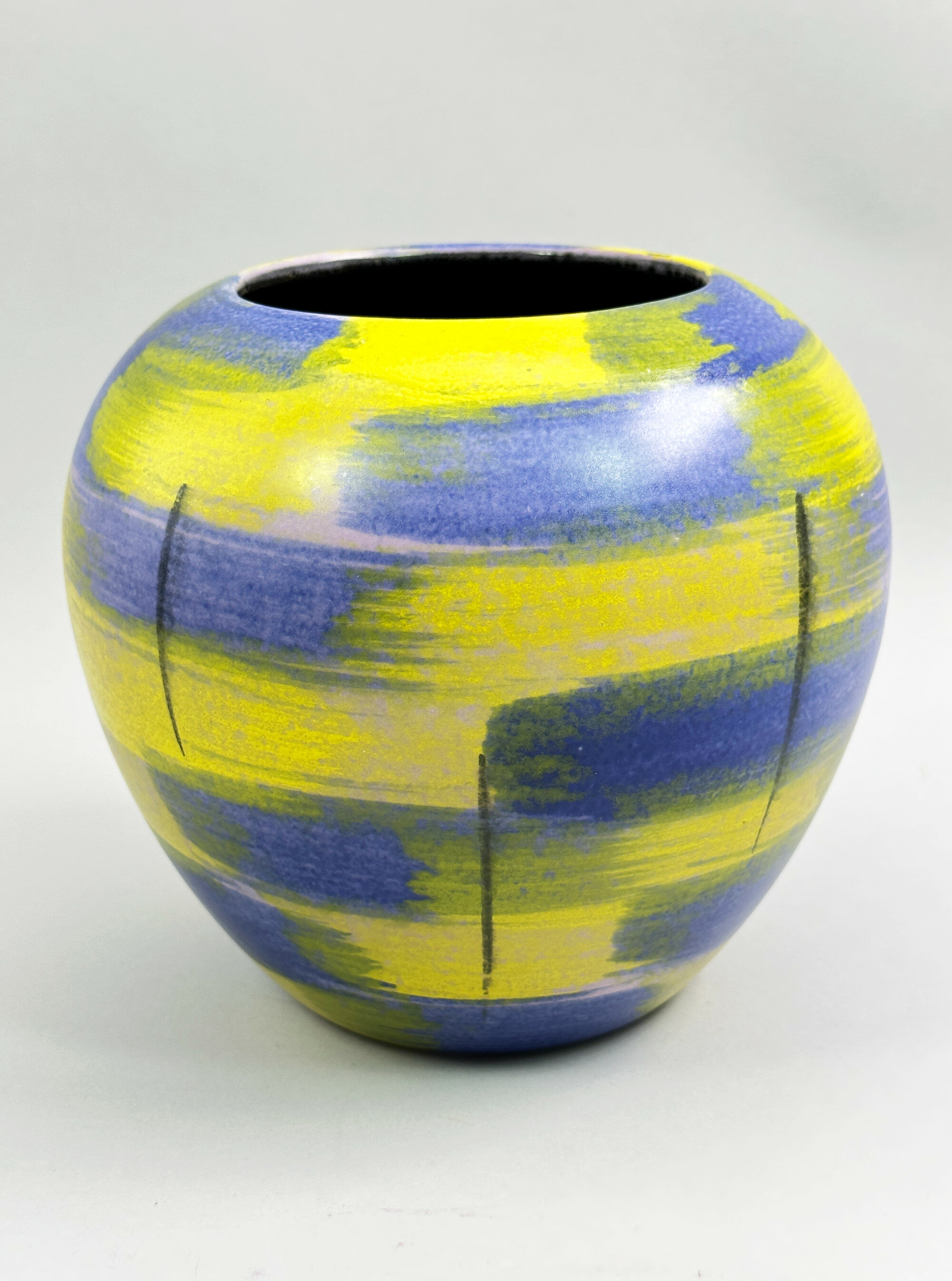
East German Ceramic Vase, VEB Haldensleben, 1950s
Price: £35The factory mark, a shallow dish superimposed over the letter 'H' inside a circle, is that of the East German pottery VEB Haldensleben. VEB stands for 'Volkseigener Betrieb', meaning a people-owned enterprise and used in relationship to the state owned workplaces in the GDR. Haldensleben is a town in Saxony-Anhalt, Germany and a ceramics factory was created there in 1945 with the nationalization of the Carstens Uffrecht plant that followed the division of Germany at the end of WWII. Halsdenleben focused primarily on the manufacture of vases. Its output tended to be of superior quality and employed more restrained glazes than those used by its West German counterparts. Upon the reunifucation of Germany in 1990, the factory was returned to its original owners, the Carstens family. The pattern number here is found on other pieces with the same shape but the abstract decoration used is quite individual and evocative of 1950s and early 1960s designs.
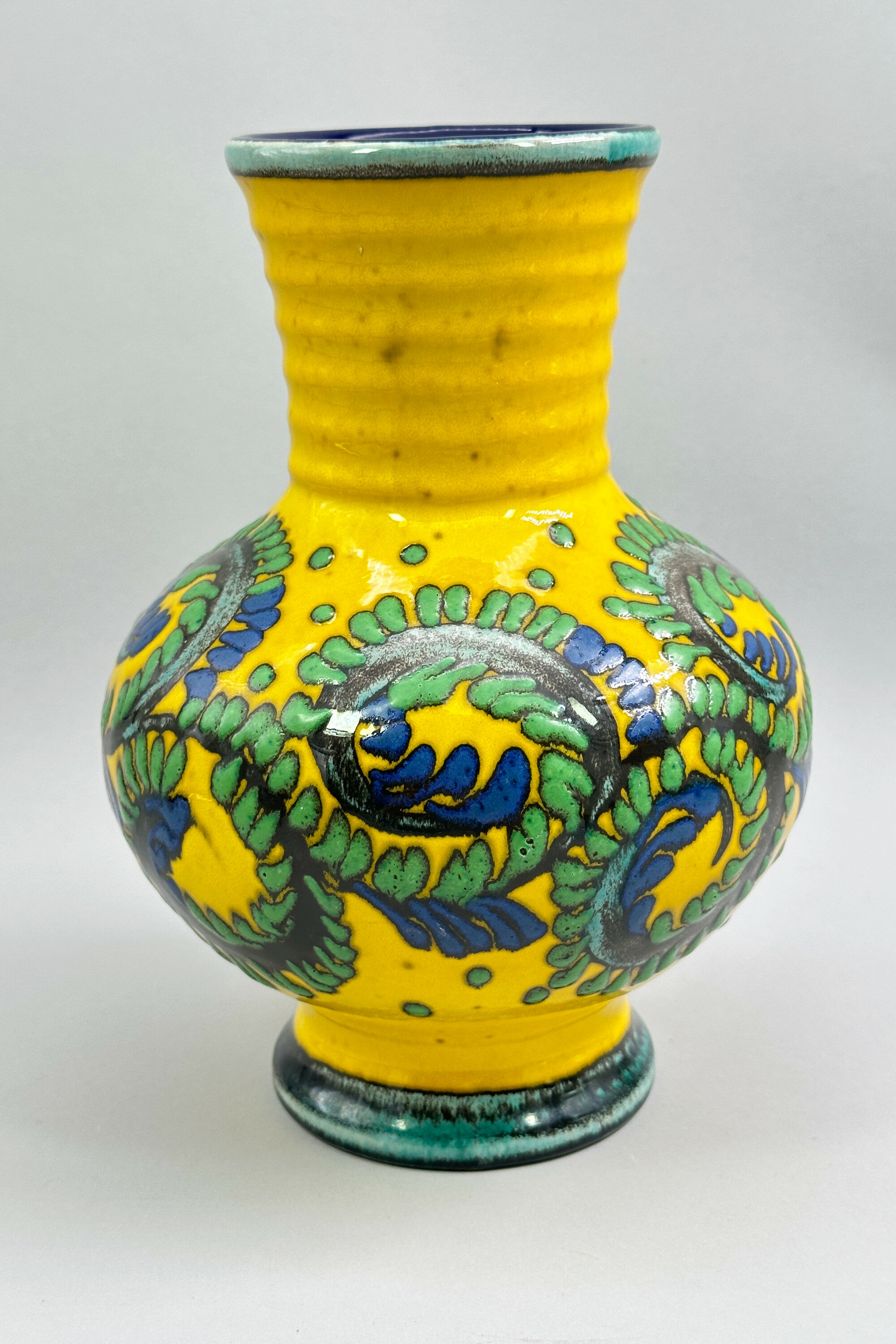
West German Ceramic Vase, Marei, 1970s
Price: £45While not stamped with a maker's mark, vases of this type are attributed to the West German Ceramics factory Marei which produced pieces from 1949 to 2016. Marei was the commonly used abbreviation for the firm's name which was Majolikafabrik Rheinbach Jean Fuss and Sohn. The pieces are distinguished by the use of a reddish clay but this was sometimes more brown or dark brown depending on the suppliers used. Marks are usually impressed into the base although these are often just pattern numbers, as here. Many pieces are unmarked and some are stamped 'MADE IN GERMANY' or 'W.GERMANY'. The pattern number here is '7104'and is found on similar pieces with the same shape but different decoration. This vase was probably made in the 1970s and is typical of the striking designs the firm produced.
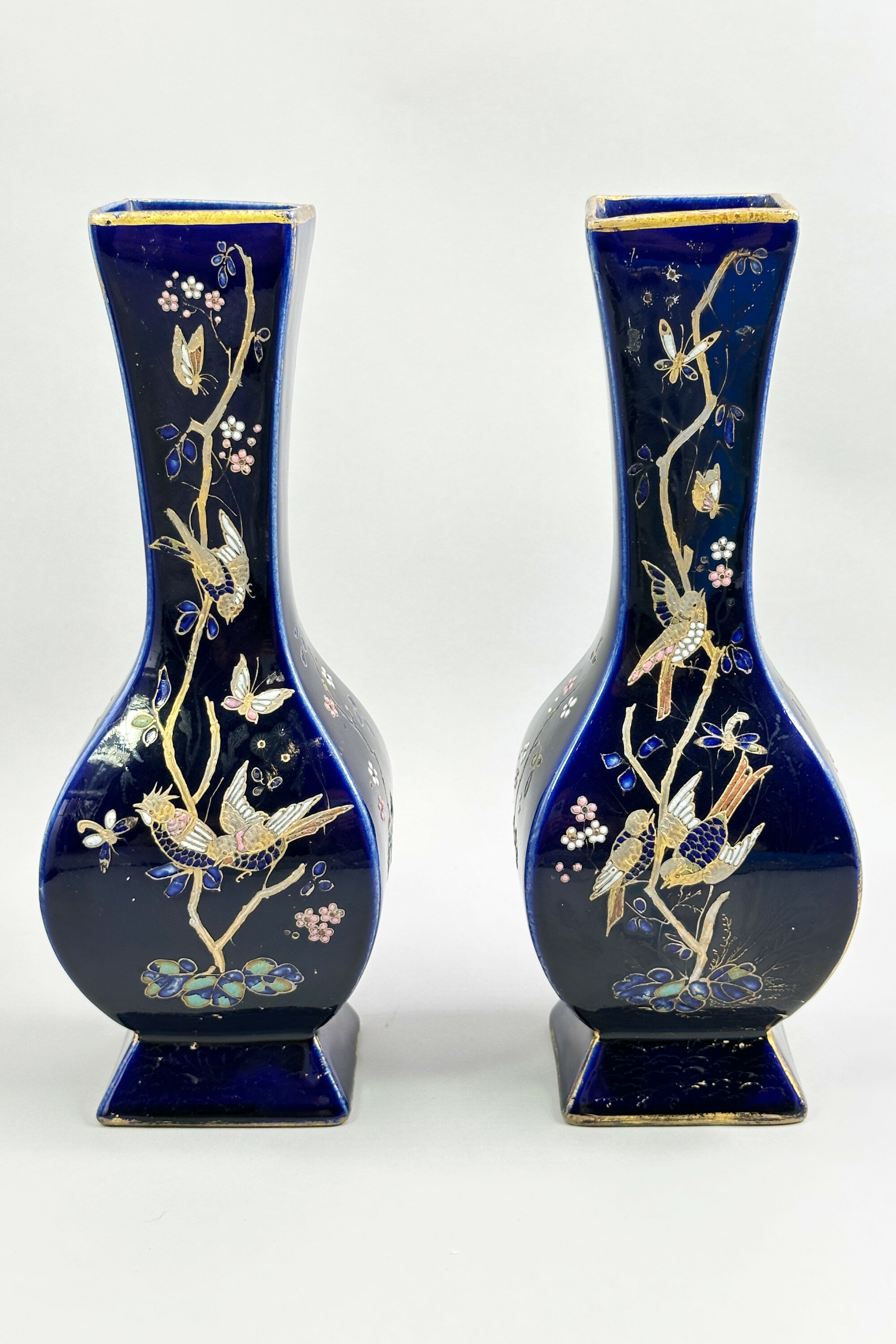
Pair of French Blue Ground Square Vases Choisy Le Roi, late C19th
Price: £45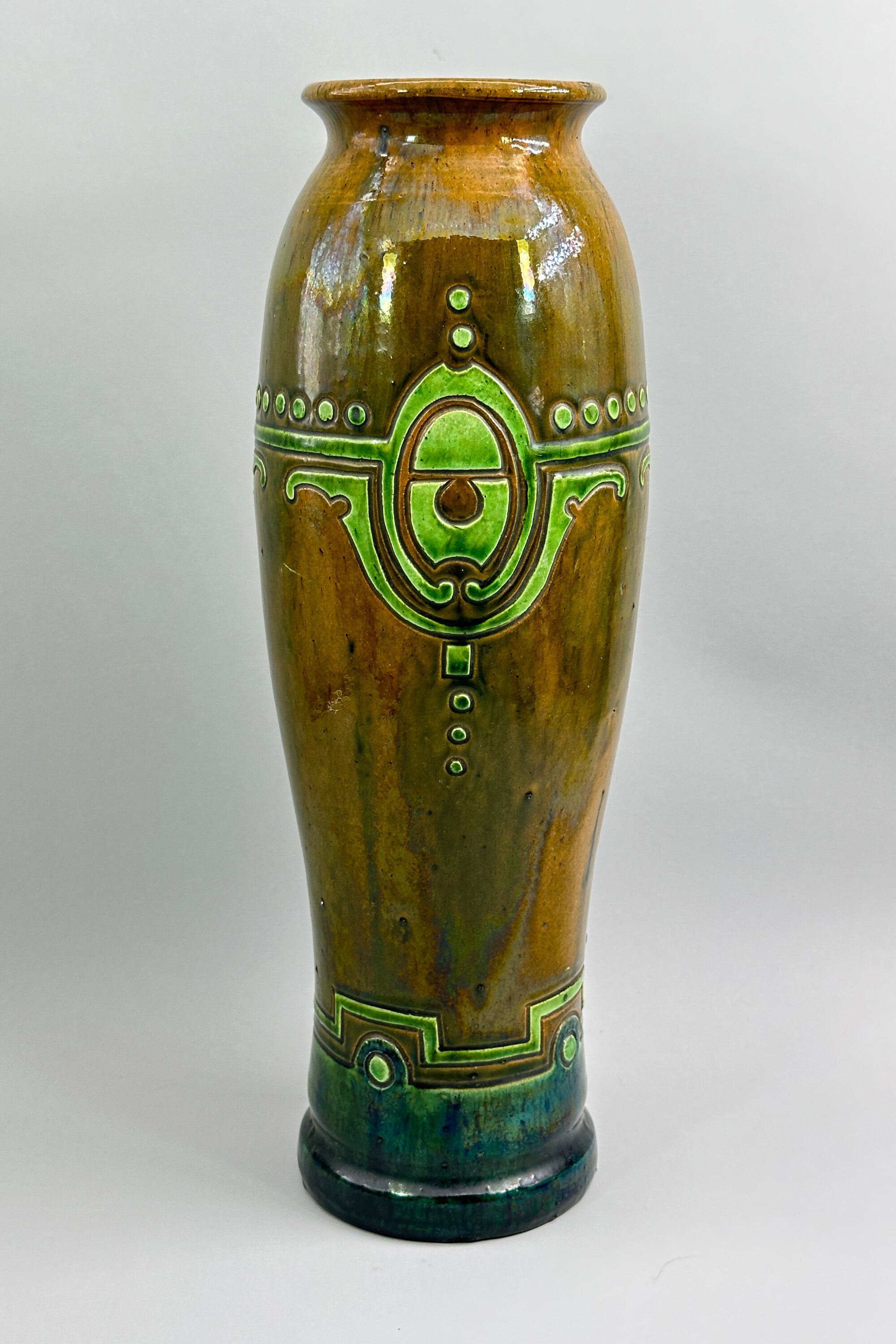
Art Pottery Vase with Geometric Motifs, C20th
Price: £55The style of decoration suggests Art Nouveau designs but there are no obvious parallels. Continental manufacture seems likely, perhaps France or Germany.
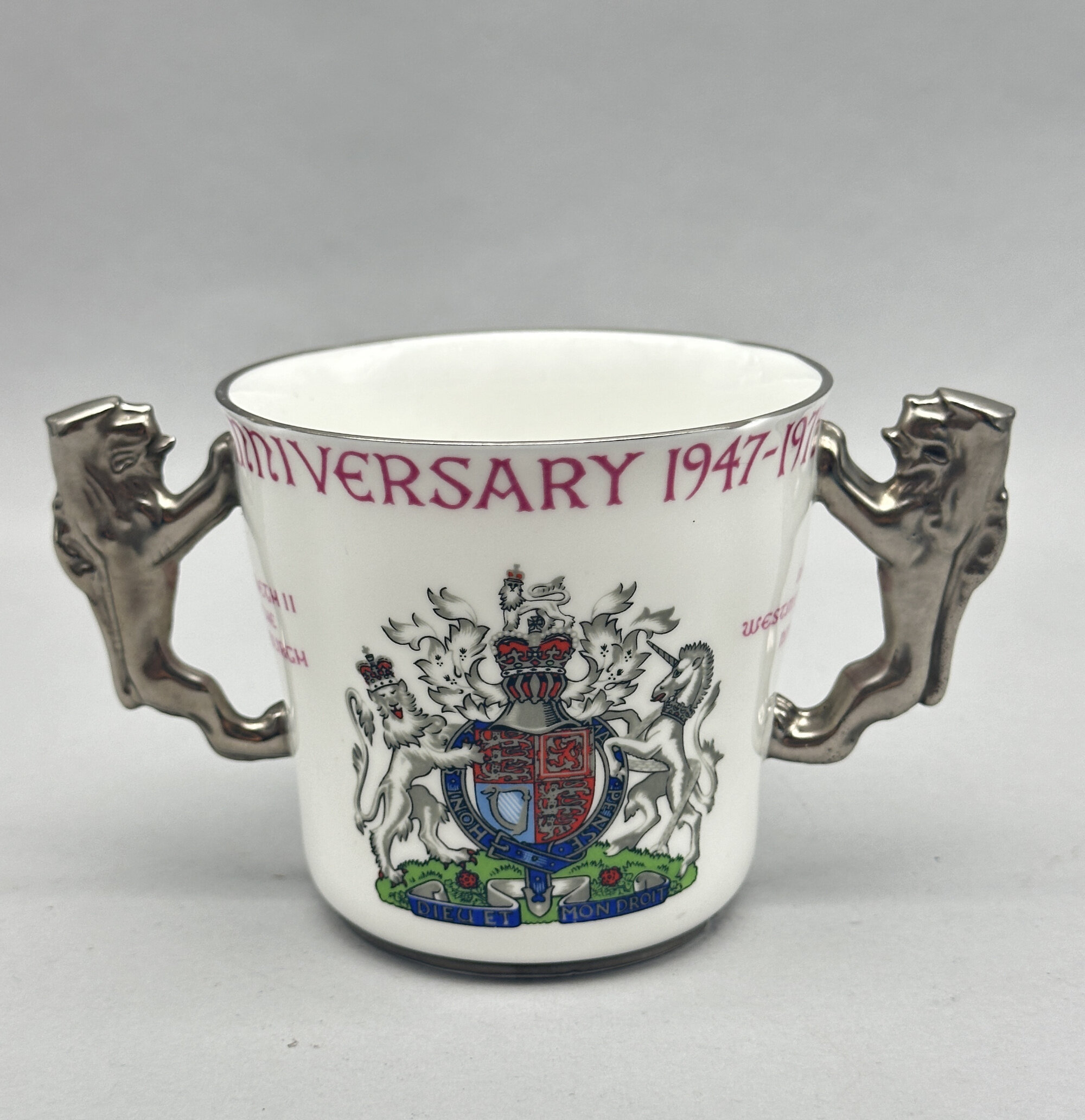
Cup : the Silver Wedding Anniversary of Queen Elizabeth II and Prince Philip in 1972
Price: £25The Paragon China Company, formerly the Star China Company (see Lot XX), produced high quality gift items from 1920 to 1971, at first independently and then in alliance with other companies, finally being absorbed by Royal Doulton in 1972 who kept the ‘Paragon’ name until 1991. Commemorative wares were a speciality and this cup is a fine and typical example.
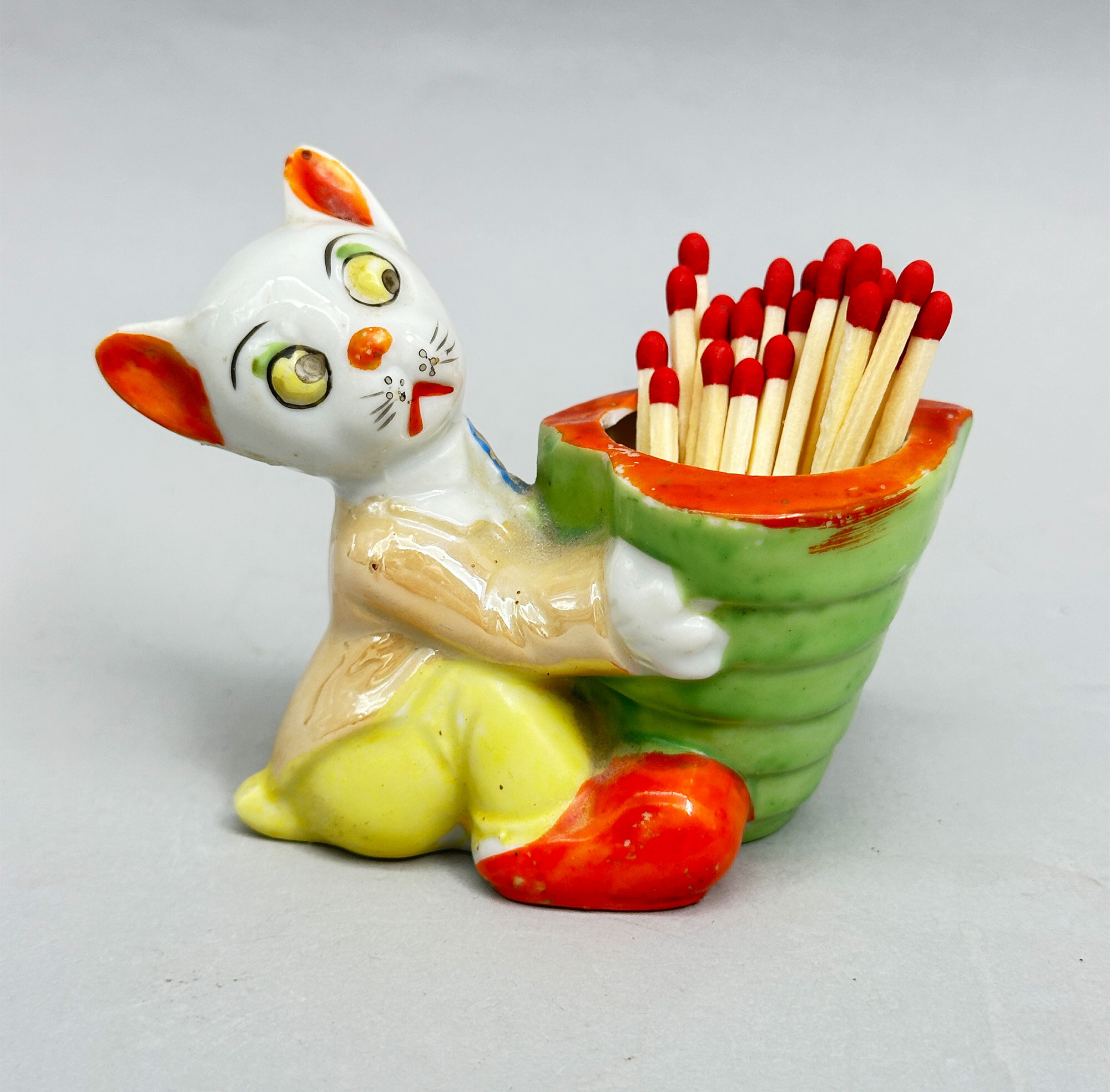
Novelty match holder with cat, Klimax Japan, mid C20th
Price: £20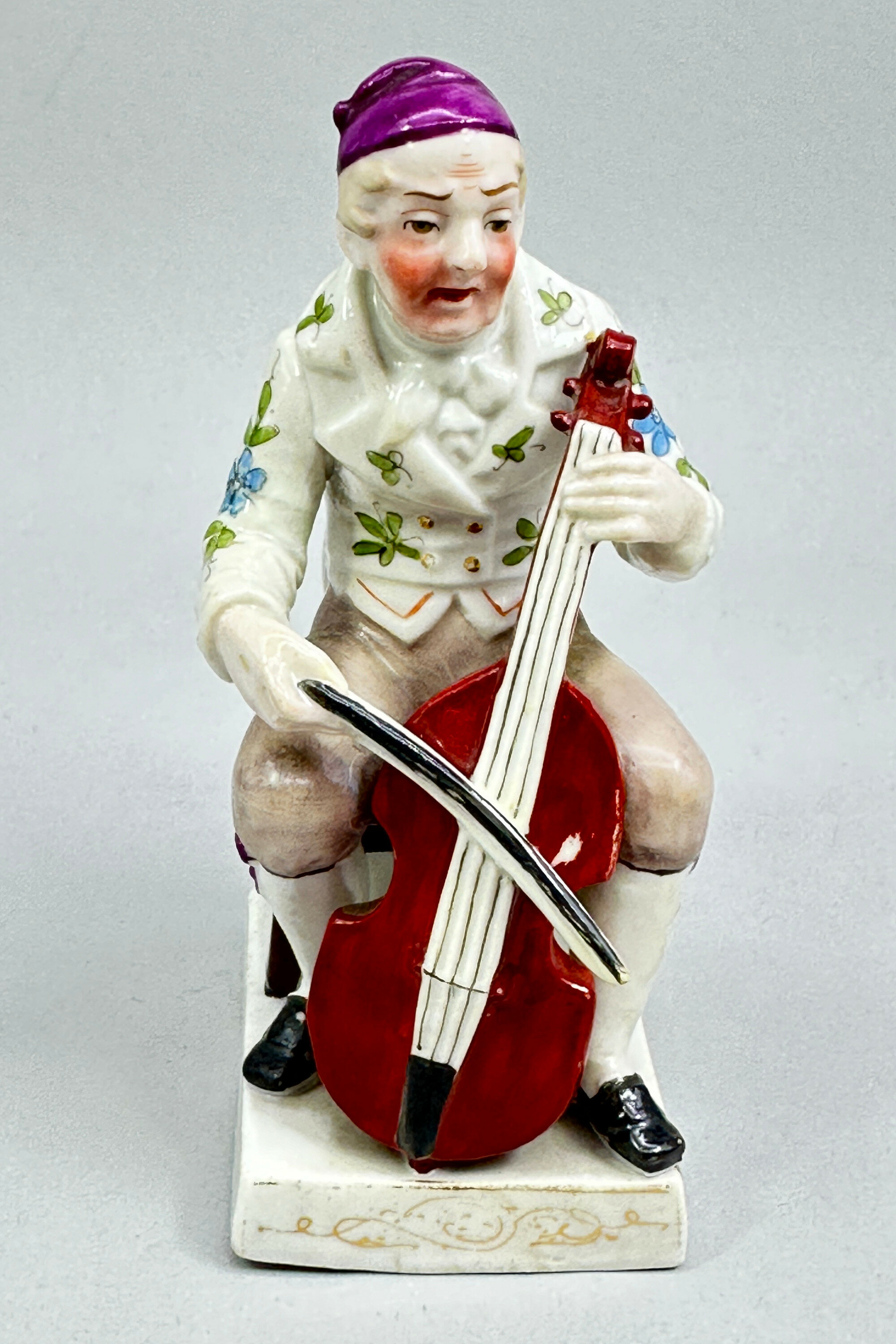
Continental Figure of a Cellist, Conta and Bohme, Germany late C19th
Price: £55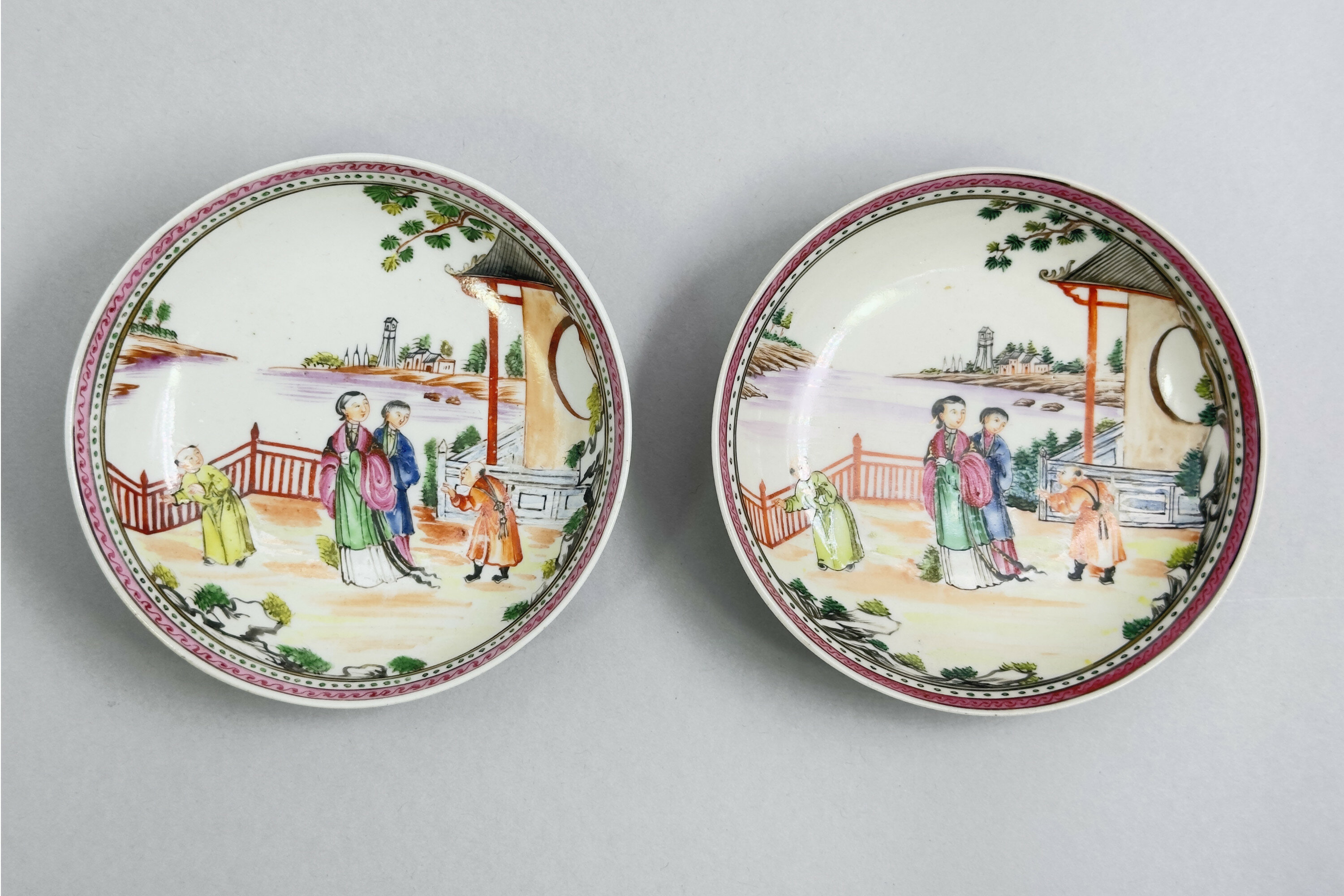
Pair of Worcester Saucers with Chinoiserie Decoration circa 1780
Price: £45While close to the Chinese originals, many features indicate European and indeed English manufacture, in particular the drawing of the ladies’ heads, the palette of colours used, the borders employed and, most importantly, the glaze and paste of the reverse. The most likely producer here was the Worcester factory whose ‘Mandarin’ pieces were well known and a circa date in the second half of the eighteenth century is reasonable. The saucers would have come from a small tea service with matching bowls and various serving items, including, of course, a teapot. Not so likely to be used now, they provide an elegant example of the vogue for Chinoiserie in England at the time.
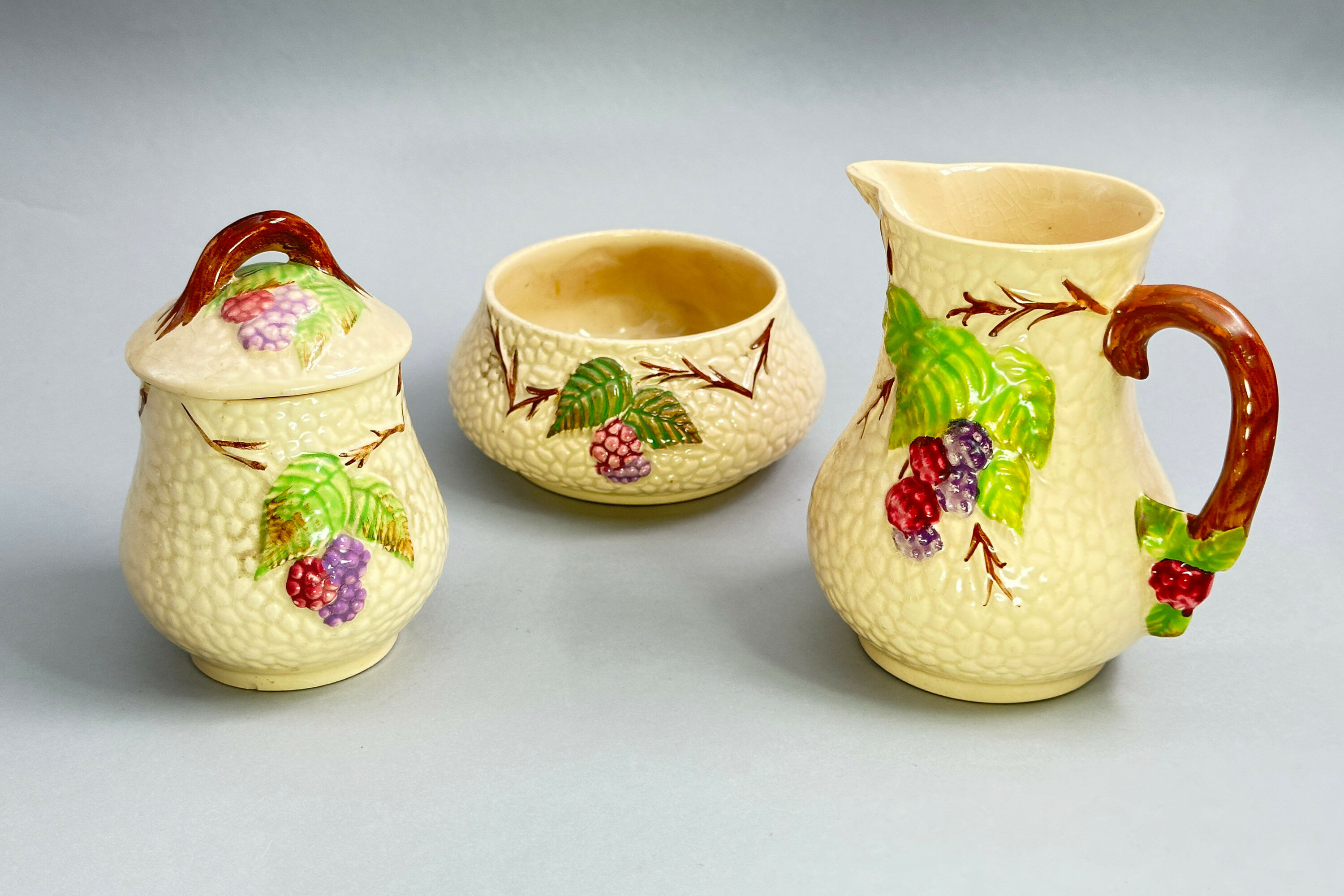
Set of three Wade Bramble Pattern teaware items, 1950s
Price: £25Wade Ceramics Ltd was a manufacturer of porcelain and earthenware, headquartered in Stoke-on-Trent, England. Founded in 1867, it was run by various members of the Wade family until the death of George Anthony Wade in 1987 after which there was a succession of management buyouts. Despite substantial investment in 2009, the firm eventually went into administration in 2022. Wade produced a wide variety of ceramics, including the well known Wade Whimsies animal figurines. A pair of Art Deco green glazed ‘salts’ are also included in this sale. The ‘Bramble’ design was created in the 1950s and a wide variety of tea service shapes were produced in the pattern. Collectors today can attempt to assemble examples from the whole of the range, towards which these three pieces might provide some assistance.
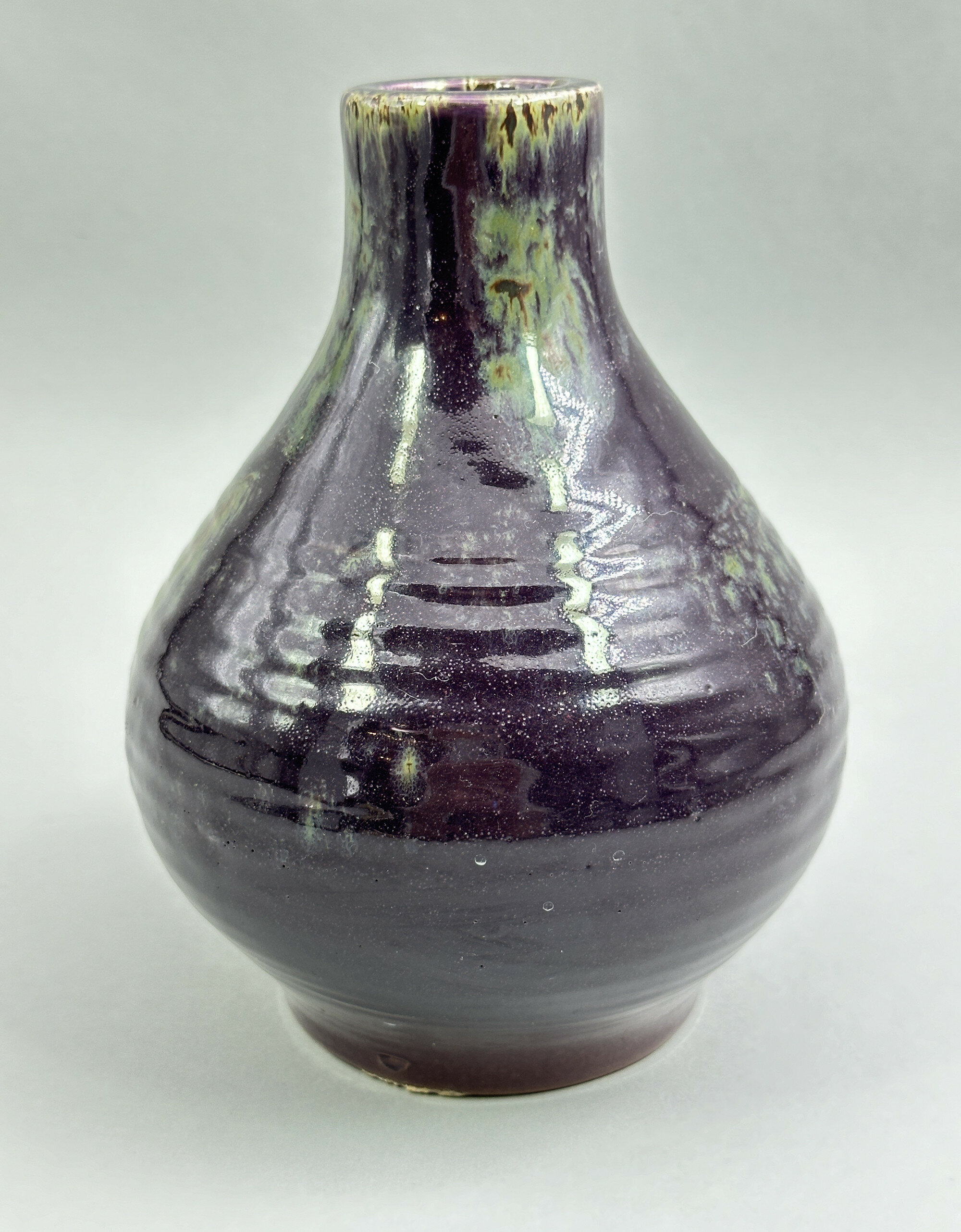
Studio Pottery Vase with flambé glaze, C20th
Price: £75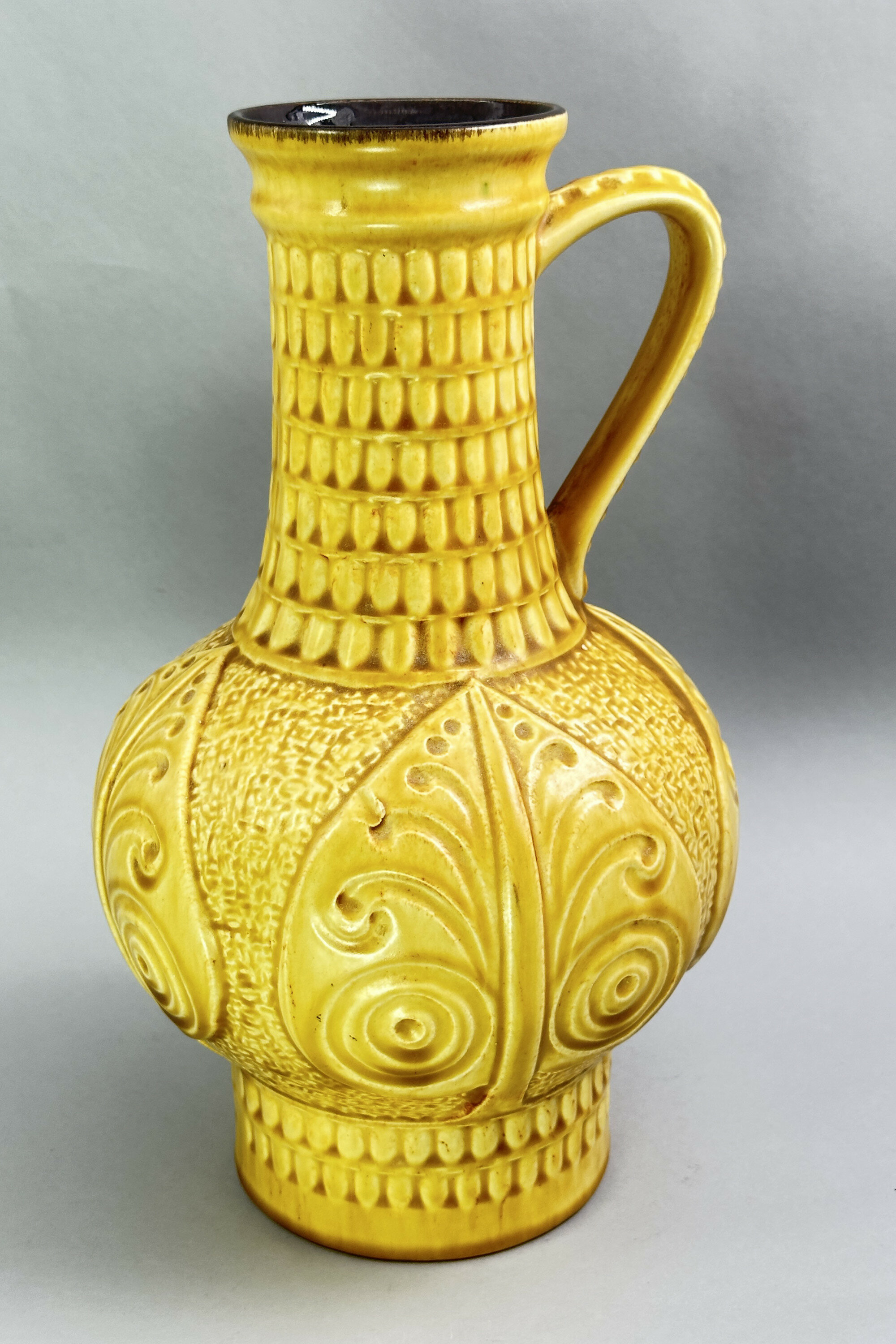
Bay Ceramic Ewer No 268-30, West Germany, 1960s
Price: £55Bay Ceramics was founded by Eduard Bay in the 1930s and based in Ransbach Baumbach, the heart of the main West German pottery producing region. Their productions included vases in a wide variety of shapes and designs which continued in production until the 1980s. Bodo Mans was amongst their most famous designers working in the 1950s and 1960s. He seems to have concentrated on organic semi abstract designs and ewers in this form, with the same pattern number but in a variety of different glazes, are attributed to him. This monochrome mustard glaze seems particularly attractive and complements the design very successfully producing a striking and decorative item which might enhance a wide variety of interior settings.
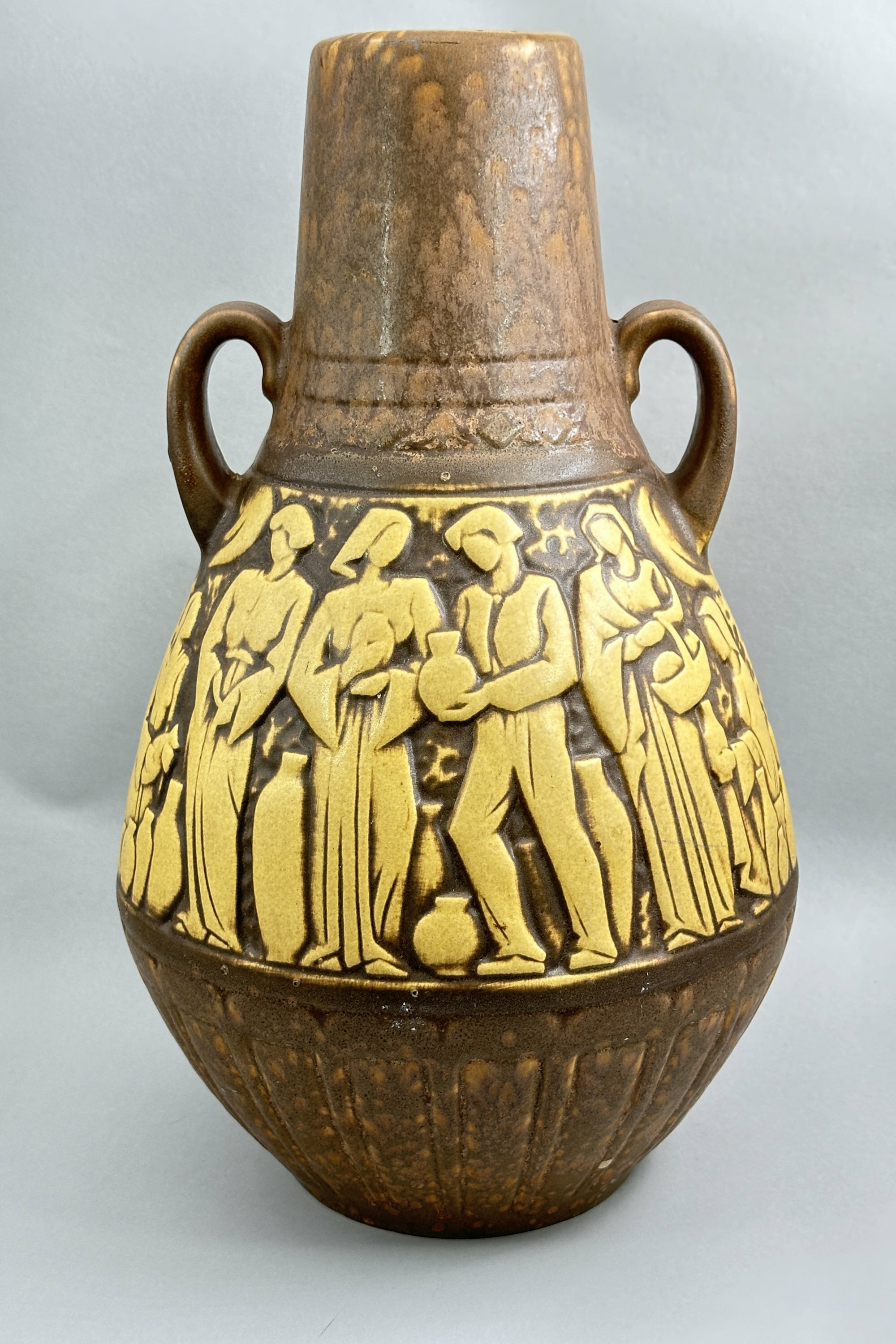
West German Scheurich Vase, Market Scene Pattern, 225-46, 1970s
Price: £150In 1954, Alois Scheurich founded the Scheurich Keramik factory, having been in partnership before then in the firm ‘Scheurich and Greulich’ (S&G) since 1927. While founded later than many of its competitors, Scheurich grew to become the principal exporter of West German ceramics through until the 1980s and beyond, making vases in a wide variety of shapes and designs. Made in the 1970s, this vase has a retrospective feel recalling Soviet designs from the 1920s and 1930s. The figures seem to be grouped in a stylised market scene with various pitchers containing perhaps wine or oil. The symbolism is unclear unless it refers to the vase itself which could be regarded as recalling the form of the Greek amphora. But whatever the ‘meaning’ we have an imposing and unusual decorative item here which stands rather apart from many of the other pieces produced by its manufacturer.
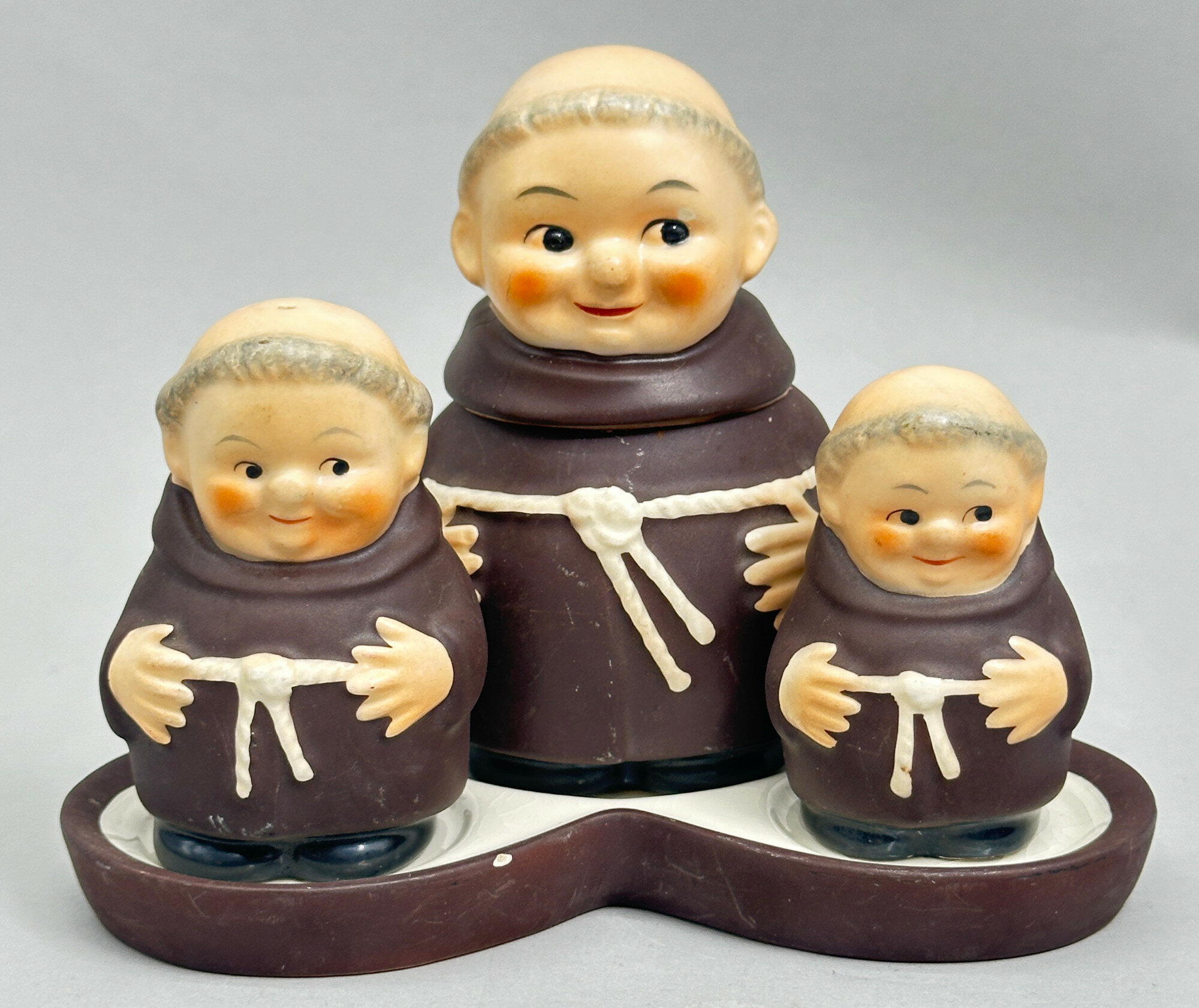
Cruet set in the form of three Friar Tuck Monks on a Tray, Hummel, West Germany, 1960s
Price: £55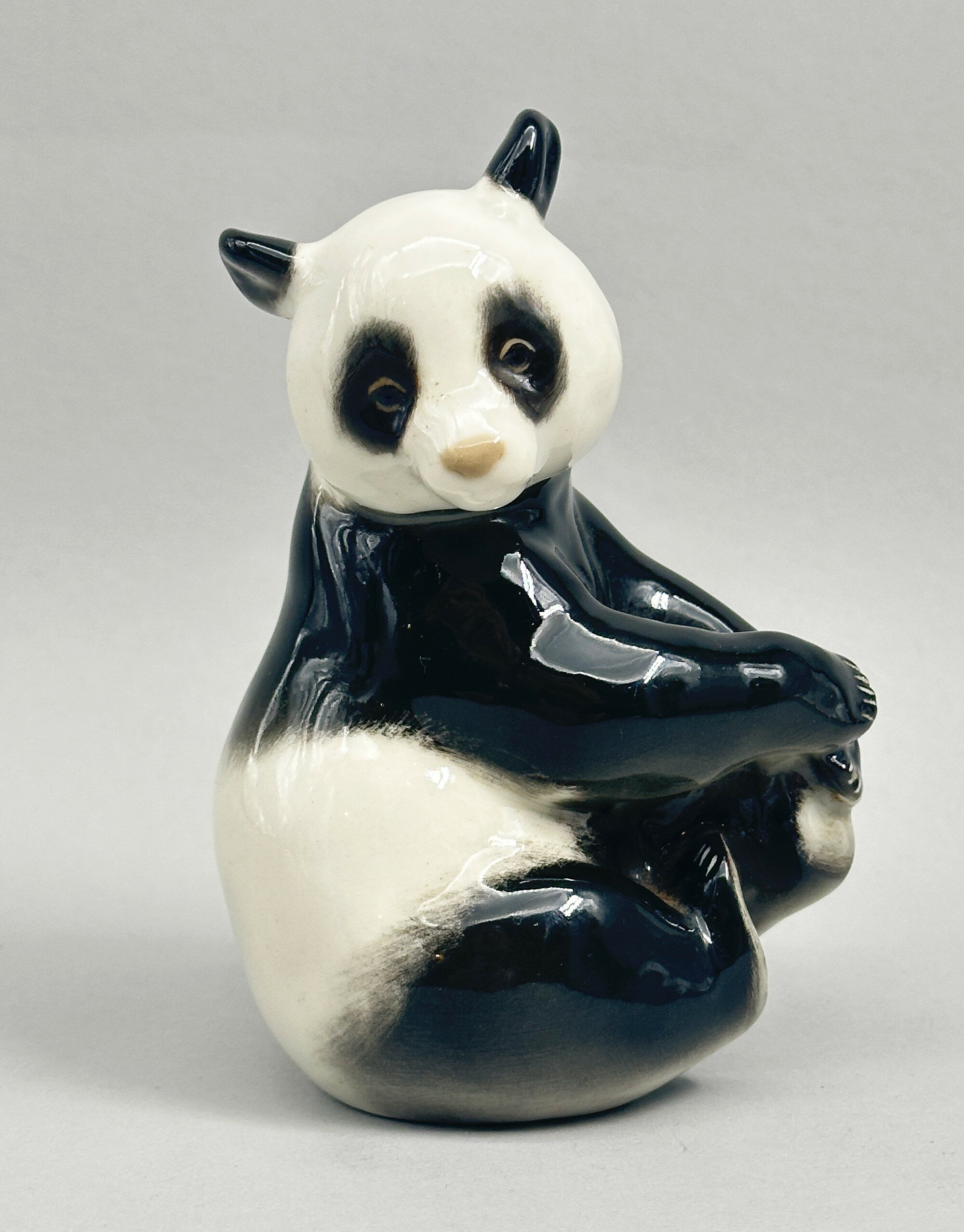
Porcelain Figure of a seated Panda, Lomonosov, USSR late C20th
Price: £25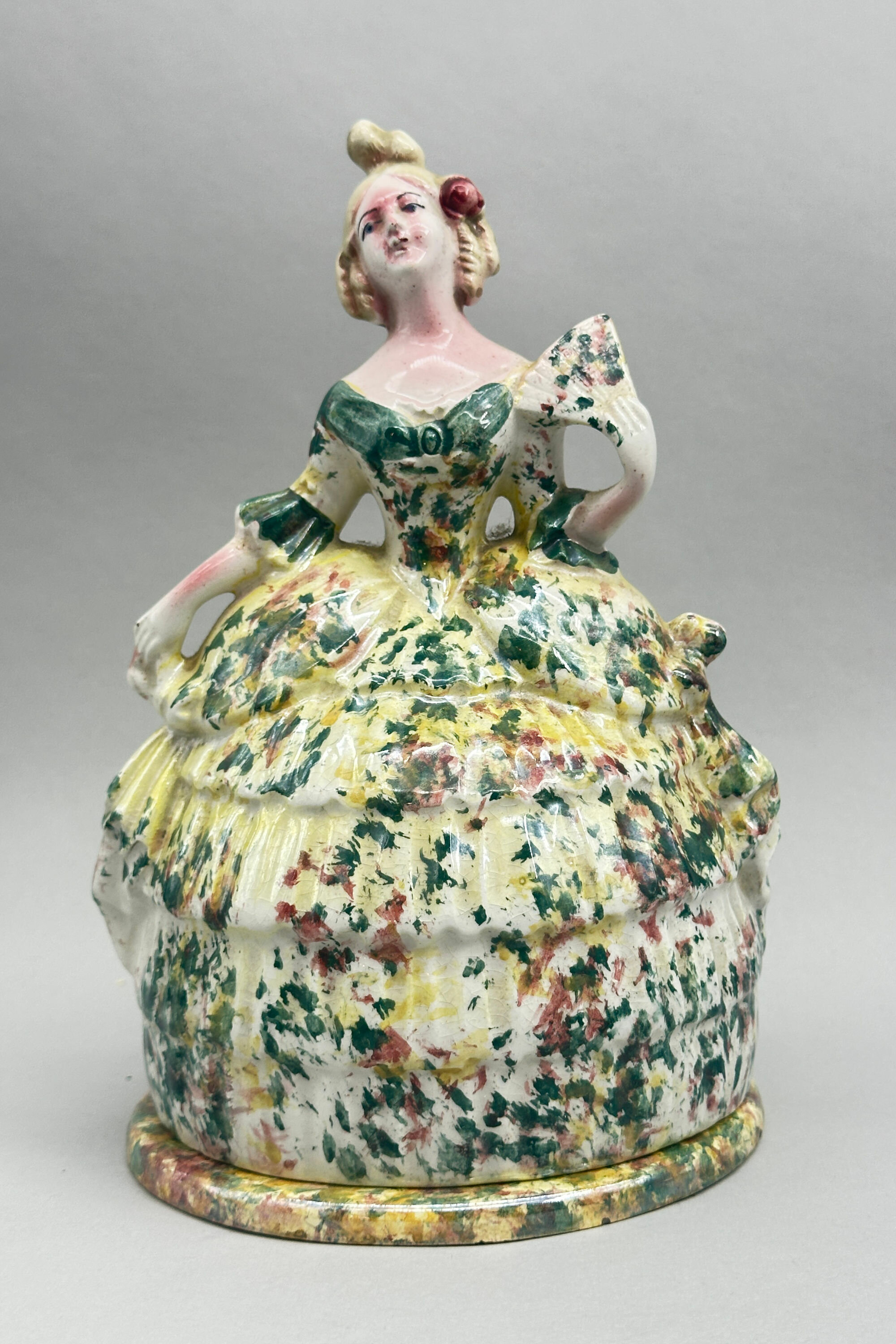
Lustreware Vanity Box, Lady in Crinoline, probably continental early/mid C20th
Price: £35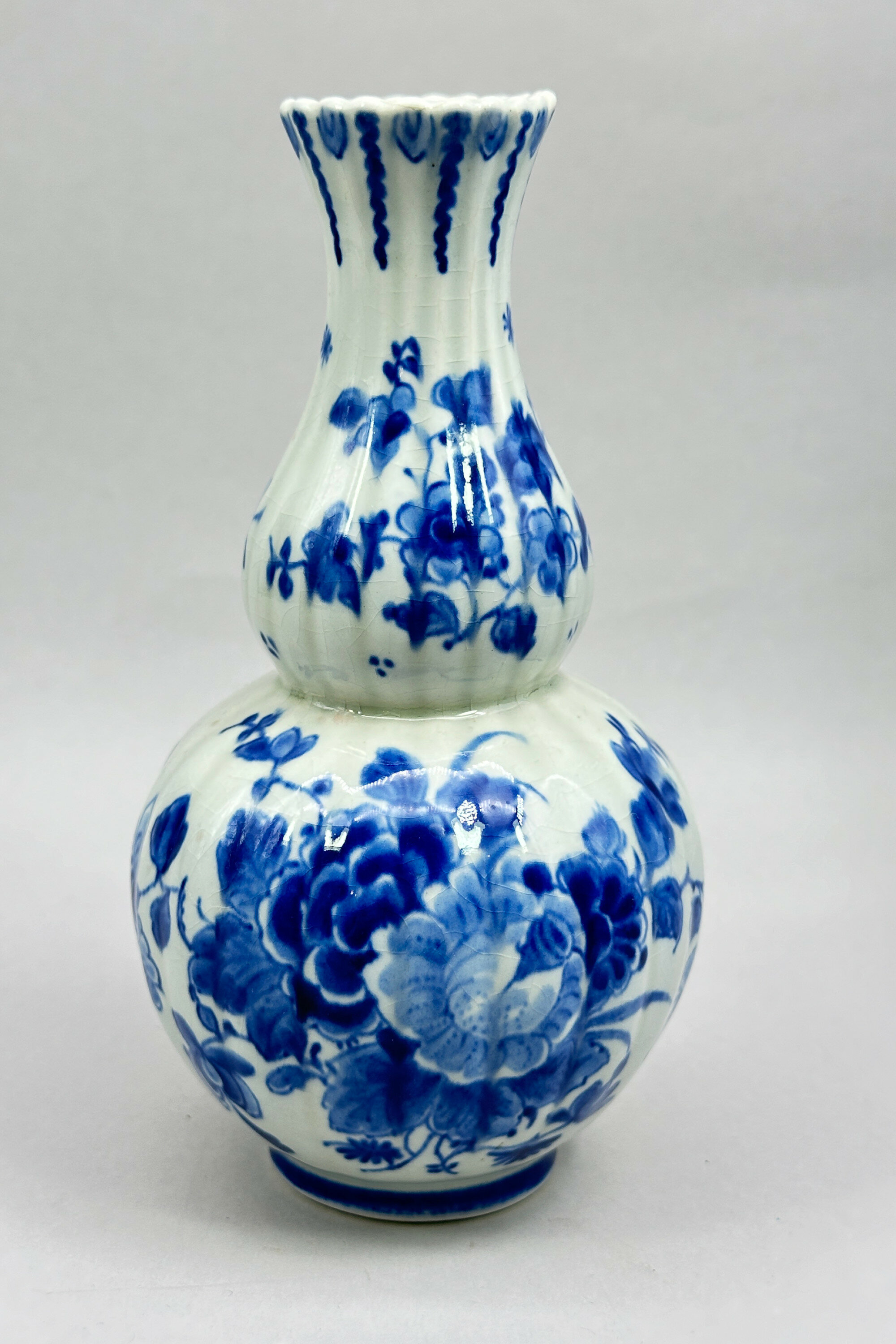
Dutch Delft Blue and White Gourd Vase in C18th Style, late C20th
Price: £25This vase is typical of one of these later creations and copies an eighteenth century original which itself was based on Chinese pieces. The marks underneath, although some of them are blurred, offer a clue to the dating. Below an ‘A’ at the top can be seen a vase which stands for ‘De Porcelyne Fles (The Porcelain Bottle) a factory which was established in 1653 and continues production today. There follow the initials ‘JT’ as a monogram standing for Joost Thooft who bought the factory in 1876 and below this ‘Delft’. At the bottom are usually found the painter’s initials to the left and letters to the right which are the date mark. On this vase these are unclear but the painter’s initials read ‘MA’ which appears to stand for M.H.van Aalst who worked for the firm from 1941to 1983. This would fit with a likely dating here to the second half of the twentieth century, but the artist has successfully recreated the work of his predecessors and produced a piece of great charm.
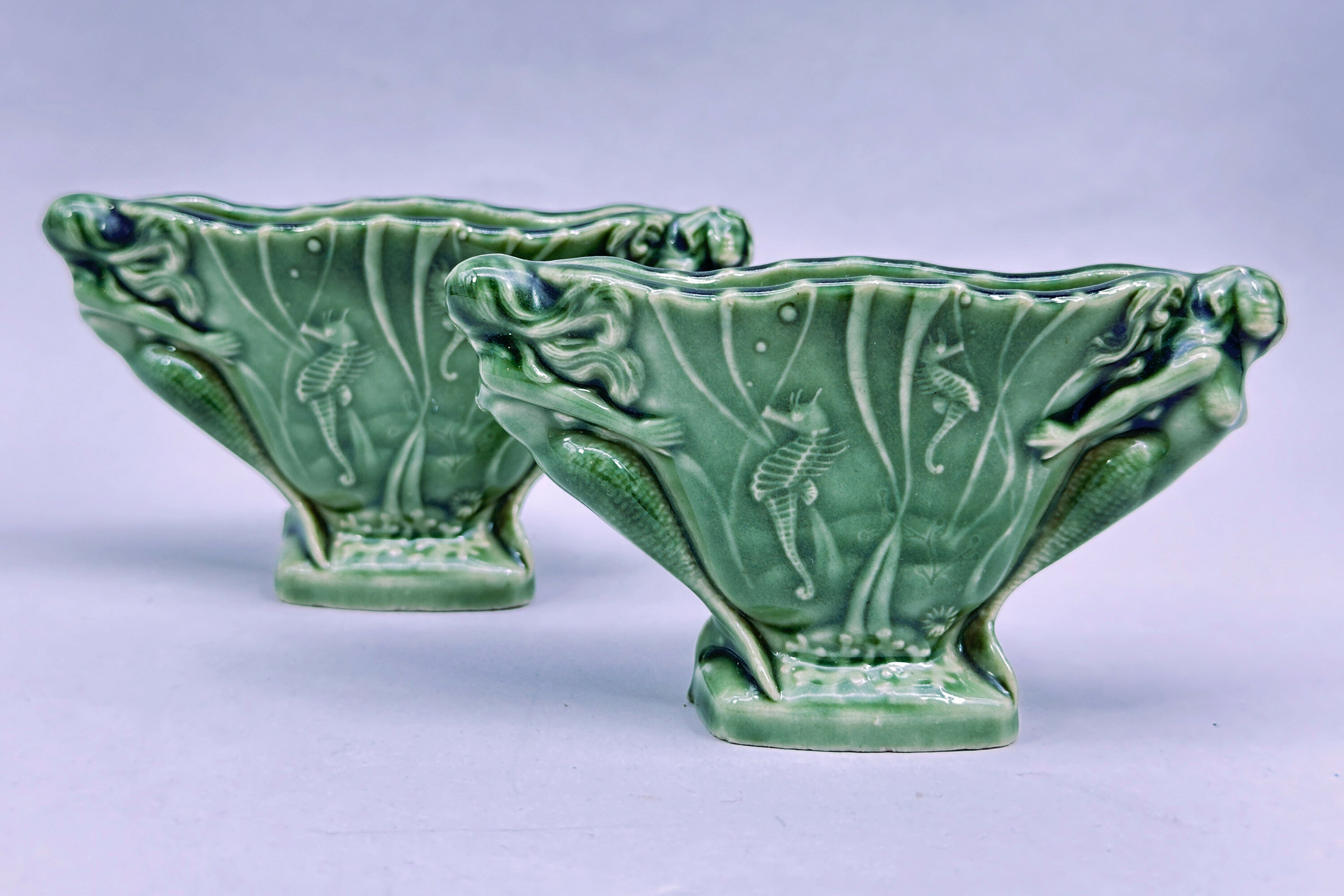
Pair of Wade green glazed Mermaid salts, 1950s
Price: £55Wade Ceramics Ltd was a manufacturer of porcelain and earthenware, headquartered in Stoke-on-Trent, England. Founded in 1867, it was run by various members of the Wade family until the death of George Anthony Wade in 1987 after which there was a succession of management buyouts. Despite substantial investment in 2009, the firm eventually went into administration in 2022. Wade produced a wide variety of ceramics, including the well known Wade Whimsies animal figurines.
This pair of salts is rather different to many of their productions and have a distinctly ‘Art Nouveau’ feel but, in fact, date to the 1950s when this particular format of the factory mark was used. It seems to be one of the rarer forms and pairs are even rarer still, so definitely one for Wade collectors!
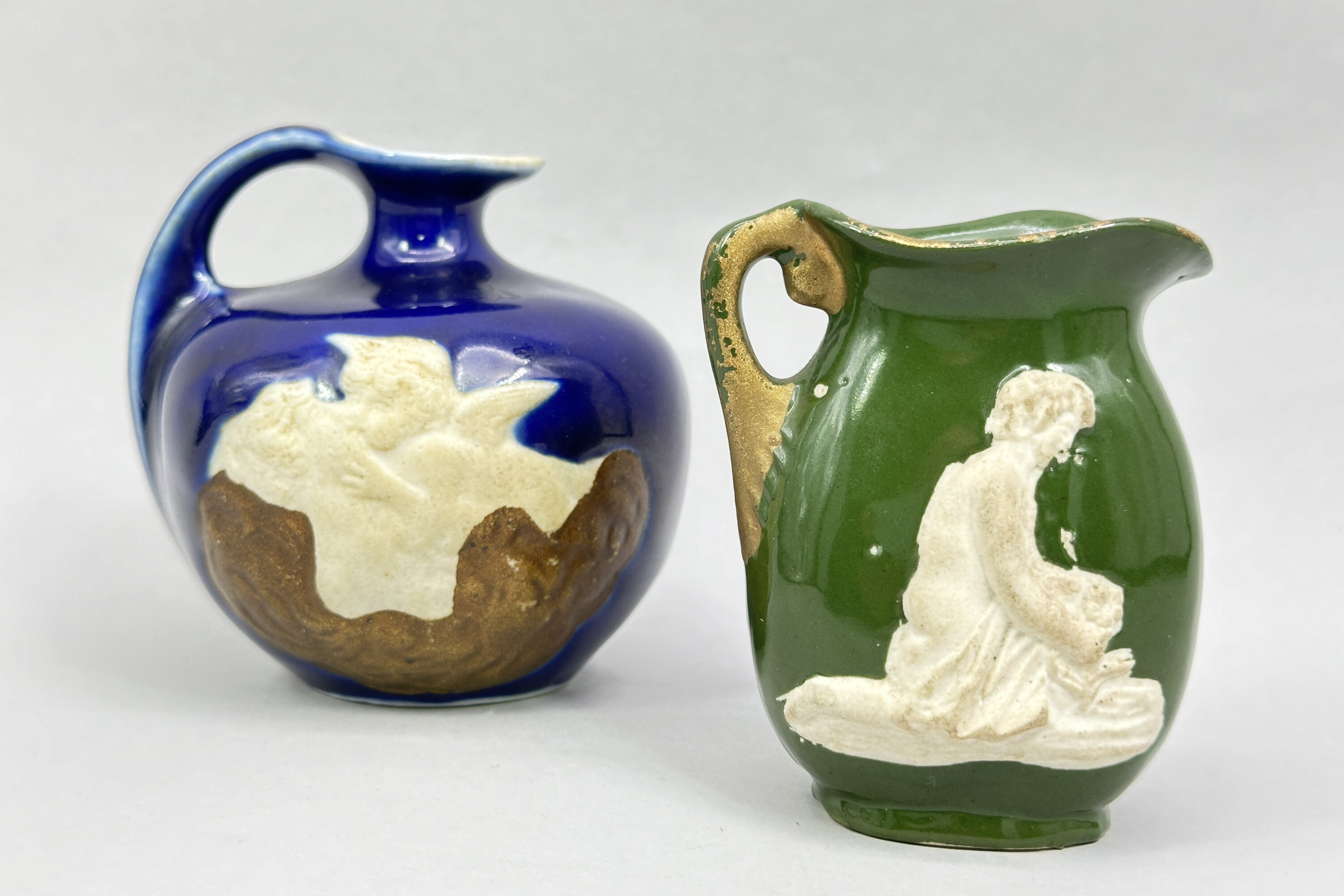
Two Ceramic Jugs with Erotic Decoration, continental perhaps German, circa 1900
Price: £25These pieces represent something of a puzzle. Seen the right way round (with the handle on the right) they are plain and the decoration only reveals itself on the reverse. This suggests a playful intent to conceal which, when combined with the subject matter, suggests something a bit ‘naughty’ which could confirm the second interpretation of what the seated man is holding! The paste, and general style of the pieces, looks continental and a German origin might be a good guess, but no more than that. The blue glazed jug has an impressed mark to the base ‘186 [plus an unidentifiable number]’ which might be the date but is more likely the pattern number; a dating of around 1900 for both seems reasonable - certainly there is an ‘old’ look to the pieces. There are one or two similar examples but little in the way of firm information. One for a collector to puzzle out!
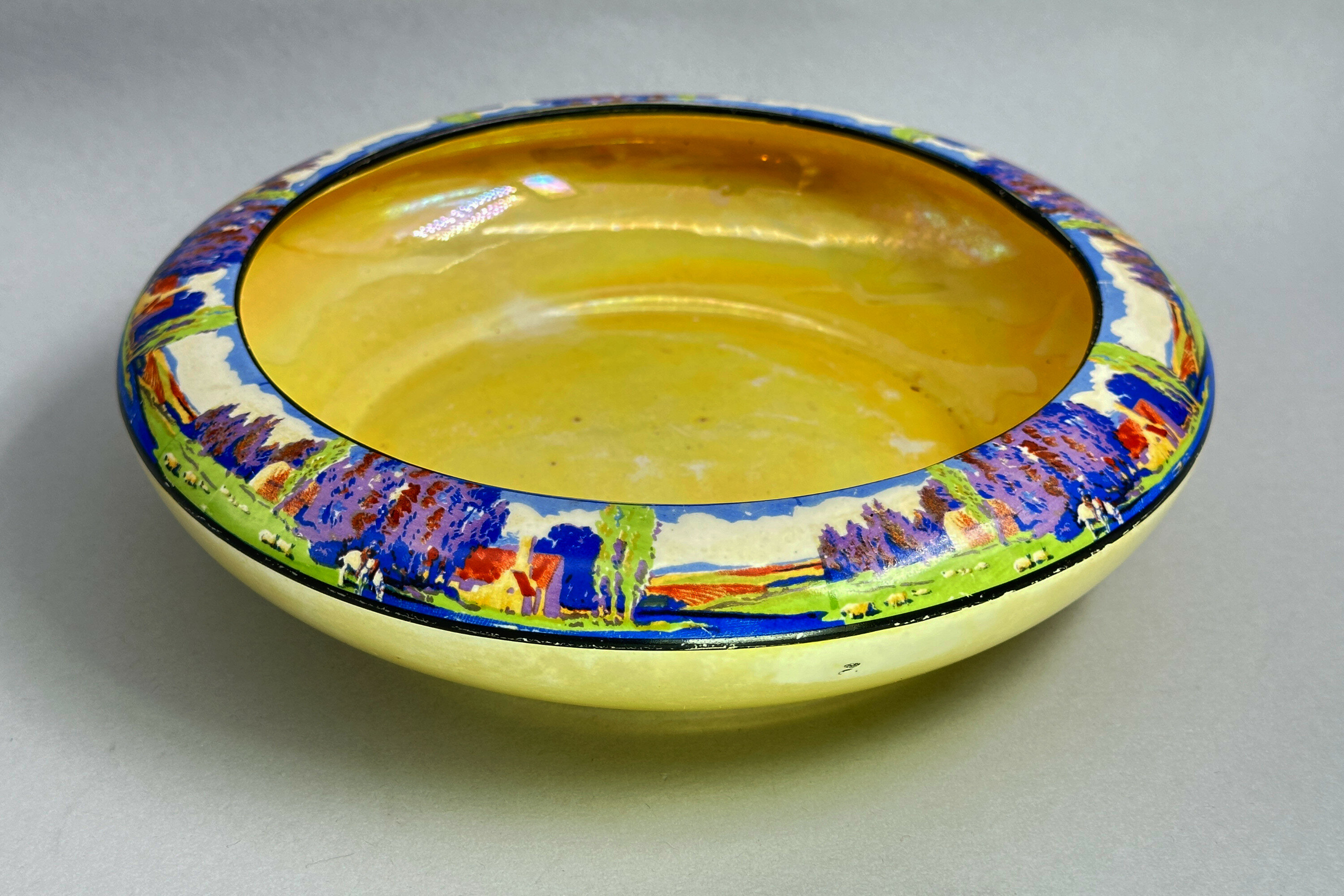
Hanley Ware circular bowl, Lancaster and Sons, 1920s
Price: £25Lancaster & Sons Ltd were manufacturers of earthenware at the Dresden works, Tinkersclough, in the Shelton area of Hanley, Stoke-on-Trent, England. The firm was founded in 1899 under the name ‘Lancaster and Barker’ was renamed ‘Lancaster & Sons Ltd’ in the early 1900s and continued production until 1944. In the 1920s they produced various pieces with rural landscape scenes of which this is an example. Some see reminiscences of the ‘Arts and Crafts’ movement here but the mark found on the bottom clearly dates the piece to the 1920s. The yellow lustre glaze is interesting and free from the crazing sometimes found.
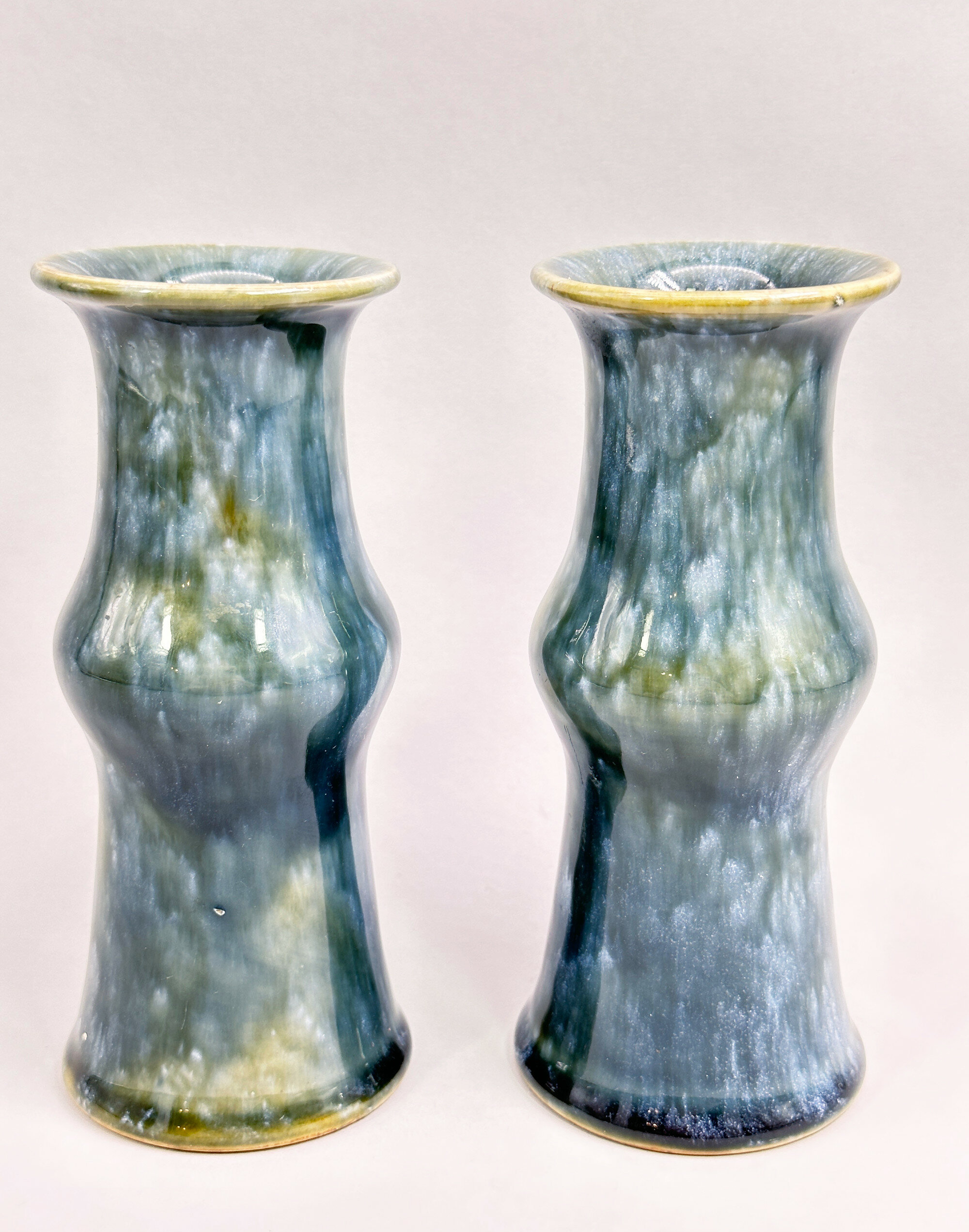
Pair of Royal Doulton slender Ku form Vases, 1920s
Price: £75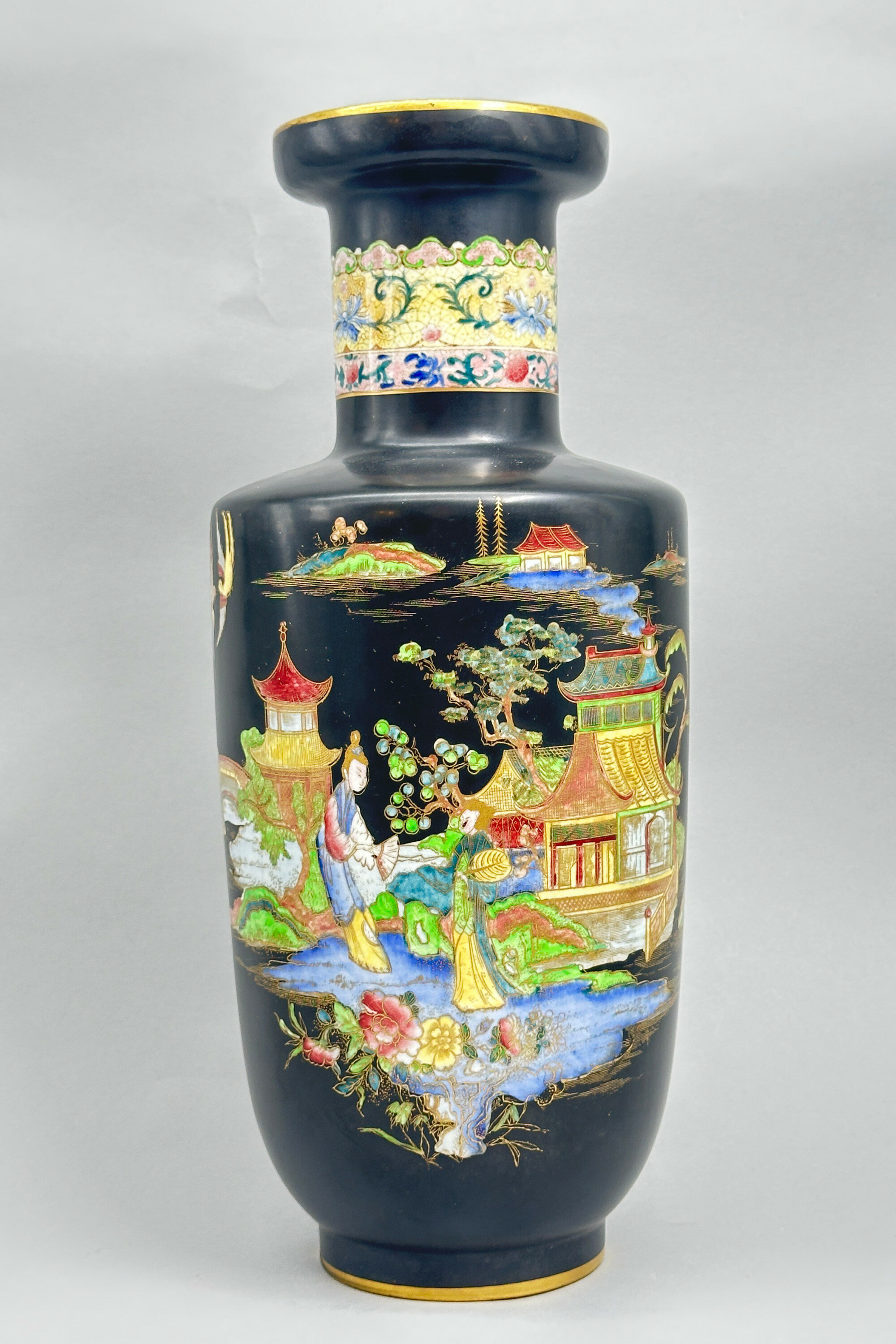
Mikado Carlton Ware Vase, 1920s
Price: £45Carlton Ware was the trade mark used by the pottery manufacturer Wiltshaw and Robinson, whose premises were located in Stoke on Trent, four years after the firm’s establishment in 1890. The firm mostly concentrated on decorative giftware and new methods of production introduced in the 1920s put it at the forefront of the earliest Art Deco pottery pieces produced, firstly with designs originating from Tutankhamun’s tomb and then with pieces with an Oriental influence of which this vase, in shape not often seen in this design, is a prime example.
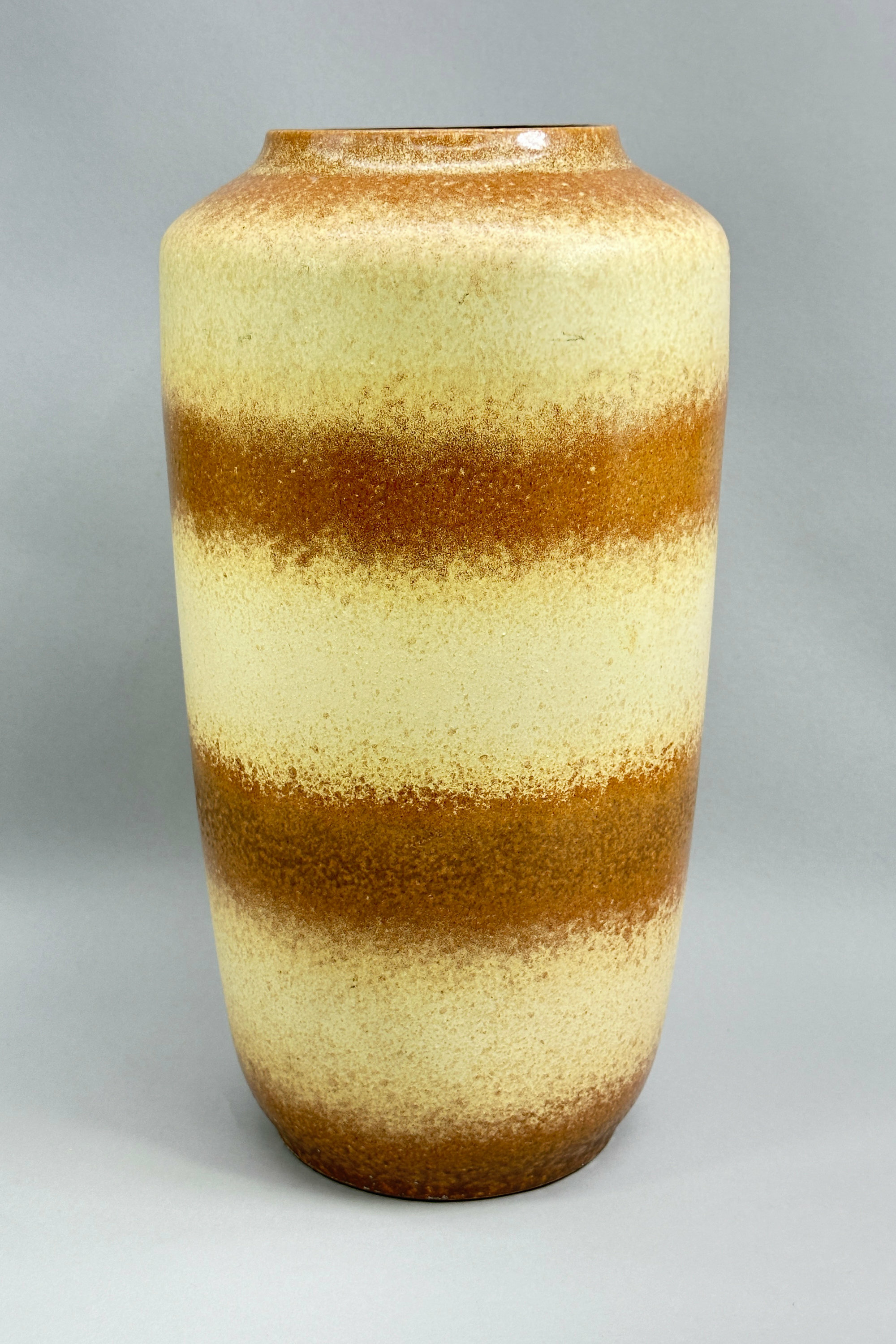
West German Vase, Model No 517-38, Scheurich, 1960s
Price: £55Although not marked as such, this vase has all the hallmarks of the firm Scheurich Keramik which started production in 1954, rather later than most of its competitors, but soon became the largest producer of commercial art pottery in Germany. Their pieces rarely carried the factory name but usually the model number followed by the height in centimetres with ‘W.Germany’ below, as here. Model ‘517’ can be found in a variety of different glazes but the pattern and colourings here, more muted than some of Sheurich’s work and with a matt finish, are particularly pleasing and complement the elegant form most successfully. Dating is to the 1960s.
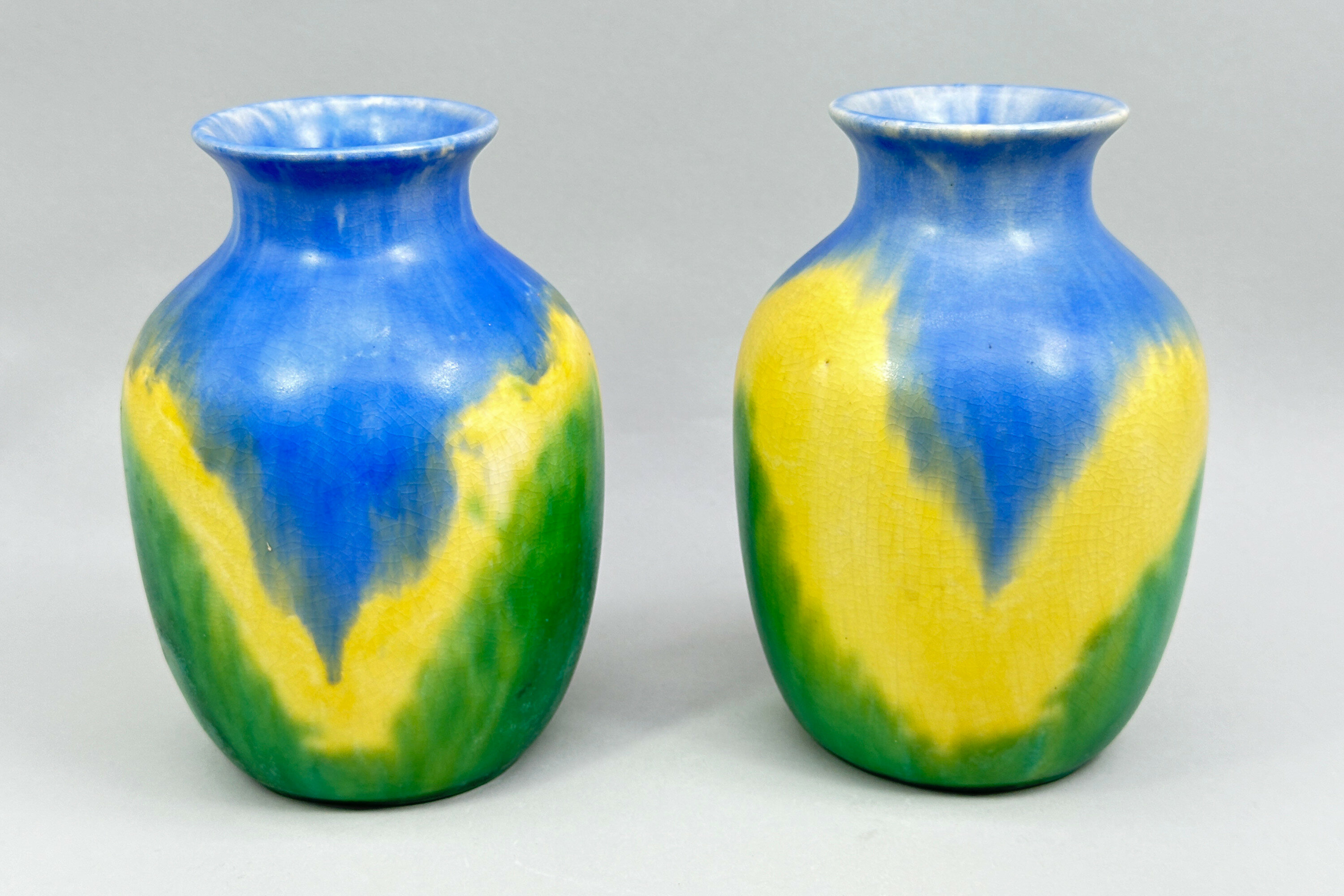
Pair of Art Deco style Avon Ware Vases, 1930s
Price: £45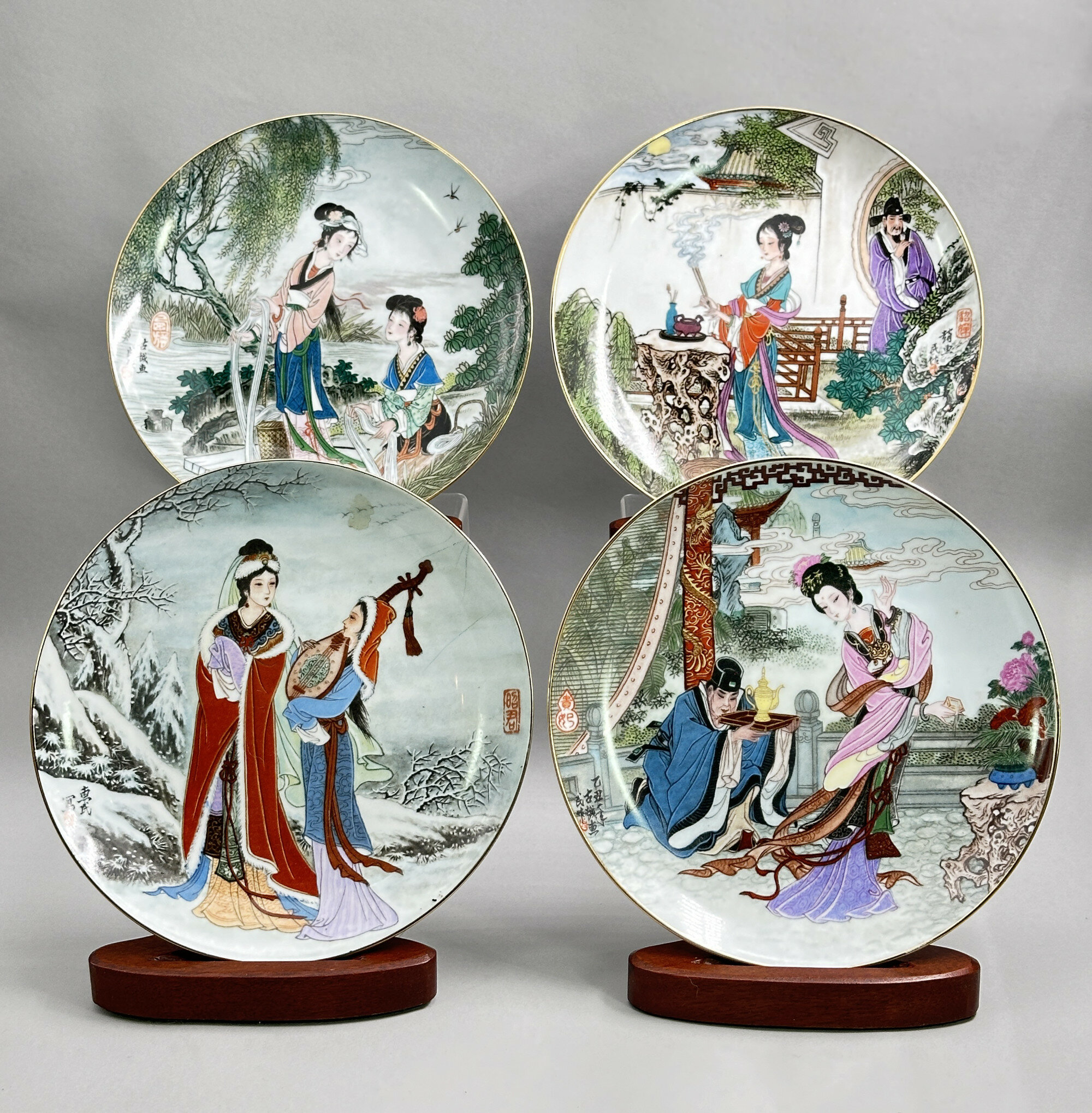
Set of Japanese Plates decorated with Geisha in landscape scenes, late C20th
Price: £40Please note that the stands are for display purposes only.
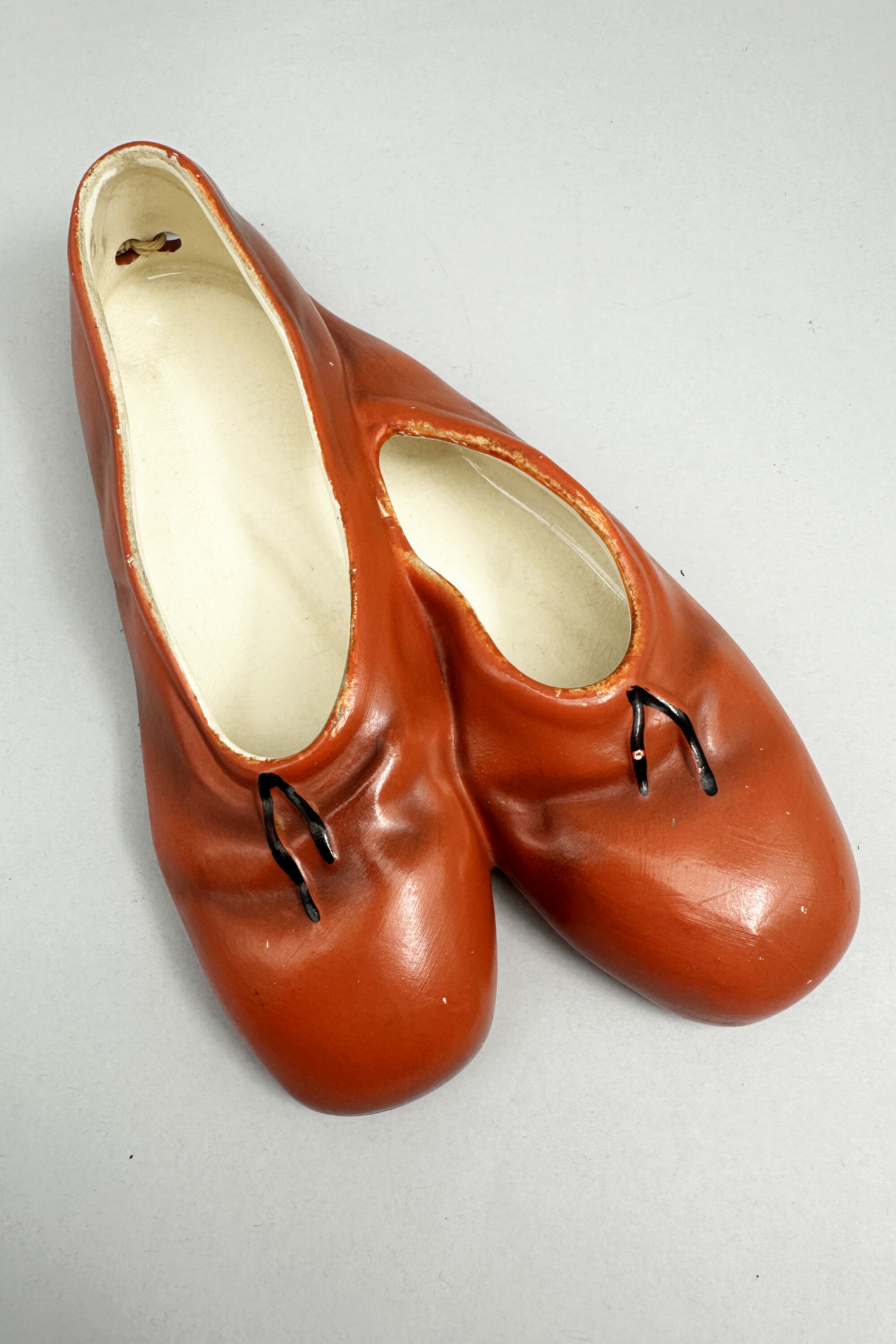
Pair of Brentleigh Ware Wall Hanging Ballet Shoes, 1930s
Price: £35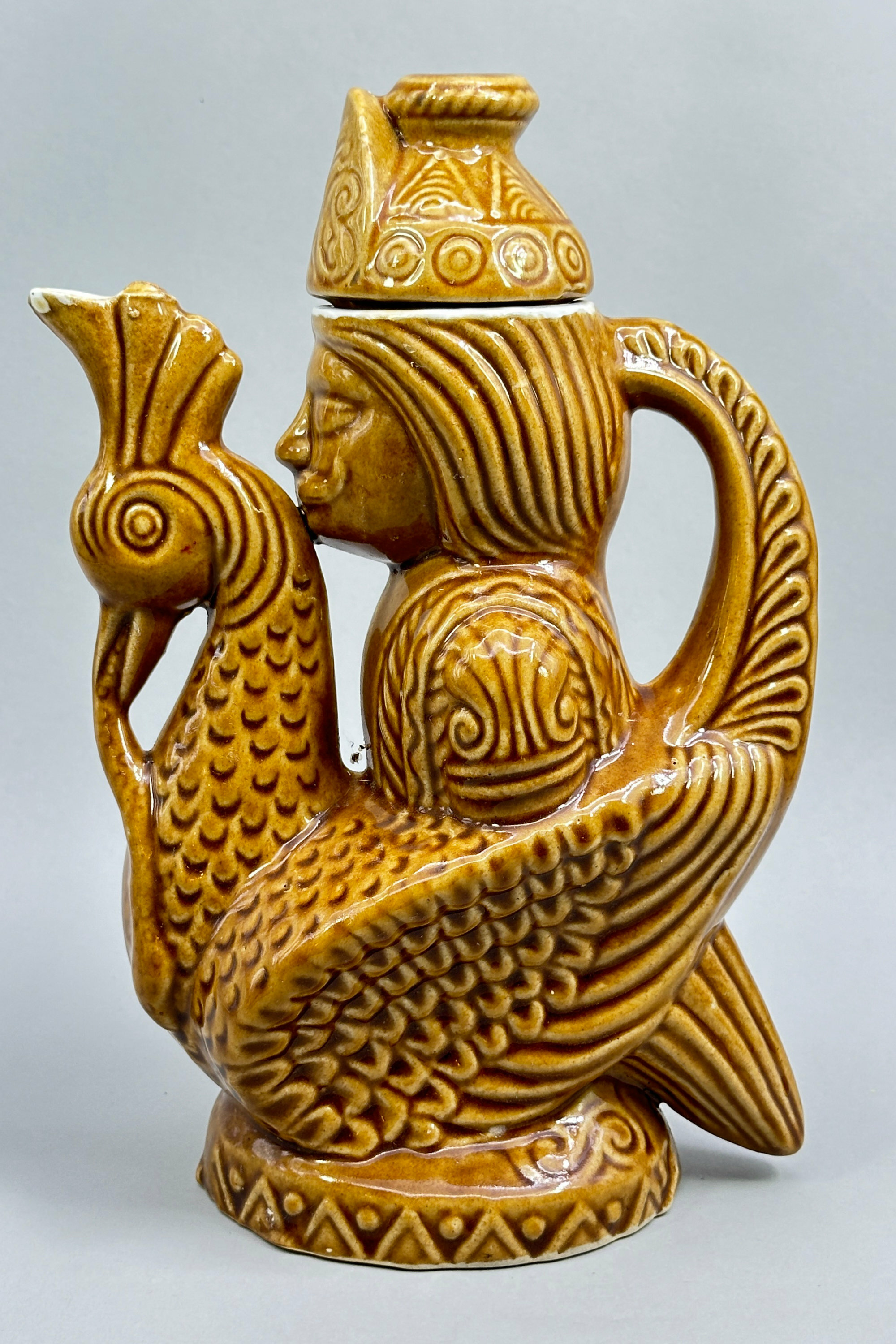
Bird form ewer with cover, possibly Russian c1960
Price: £45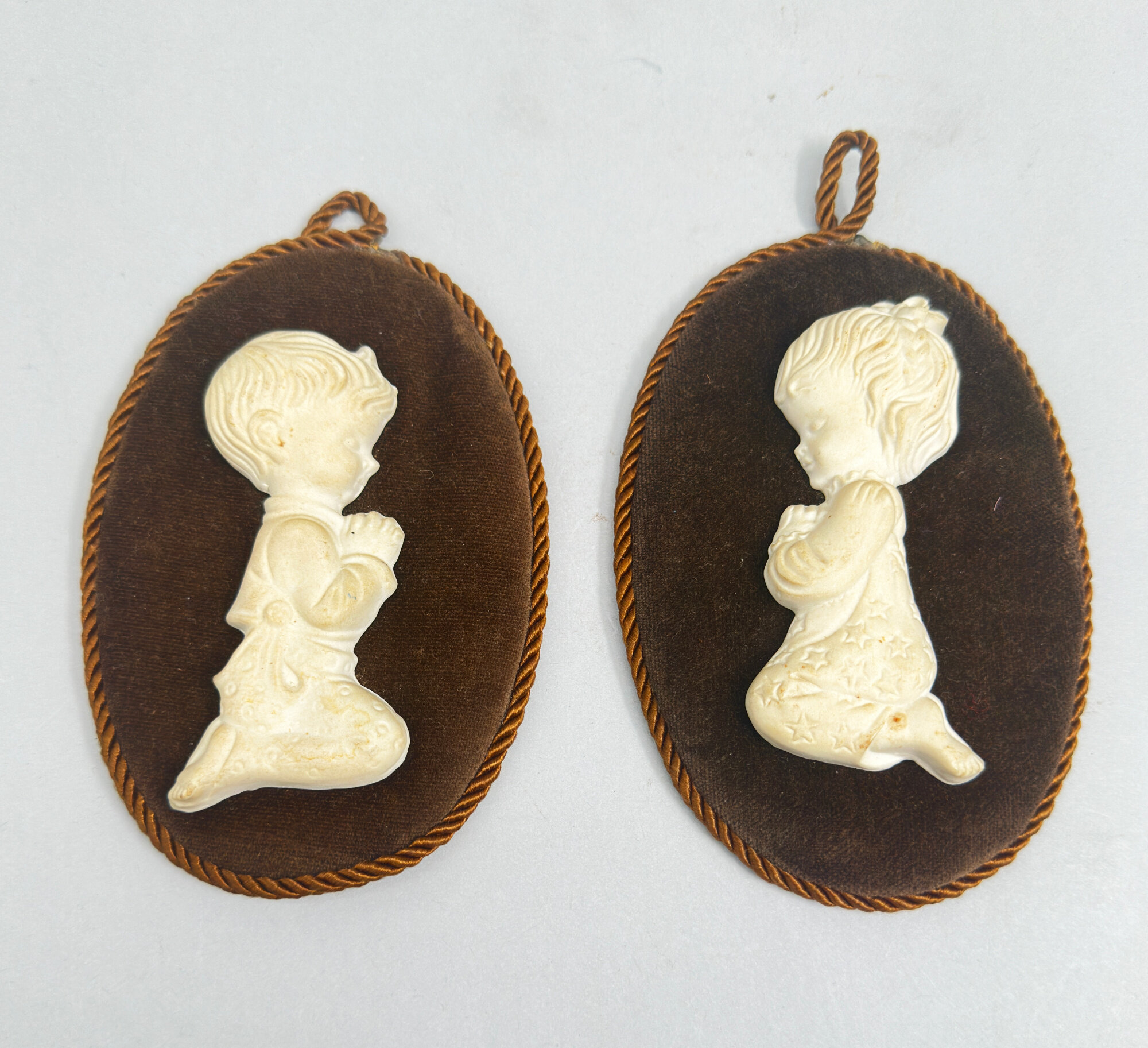
Pair of Capodimonte ceramic Wall Hanging Plaques, boy and girl praying, Italian 1960s
Price: £25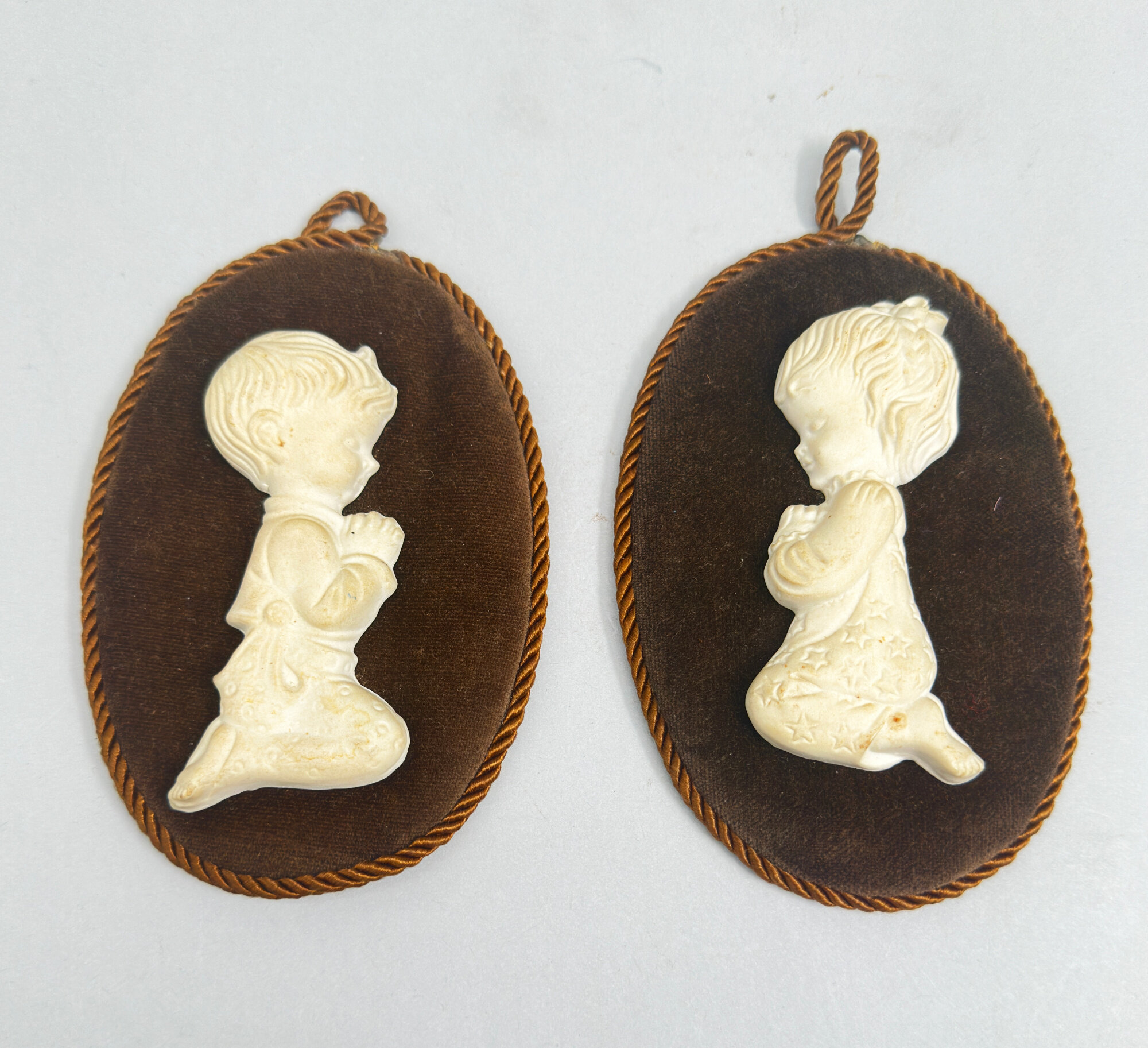
Pair of Capodimonte ceramic Wall Hanging Plaques, boy and girl praying, Italian 1960s
Price: £25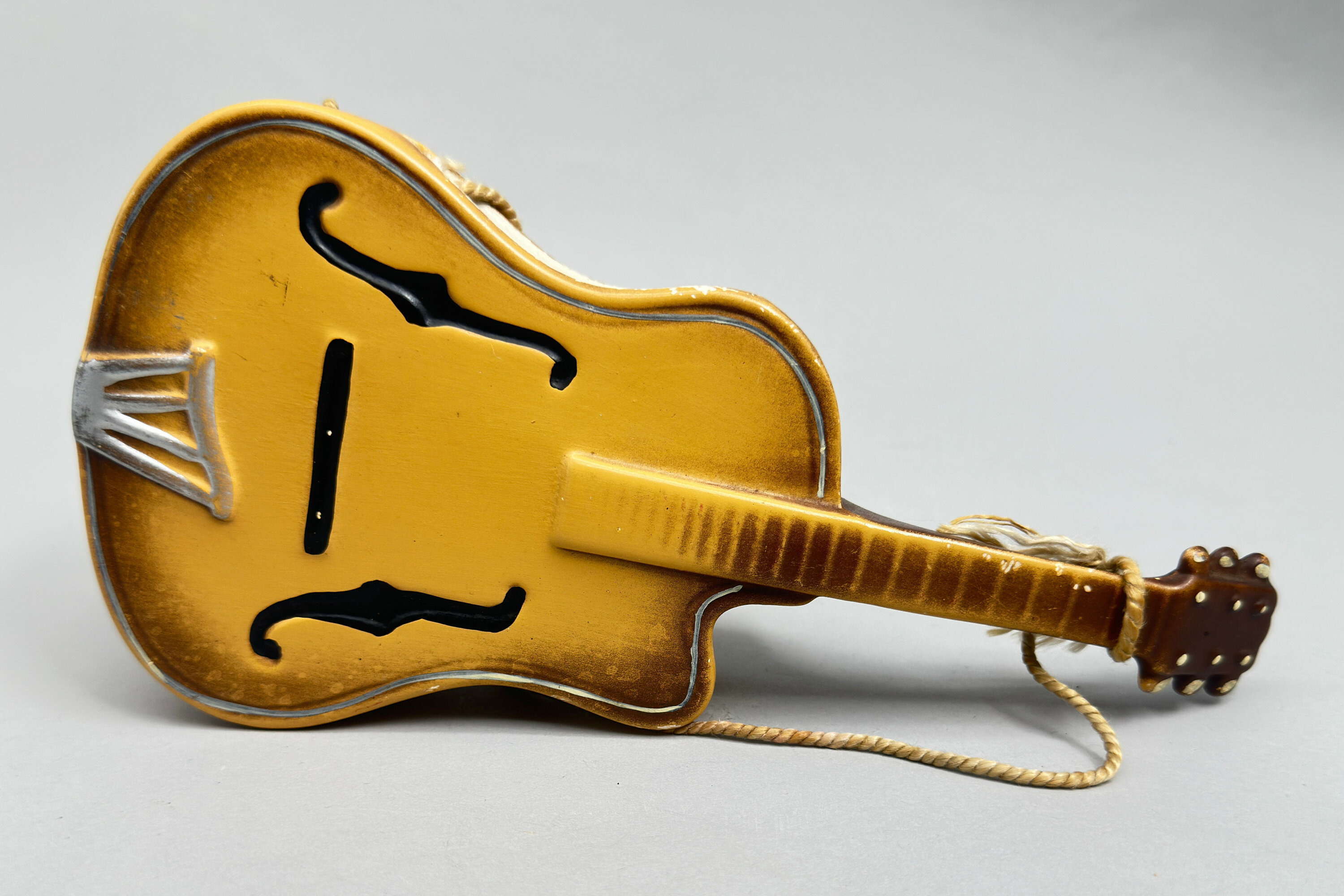
Novelty ceramic Wall Vase in the form of a Gretsch Guitar, English, 1950s
Price: £25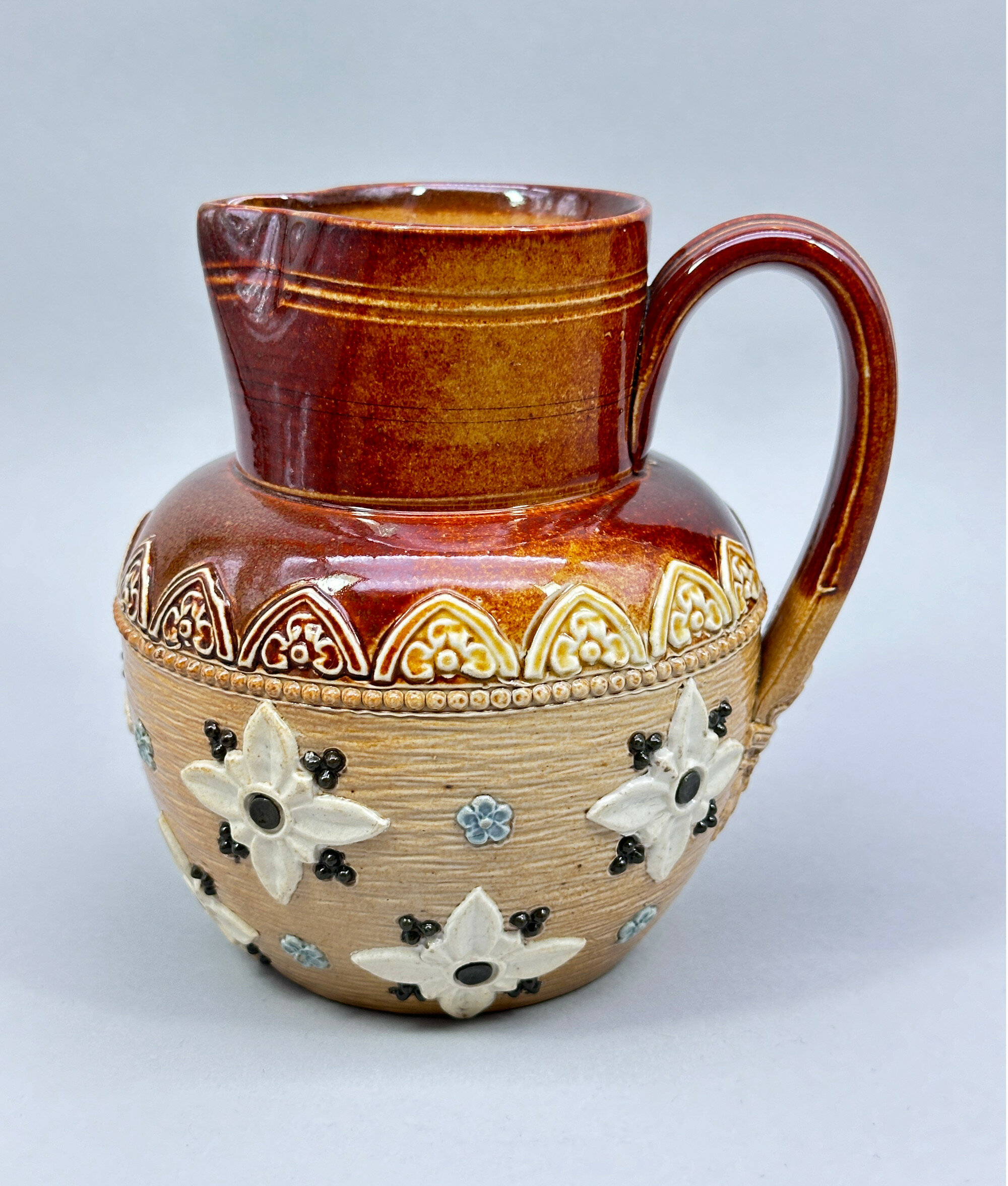
Doulton Lambeth Stoneware Jug circa 1900
Price: £45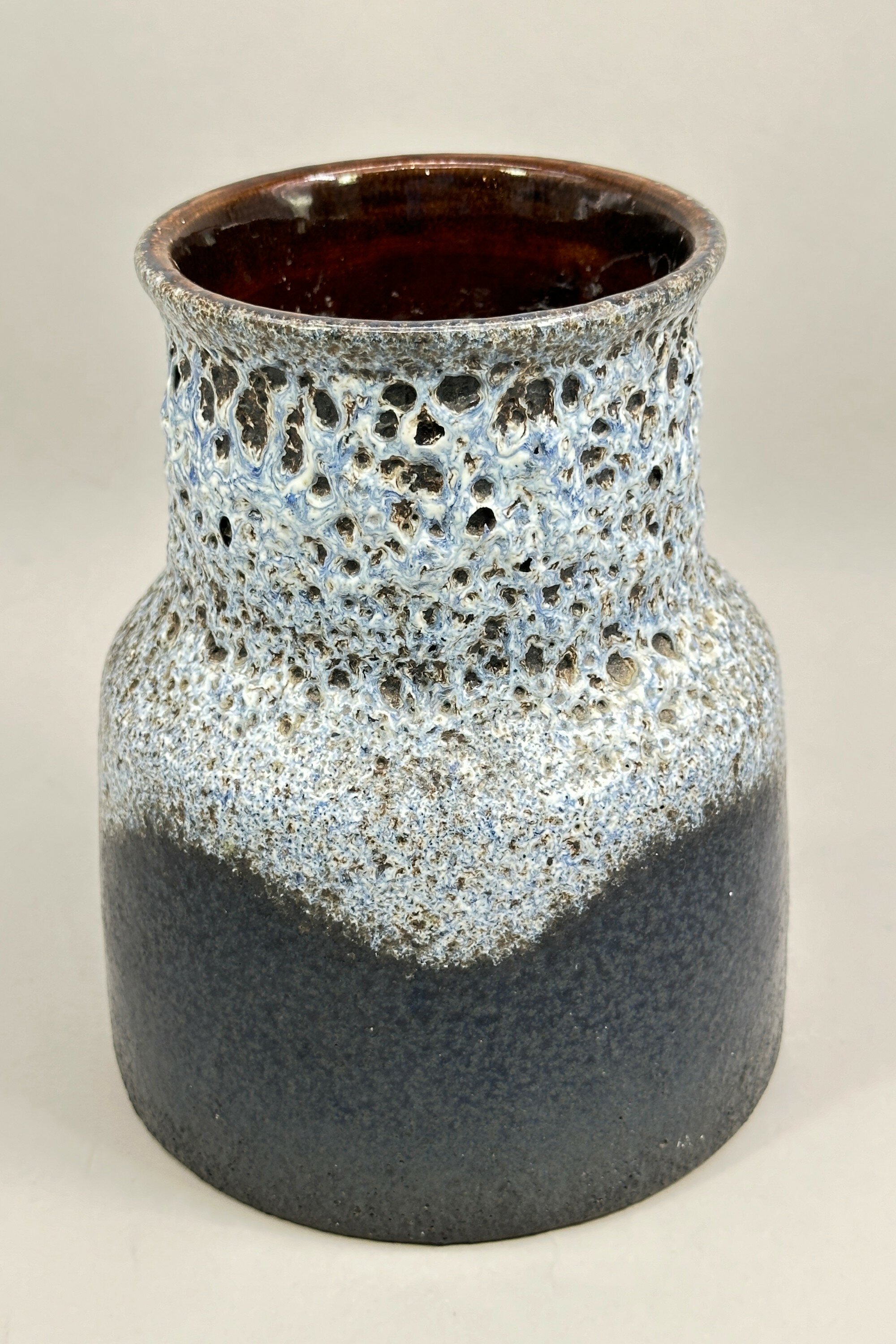
West German Pottery Lava Glaze Vase, Scheurich, 1960s
Price: £45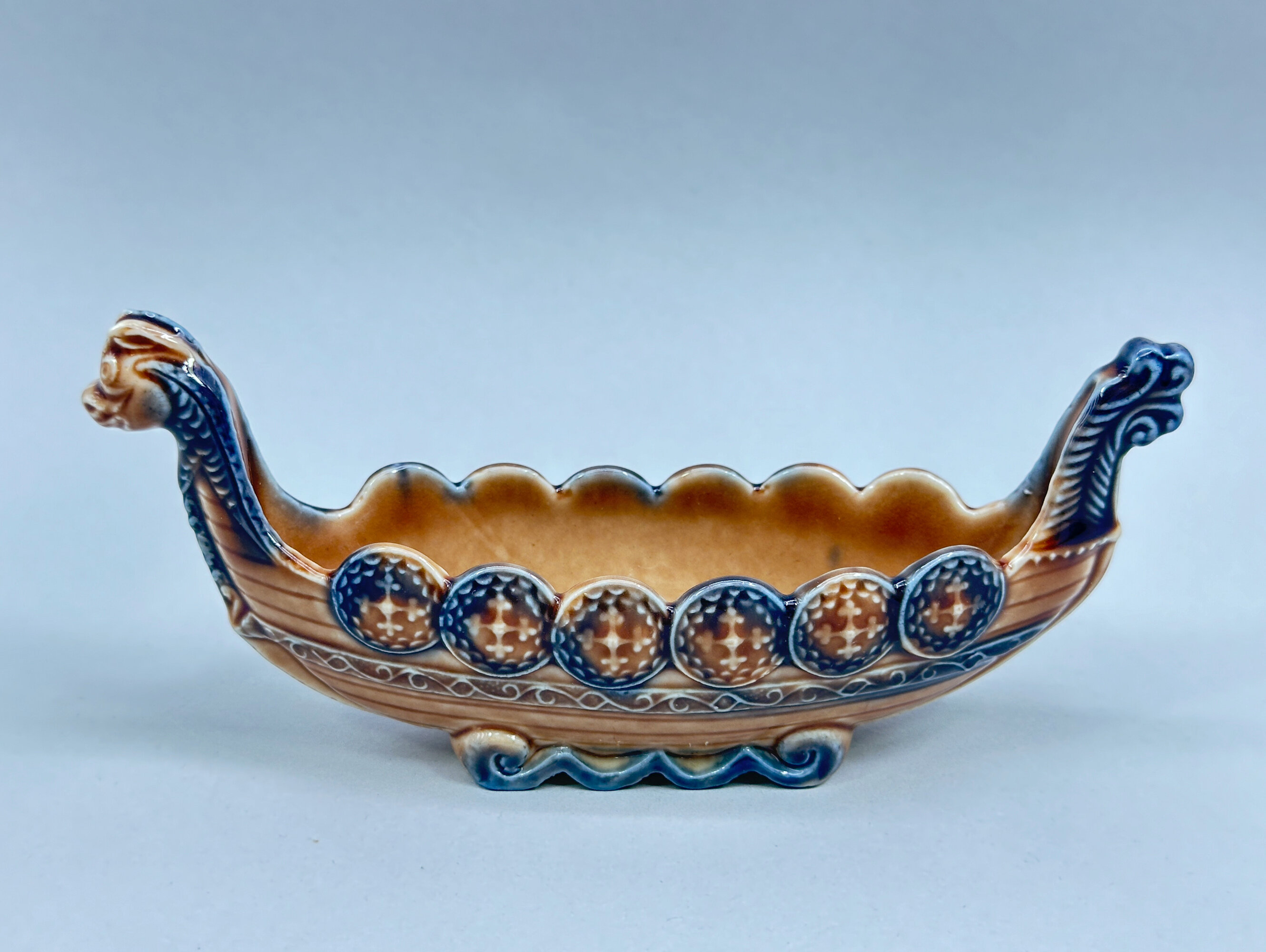
Ceramic Model of a Viking Longboat, Wade, 1950s/1960s
Price: £25Wade Ceramics Ltd was a manufacturer of porcelain and earthenware, headquartered in Stoke-on-Trent, England. Founded in 1867, it was run by various members of the Wade family until the death of George Anthony Wade in 1987 after which there was a succession of management buyouts. Despite substantial investment in 2009, the firm eventually went into administration in 2022. Wade produced a wide variety of ceramics, including the well known Wade Whimsies animal figurines.
Many of their pieces were designed to act as small containers for flowers and trinkets and this piece is a particularly amusing example of the type. Two colour ranges exist, one as here and one with much darker tones which is held to be later. Dating here, then, is most likely to the 1950s/1960s when the Wade production lines were in full swing and enjoying considerable popularity.
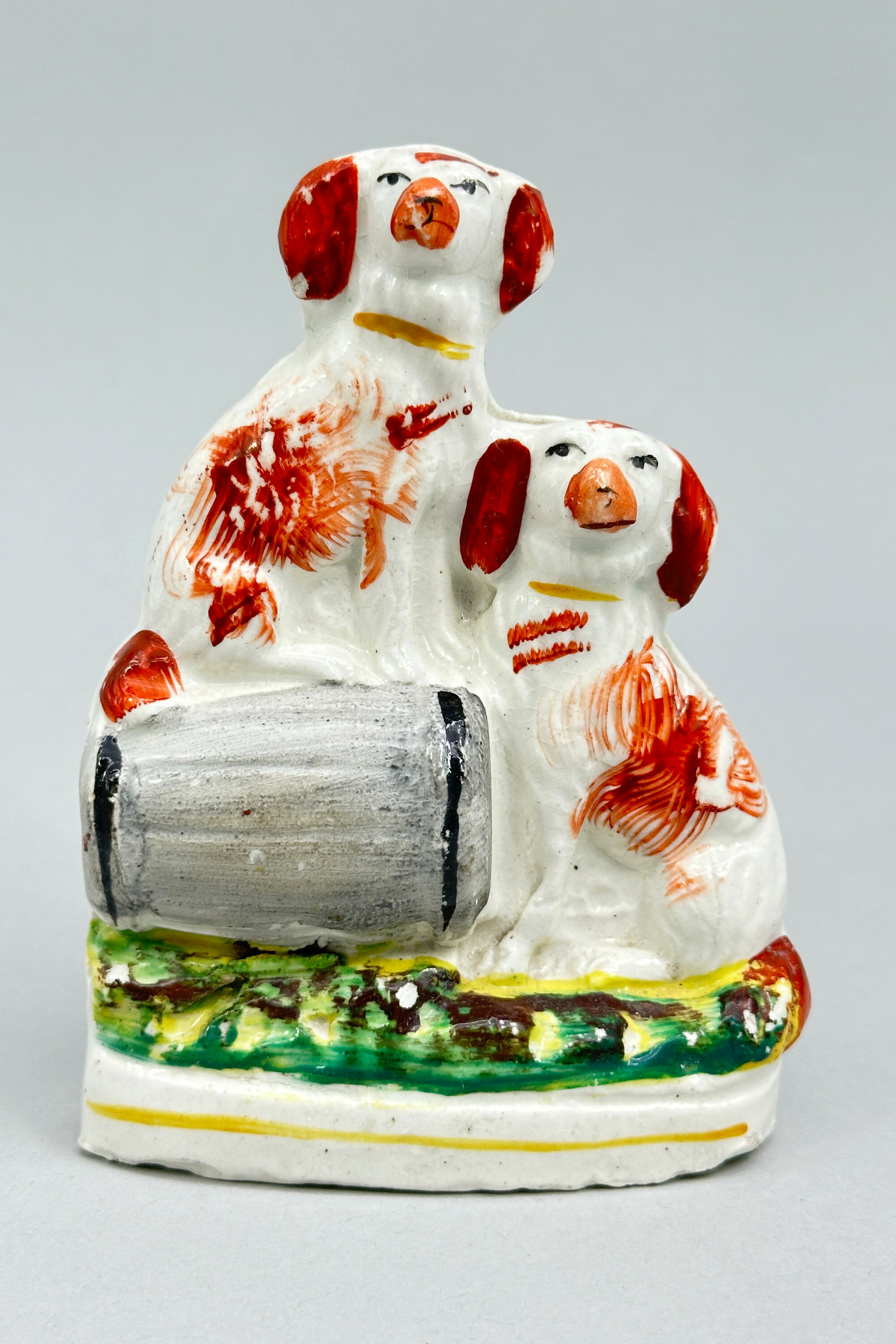
Miniature Staffordshire flatback model of two spaniels and a barrel, second half C19th
Price: £55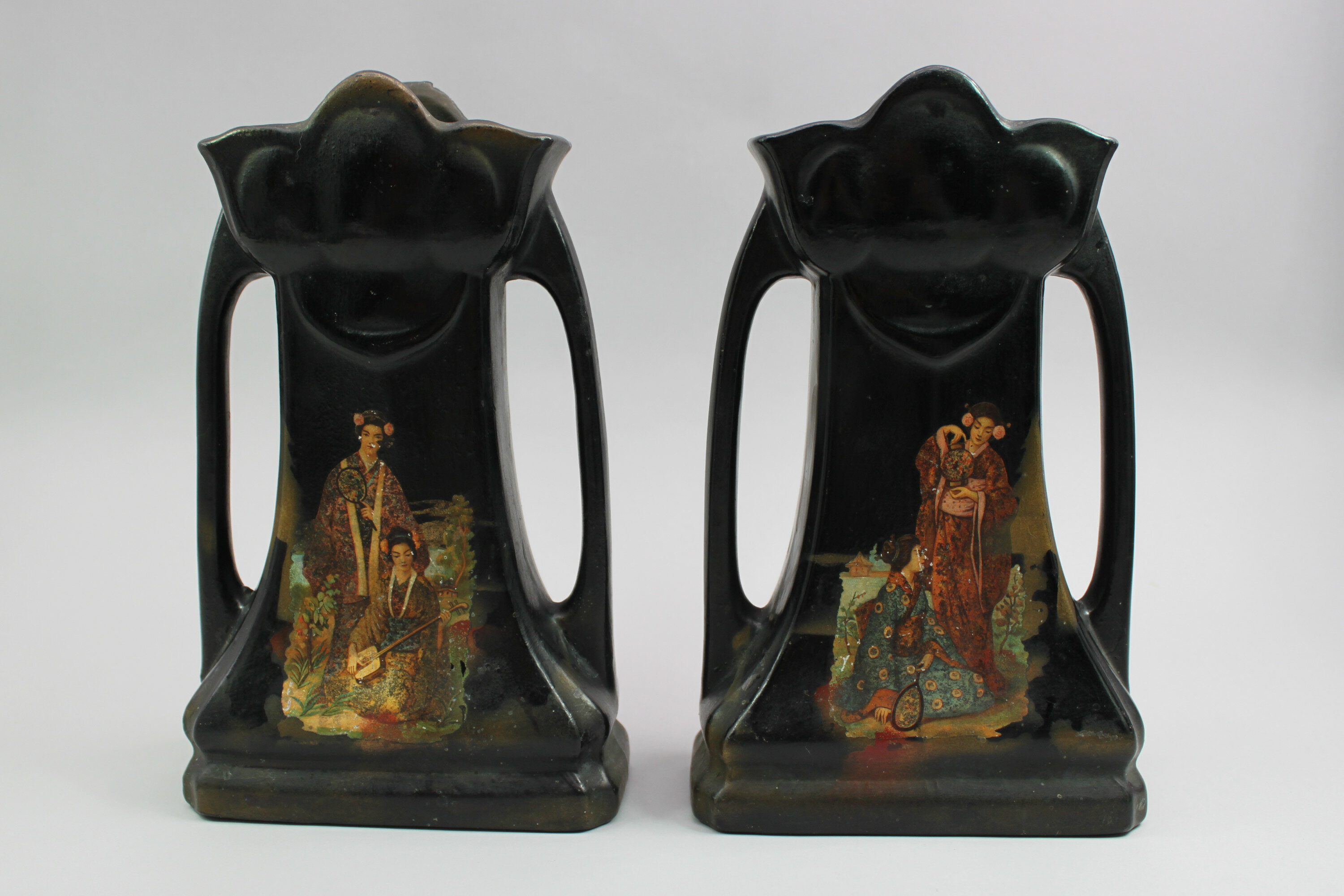
Pair of Art Nouveau Style Ceramic Vases decorated in the Japonaiserie Style, 1930s
Price: £45While Art Nouveau in form and decoration (Japanese inspired designs were very much a feature of the style), these vases probably date to the 1930s when Staffordshire potteries were producing affordable items for interior decoration in a range of imitation styles. There are no direct parallels for the mark on these vases but the type of ware here is very similar to pieces made by the 'Brentleigh' factory, Stoke on Trent, in the 1930s and a similar date and area of manufacture is the most likely.
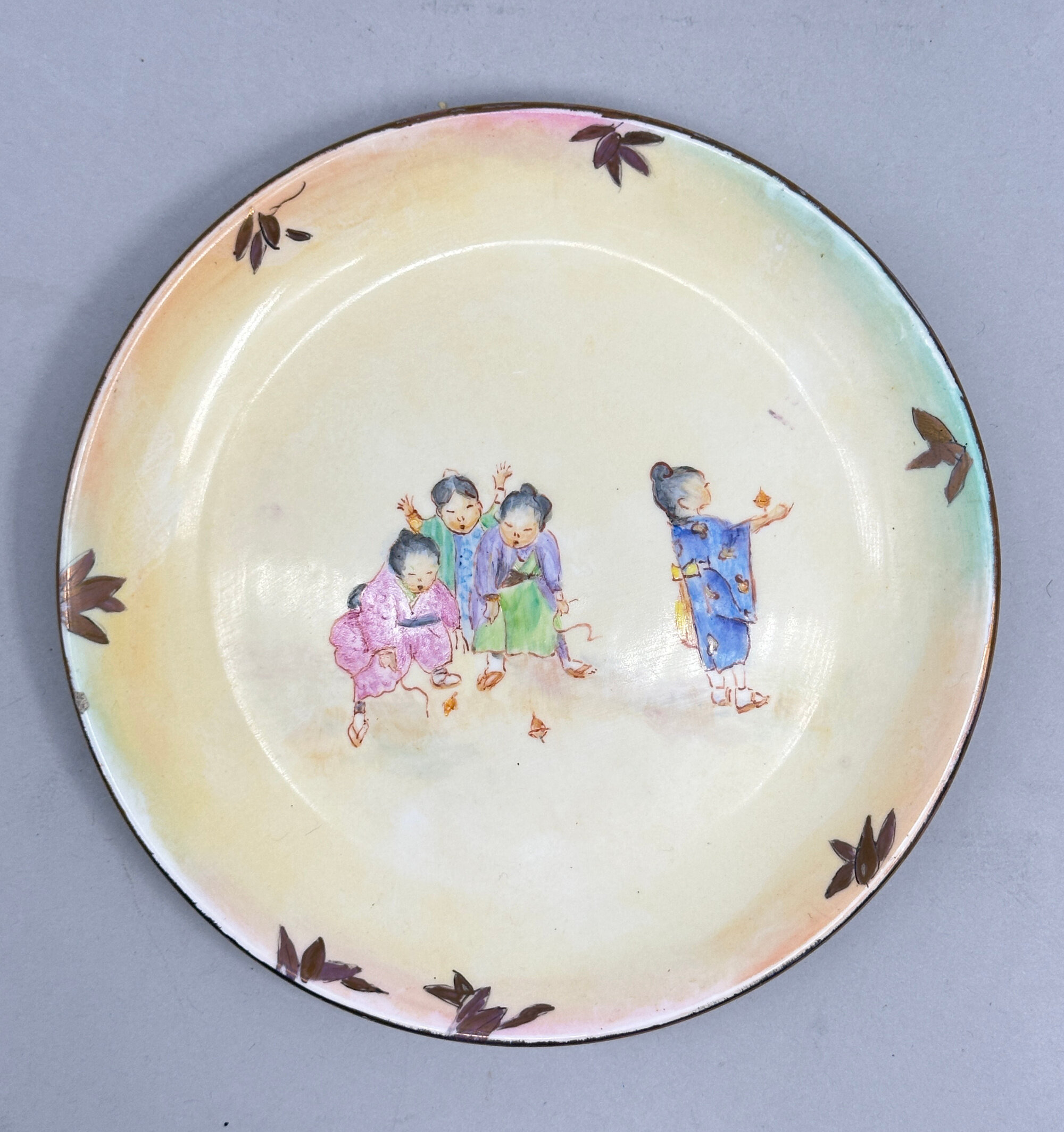
Oriental style ceramic plate, signed Alice Smith, possibly American mid C20th
Price: £10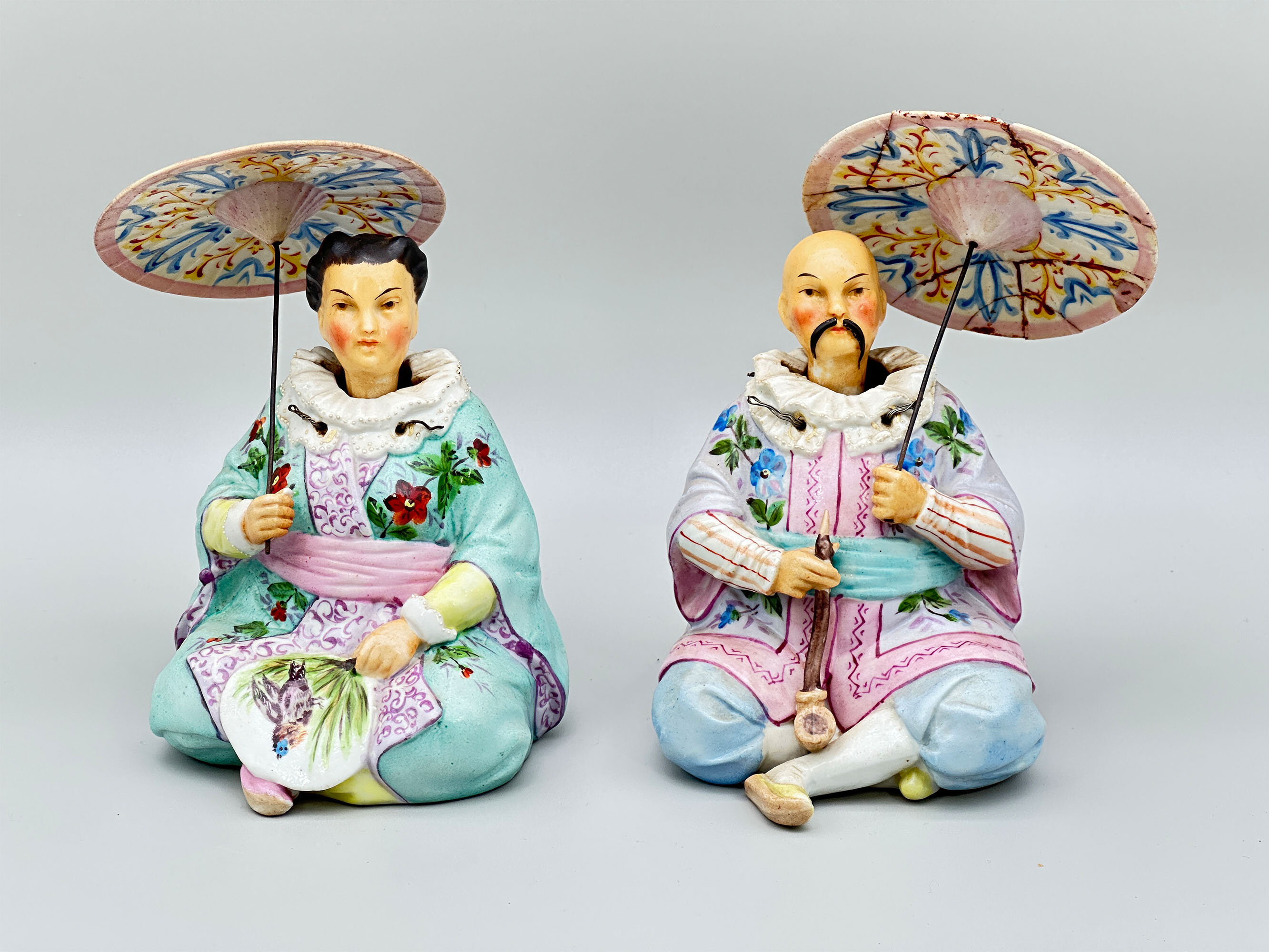
Pair of Nodding Head Figures, Chinese Emperor and Empress, Germany circa 1900
Estimate: £200 – 300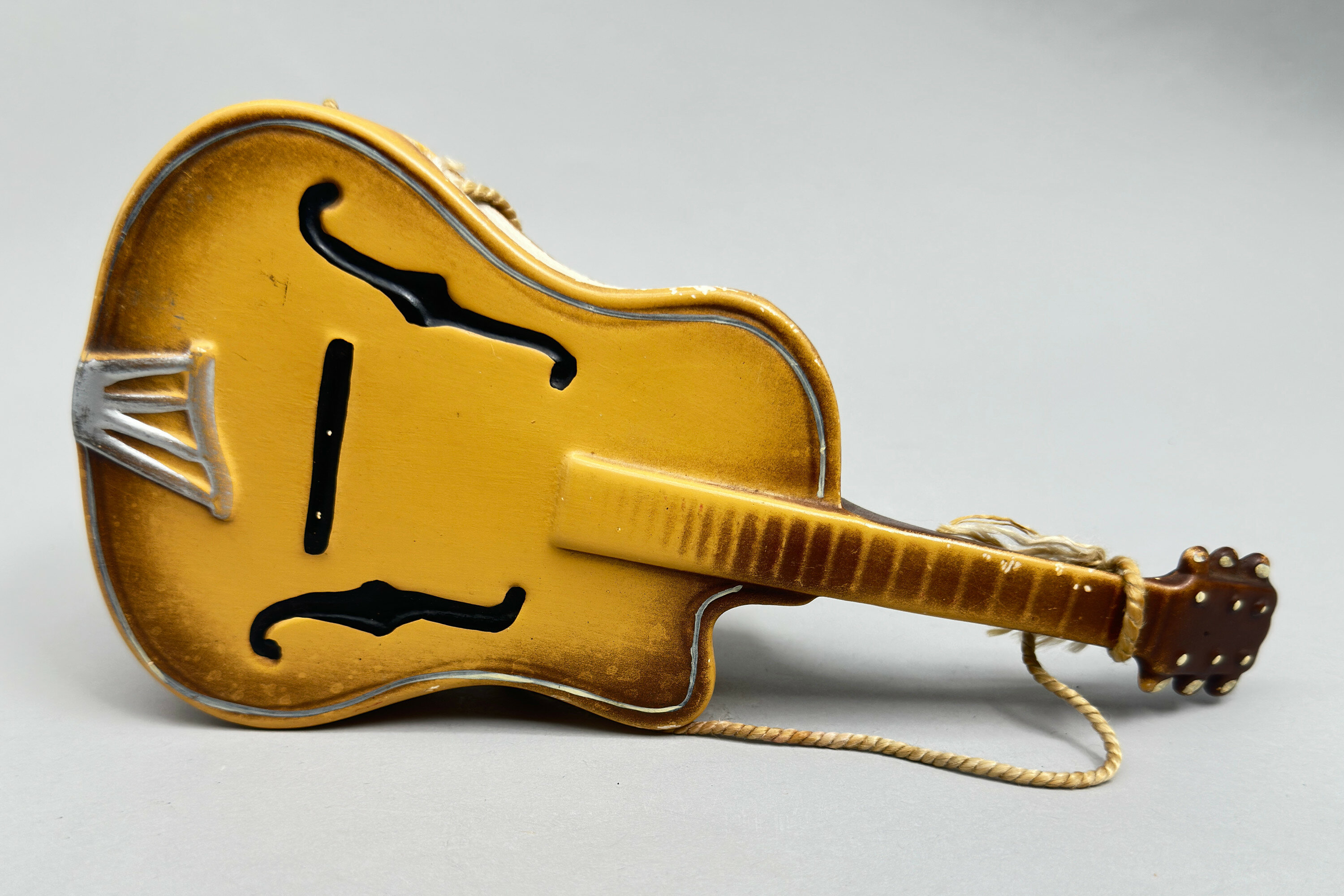
Novelty ceramic Wall Vase in the form of a Gretsch Guitar, English, 1950s
Price: £25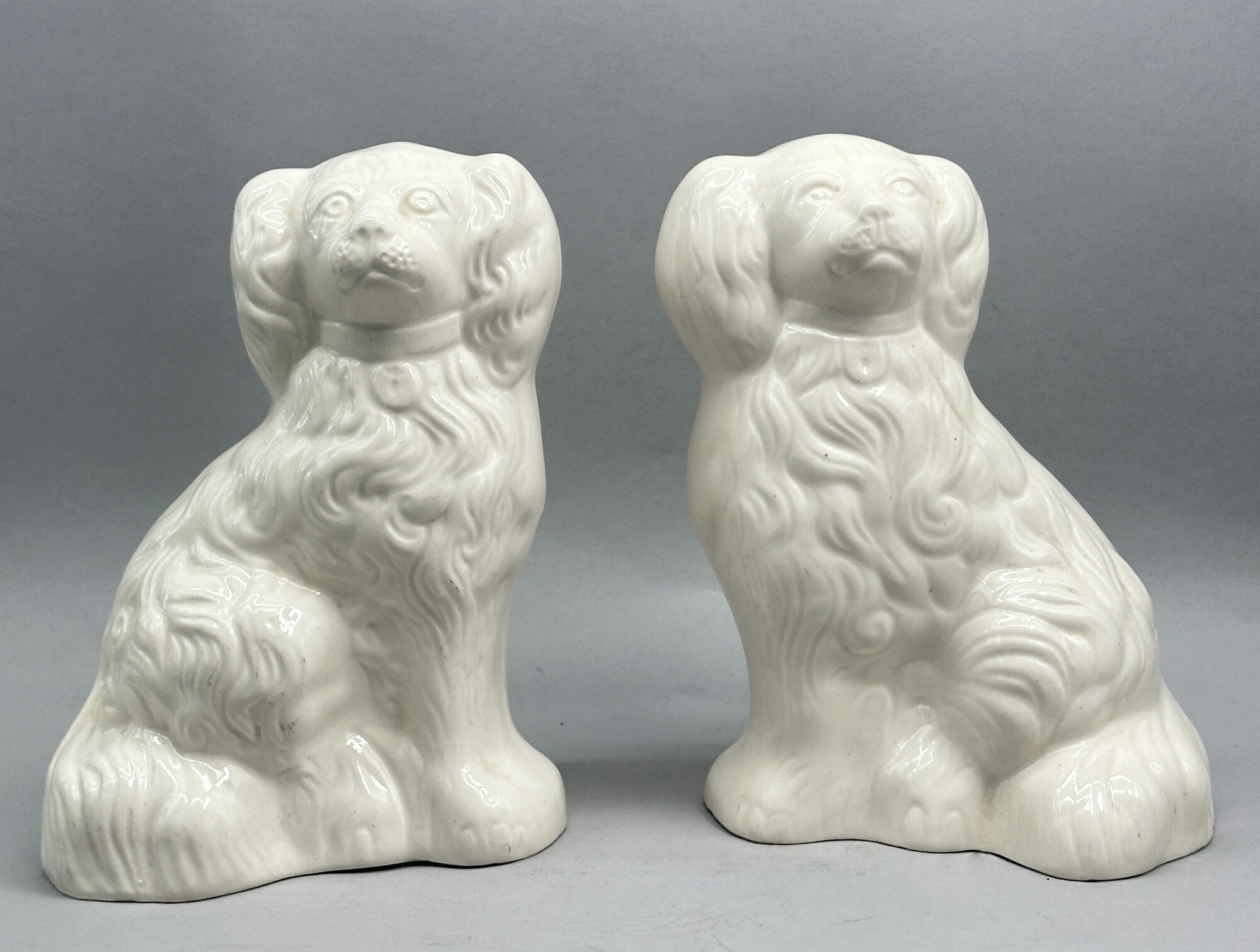
An unusual pair of white glaze models of Spaniels, Beswick, 1960s
Price: £75While a close relation to the traditional Victorian ‘Staffordshire Dog’, these figures were actually made by the English firm Beswick in the twentieth century. Founded in 1894 by James Beswick and his sons, the company became known for its output of figurines, eventually securing the rights to producing characters from the novels of Beatrix Potter and the films of Walt Disney. It was sold to Royal Doulton in 1969 who continued production until 2002, selling the pottery premises in 2003 and the rights to the name in 2004 when they were bought by Dartington Crystal who still manufacture pieces carrying the Beswick name. These spaniel figures appear to date from the 1960s and were made in at least two sizes. Most have painted decoration but the plain white finish here is really the most pleasing of all producing a pair of decorative items with timeless appeal.
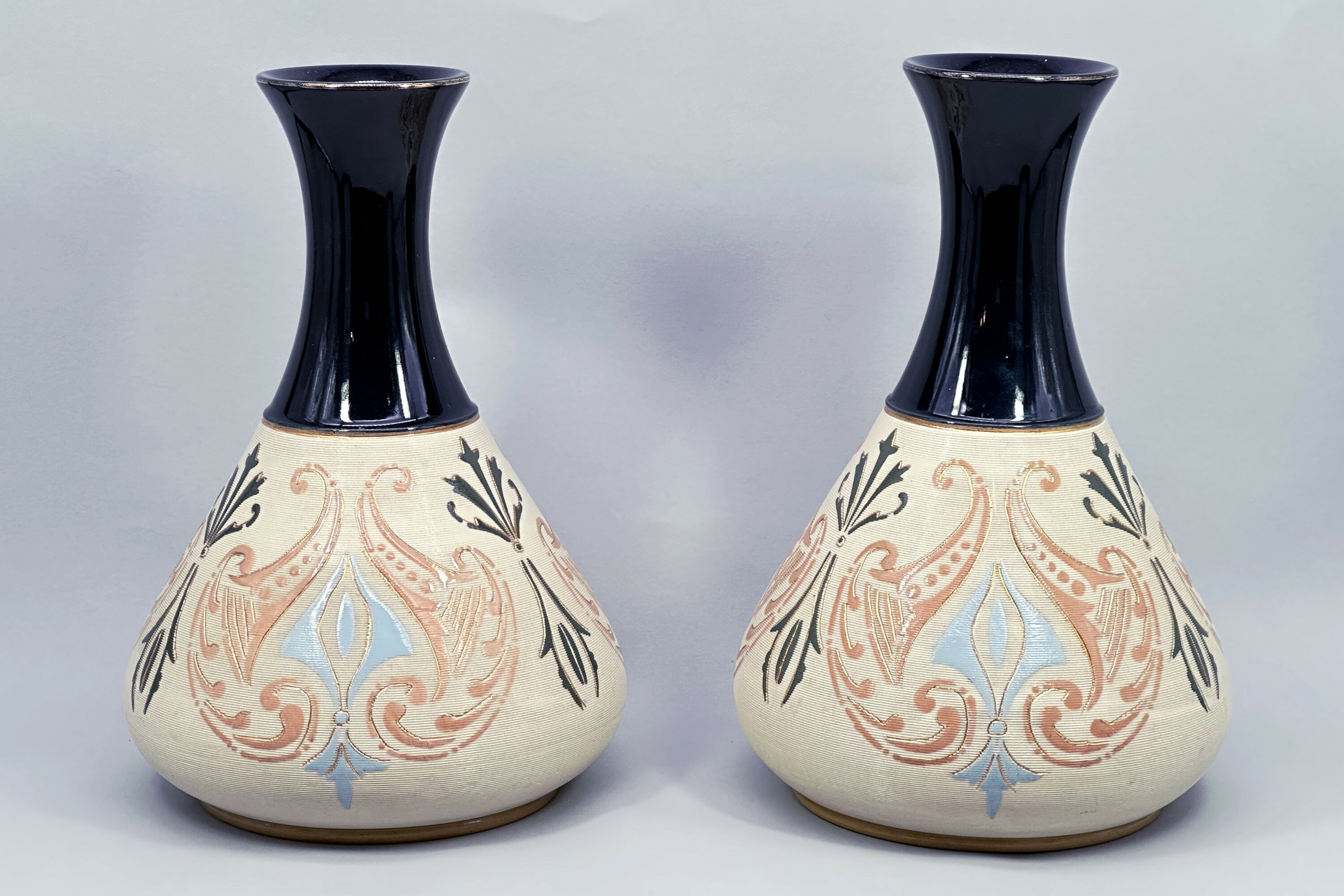
Pair of Lovatt and Lovatt Earthenware Vases, early C20th
Price: £95The Langley Mill Pottery was located in Langley Mill, Derbyshire on the Derbyshire – Nottinghamshire border. From its establishment in 1865 to its final closure in 1982, it went through five distinct periods of ownership, producing a wide range of stoneware ranging from utilitarian items and to high quality art pottery. This pair of vases dates from the third company that traded there, Lovatt and Lovatt. The Lovatt family had entered into partnership with the owner of the founding business at Langley Mill, James Calvert. From 1895 the business was in sole control of the Lovatt family and traded as ‘Lovatt and Lovatt’ until 1935. The early years of the twentieth century proved to be something of a zenith for them and a wide range of art pottery pieces were made which enjoyed great popularity. Production techniques were streamlined without a reduction in quality and in 1905, leadless glazes were introduced. These are proudly announced on the base of this pair of vases which are a fine example of the Lovatt and Lovatt style and probably date to 1913, indicated by the impressed numbers for that year.
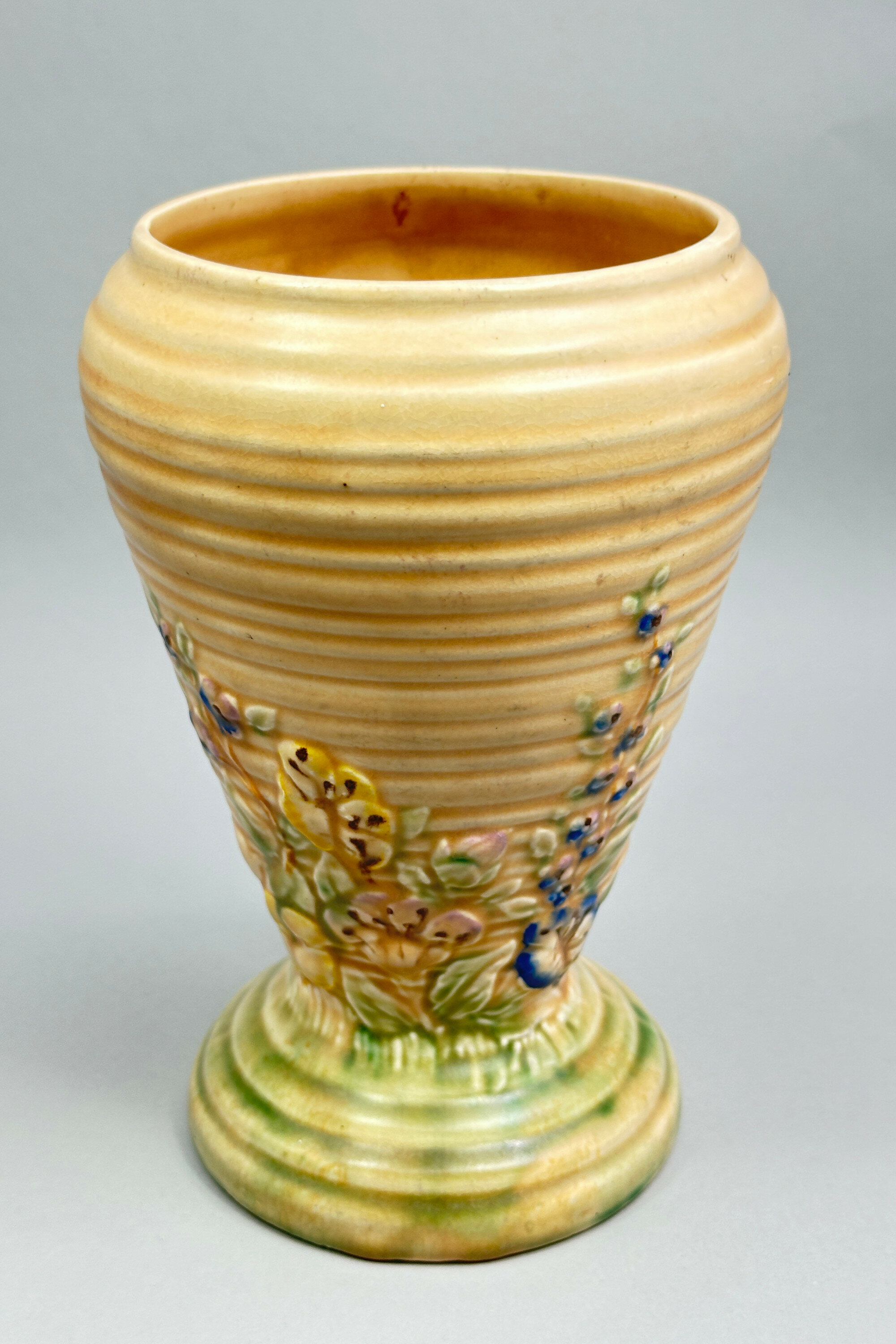
Art Deco Vase, Springtime, Price Brothers, Staffordshire, 1930s
Price: £35Price Bros was an earthenware manufacturer established at the Crown Works, Burslem, Staffordshire, England, in 1896 by the Price brothers. They specialised in tabletop accessories and teapots and success was rapid such that in 1934 they moved to larger premises at the Top Bridge Works in Longport, where they became known as Price Bros Ltd. A close association with another firm, Kensington Potteries, was finally cemented when the two firms merged in 1962 taking on the name ‘Price and Kensington’ and continuing to manufacture their popular wares to the present day. This vase is typical of the decorative pieces which Price Bros produced during the 1930s and, as with so much of the pottery produced at that time, it reflects the Art Deco styles, particularly in the semi abstract shape. This vase was mould made as can be seen from the joins at each side (see image 7) but there is nothing mechanical about the finished result with its pleasing combination of colour and decoration.
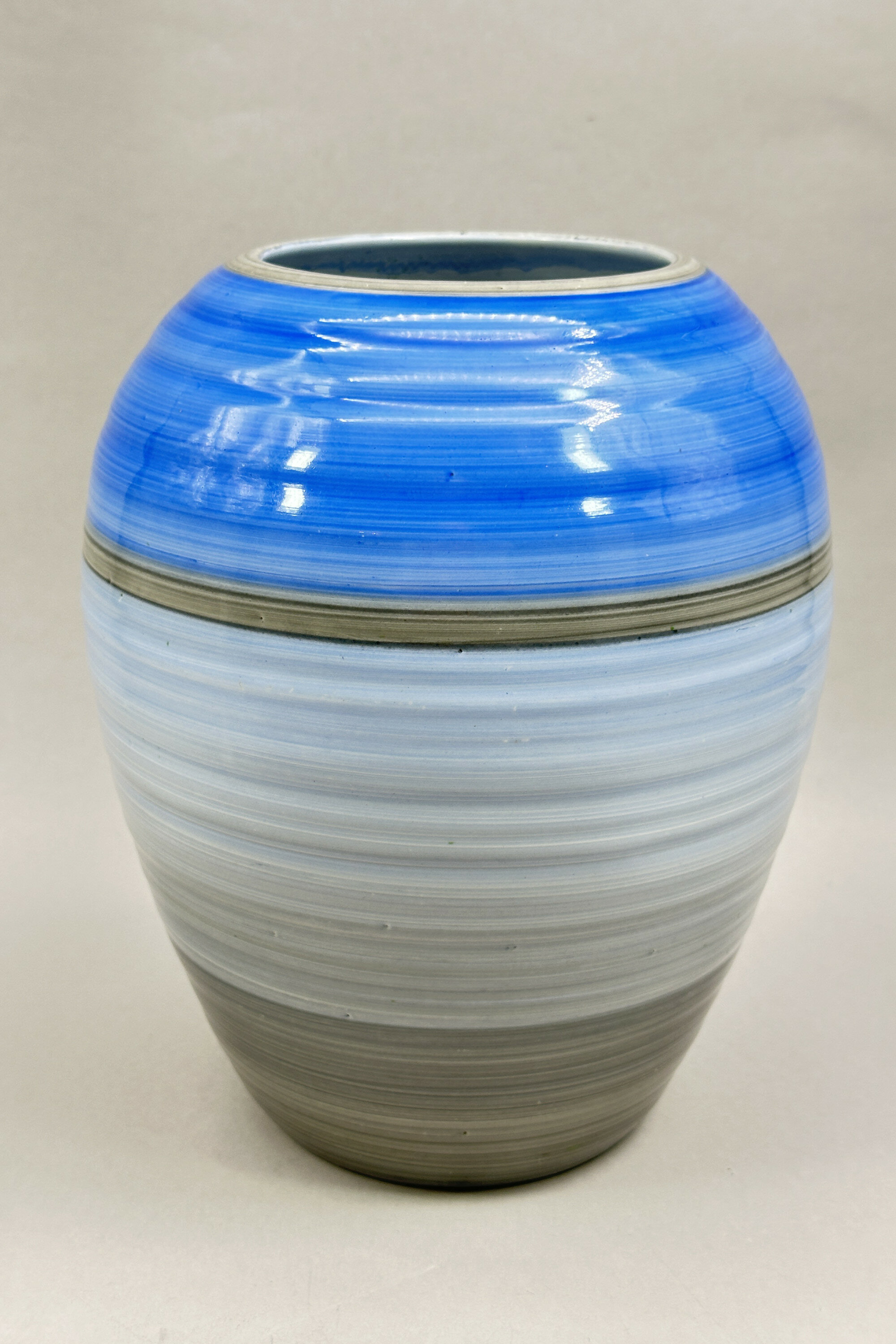
Large Shelley Harmony Ware Vase glazed in blue and grey, 1930s
Price: £75Shelley Potteries, situated in Staffordshire, was originally known as Wileman & Co. which had also traded under the name ‘The Foley Potteries’. The first Shelley to join the company was Joseph Ball Shelley in 1862, and it remained a Shelley family business until 1966, when it was taken over by Allied English Potteries. Joseph’s son Percy employed first the designer Frederick Rhead then Walter Slater who had worked with Doulton. It was Walter Slater’s son, Eric, who initiated the ‘Harmony’ range in 1932, at first with a series of banded designs as here and then with drip ware patterns which became enormously popular. Harmony ware was produced in a wide variety of colours and shapes, the plain ovoid form being typical and reflecting the Art Deco styles of the period, but this example is exceptionally large with a more unusual range of colourings.
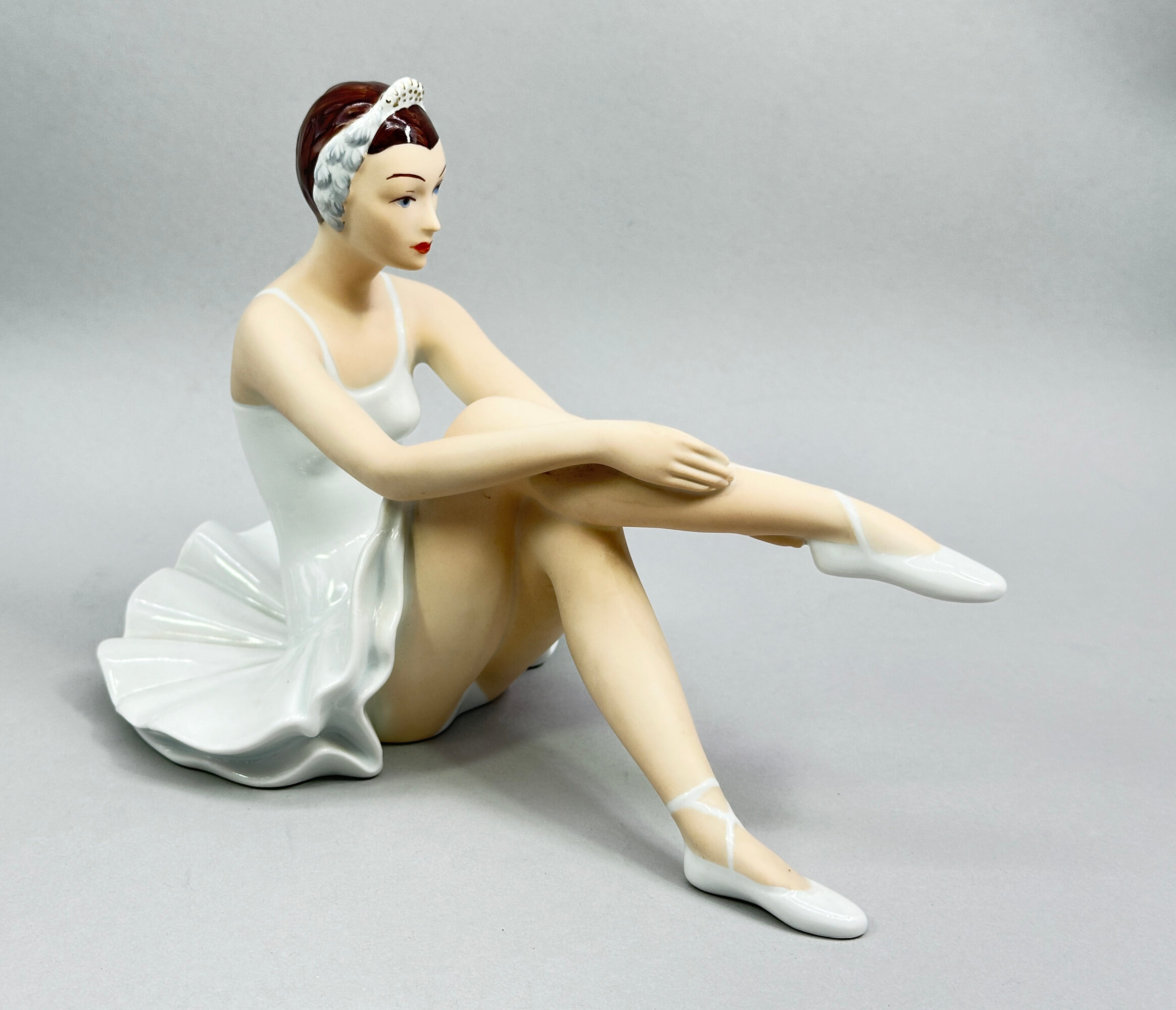
Figure of a Seated Ballerina, Royal Dux, late C20th
Price: £75Duxer Porzellanmanufaktur, or the Dux Porcelain Manufactory, was started in 1860 by Eduard Eichler in what was then Duchov, Bohemia, later to become part of Czechoslovakia. Production was to continue until the beginning of the second world war and beyond and their later pieces are now generally referred to by the abbreviated name, ‘Royal Dux’. The distinctive pink triangle plaque mark was first used in the late nineteenth century but appears on pieces from all dates, the version found here indicating late twentieth century work which is also confirmed by the rather indistinct stamped mark comprising a triangle surrounded by the wording ‘Hand Painted Made in Czech Republic’. The artist is named as ‘V.David’ and there seem to be two other companion pieces in different poses. The quality is quite excellent and explains the original popularity of the firm when it began manufacturing in the nineteenth century and produced highly successful imitations of its contemporary rivals.
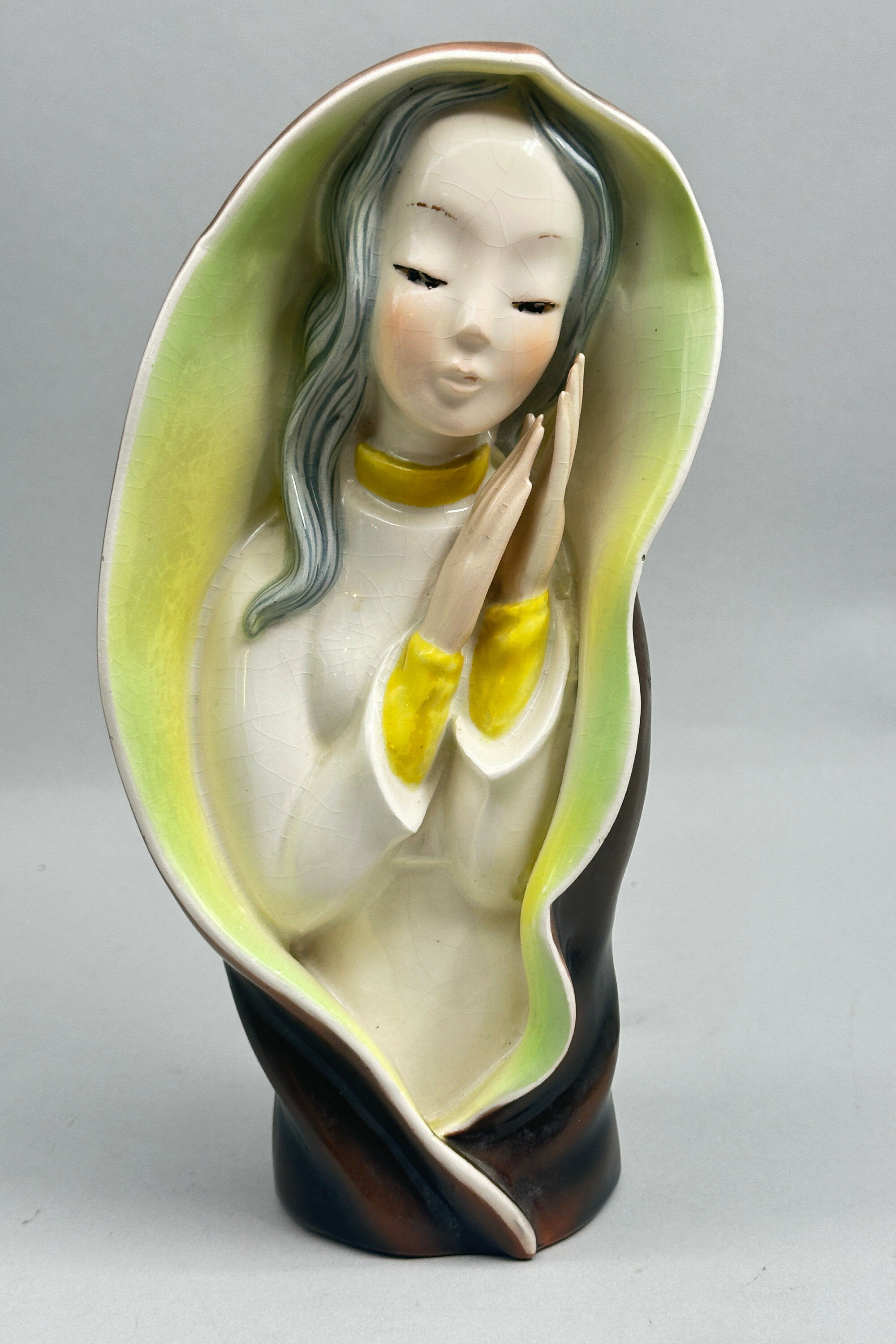
Figure of a Young Girl Praying, Continental, probably mid C20th
Price: £55